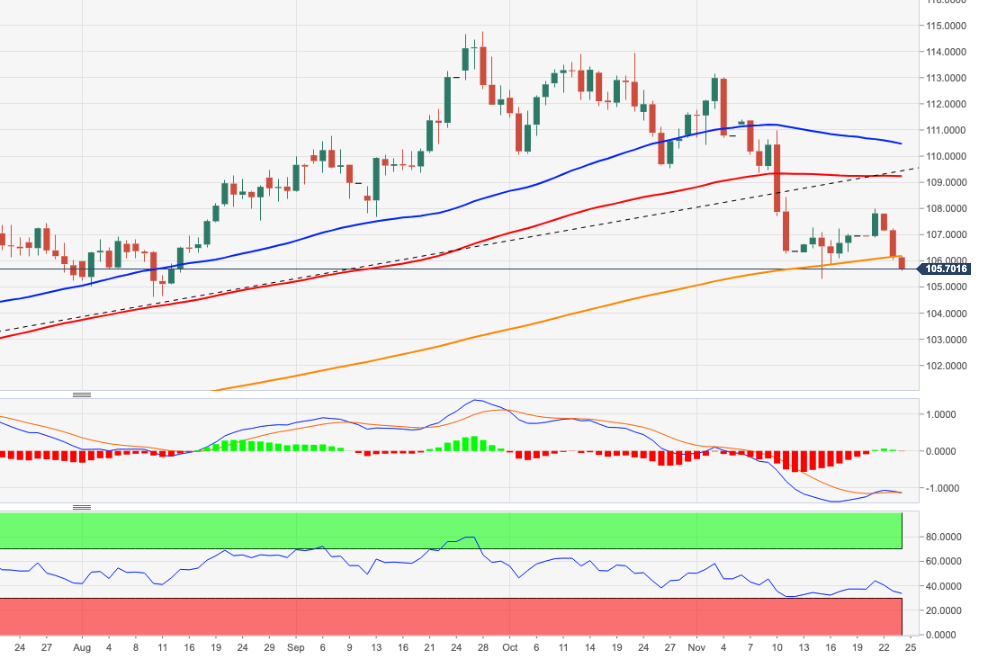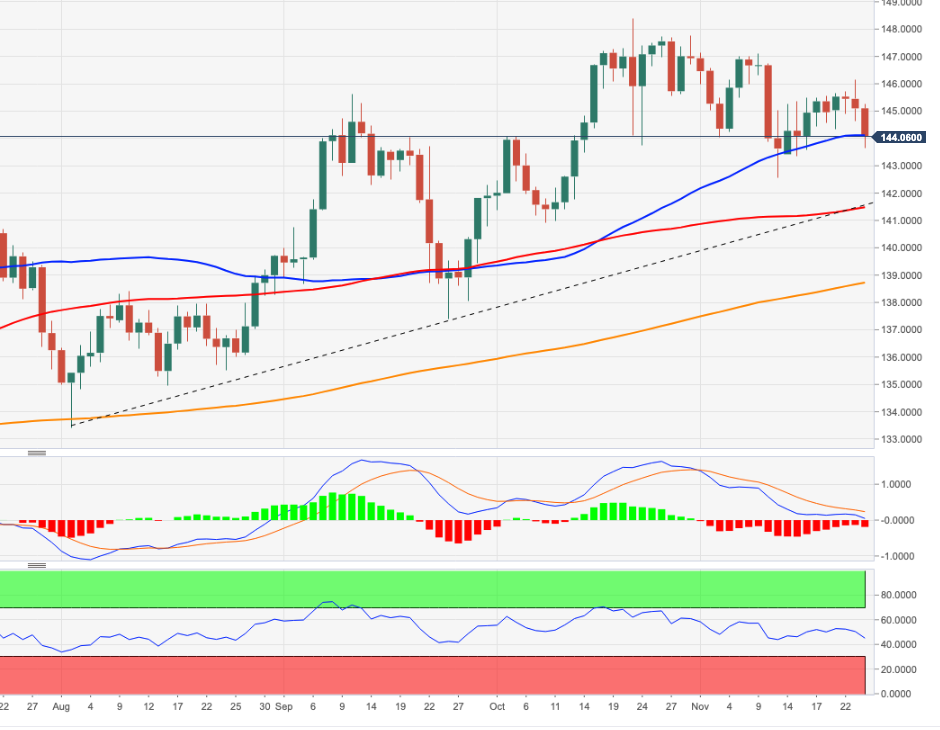- Analytics
- News and Tools
- Market News
CFD Markets News and Forecasts — 24-11-2022
- USD/CAD is struggling around the immediate hurdle of 1.3340 amid an absence of a potential trigger.
- The market mood has turned quiet as the United States economy is celebrating Thanksgiving Day.
- A decline in oil prices led by rising Covid-19 infections in China has impacted the Canadian Dollar.
The USD/CAD pair is displaying topsy-turvy moves just like another typical Friday session. The Lonnie asset is struggling around 1.3340 after witnessing a recovery move from below 1.3320. A bullish reversal cannot be claimed yet as it passes through various filters. No doubt, the trading activity is low on account of Thanksgiving Day but the market mood is still solid.
The USD Index (DXY) is auctioning like a dead cat amid the unavailability of any potential trigger ahead due to the light economic calendar. However, the hangover of less-hawkish commentary from Federal Open Market Committee (FOMC) minutes will continue to impact US Dollar ahead. Meanwhile, the 10-year US Treasury yields have dropped below 3.69%.
The long-term US yields are expected to remain on the tenterhooks as the Federal Reserve (Fed) is expected to shift to a lower interest rate hike for its December monetary policy meeting. Commentary from Fed policymakers as per FOMC minutes indicate that financial risks in the United States economy are accelerating led by extreme policy tightening.
Therefore, a slowdown in the rate hike pace would reduce those risks and would also present an opportunity to observe the impact of efforts made by the Fed to bring down inflationary pressures.
On the Canadian Dollar front, investors are awaiting the release of the Gross Domestic Product (GDP) for the third quarter, which will release on Tuesday. On a quarterly basis, the GDP data is expected to decline to 0.4% from the prior release of 0.8%. This might be delightful for the Bank of Canada (BOC) as a slowdown in the economy is necessary to cool down the ultra-hot inflation.
Meanwhile, oil prices have stabilized around the critical hurdle of $78.00 after a perpendicular downfall. This doesn’t present a reversal situation but an inventory distribution that could lead to further weakness. Rising infections of Covid-19 in China have resulted in a significant decline in economic projections. It is worth noting that Canada is a leading exporter of oil to the United States and a decline in oil prices is impacting the Canadian Dollar.
- Bears are lurking at 1.2150/00 on the daily chart.
- A correction eyes to 1.1959 and then the trendline support.
GBP/USD continued to climb on Thursday and reached the 1.2150s before moving lower into a consolidating during Thanksgiving where liquidity is thinner than usual. The US Dollar continues to extend its losses on Thursday after the minutes from the Federal Reserve's November meeting supported the view that the central bank would downshift and raise rates in smaller steps from its December meeting.
The minutes of the Nov. 1-2 meeting showed officials were largely satisfied they could now move in smaller steps, with a 50 basis point rate rise likely next month after four consecutive 75 basis point increases. In other key statements, the minutes showed that a slower pace of rate hikes would better allow the FOMC to assess progress toward its goals given the uncertain lags around monetary policy. A few participants said slowing the pace of rate hikes could reduce the financial system risks; others that slowing should await more progress on inflation.
The dollar index DXY, which measures the greenback against six major peers, was down 0.2% at 105.87, after sliding 1.1% on Wednesday. As Reuters noted, ''the Fed has taken interest rates to levels not seen since 2008 but slightly cooler-than-expected US consumer price data has stoked expectations of a more moderate pace of hikes.'' Consequently, the US Dollar index slide 5.2% in November, putting it on track for its worst monthly performance in 12 years.
Meanwhile, it is potentially going to be a quiet end to the week with a vacant calendar and half-day markets on Wall Street. This leaves the focus on busier times ahead. Net short GBP speculators’ positions fell back for a third consecutive week as the UK's fundamentals remain sour. A hefty 75 bps rate hike from the BoE this month failed to support the pound in the spot market, given the Bank’s gloomy UK economic forecasts and that sentiment is likely here to stay. A reversal in the US Dollar could be harmful to the pound and a potentially over-prescribed long in the spot market.
GBP/USD technical analysis
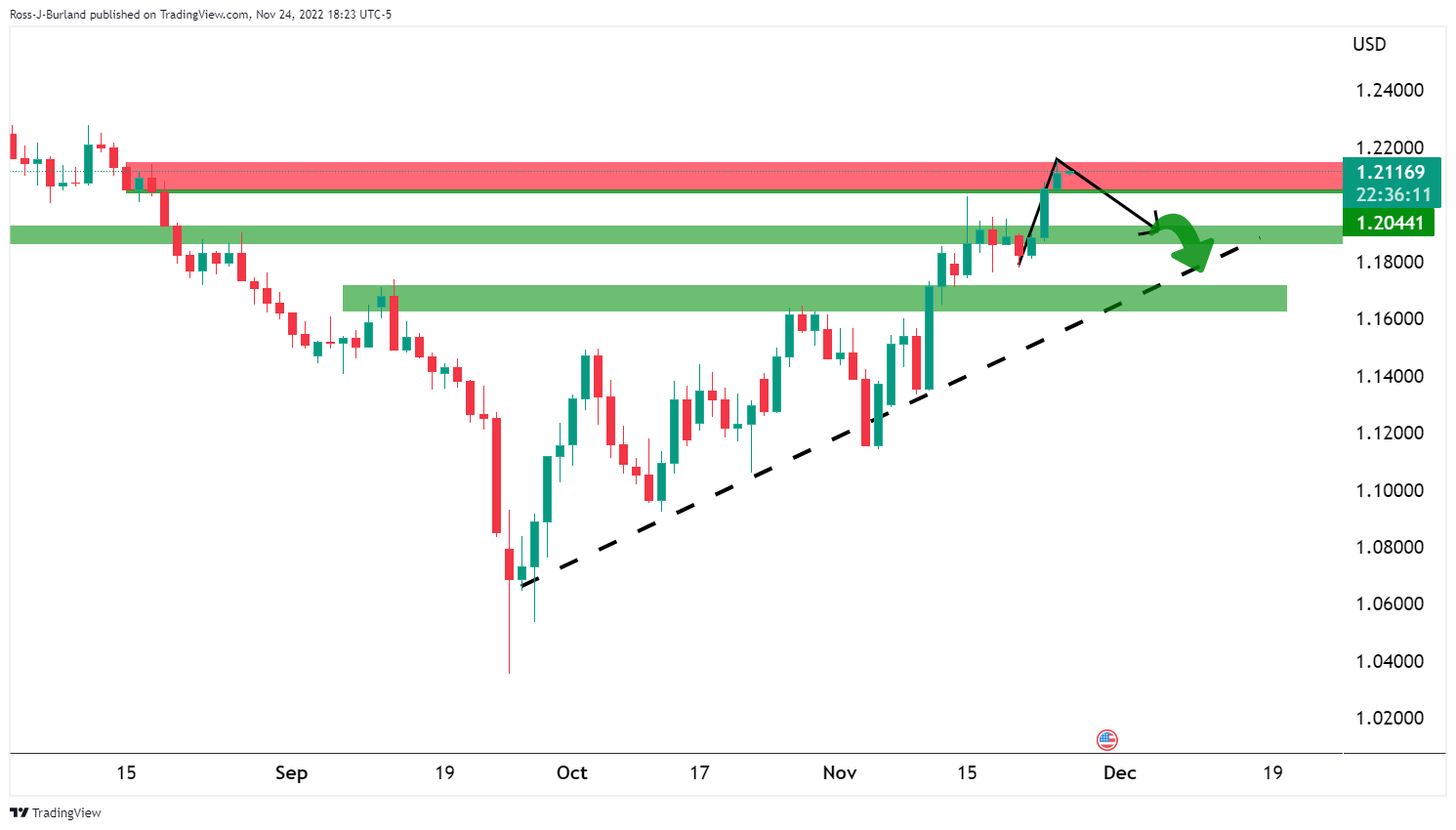
Bears are lurking at 1.2150/00 on the daily chart and there are prospects of a correction if the resistance holds over the coming days with eyes to 1.1959 and then the trendline support.
- The EUR/JPY rises as the Asian session begins after losing 0.53% on Thursday.
- EUR/JPY Price Analysis: After breaking below the rising wedge, a fall toward 142.50s is on the cards.
The Euro (EUR) fell sharply against the Japanese Yen (JPY), on Thursday, amidst an improved market sentiment, which usually benefits the shared currency. However, traders seeking safety bolstered the latter, sending the EUR/JPY sliding toward the 50-day Exponential Moving Average (EMA) around 144.15. At the time of writing, the EUR/JPY is trading at 144.19, below its opening price by 0.08%.
EUR/JPY Price Analysis: Technical outlook
From a daily chart perspective, the EUR/JPY remains neutral-to-upward biased. However, it should be noted that the rising wedge formed in the EUR/JPY chart was broken on Thursday, which could exacerbate a fall toward the November 11 daily low at 142.54. Another factor to consider is the Relative Strength Index (RSI) turned bearish; hence the EUR/JPY path of least resistance is downward biased.
The EUR/JPY first support would be the 50-day Exponential Moving Average (EMA) at 144.15. A breach of the latter will expose the 144.00 figure, followed by the November 15 daily low at 143.35, ahead of the 142.54 targets. As an alternate scenario, the EUR/JPY first resistance would be the 145.00 mark, which, once cleared, will expose the 146.00 figure. Break above will send the EUR/JPY climbing towards the November 9 swing high at 147.11.
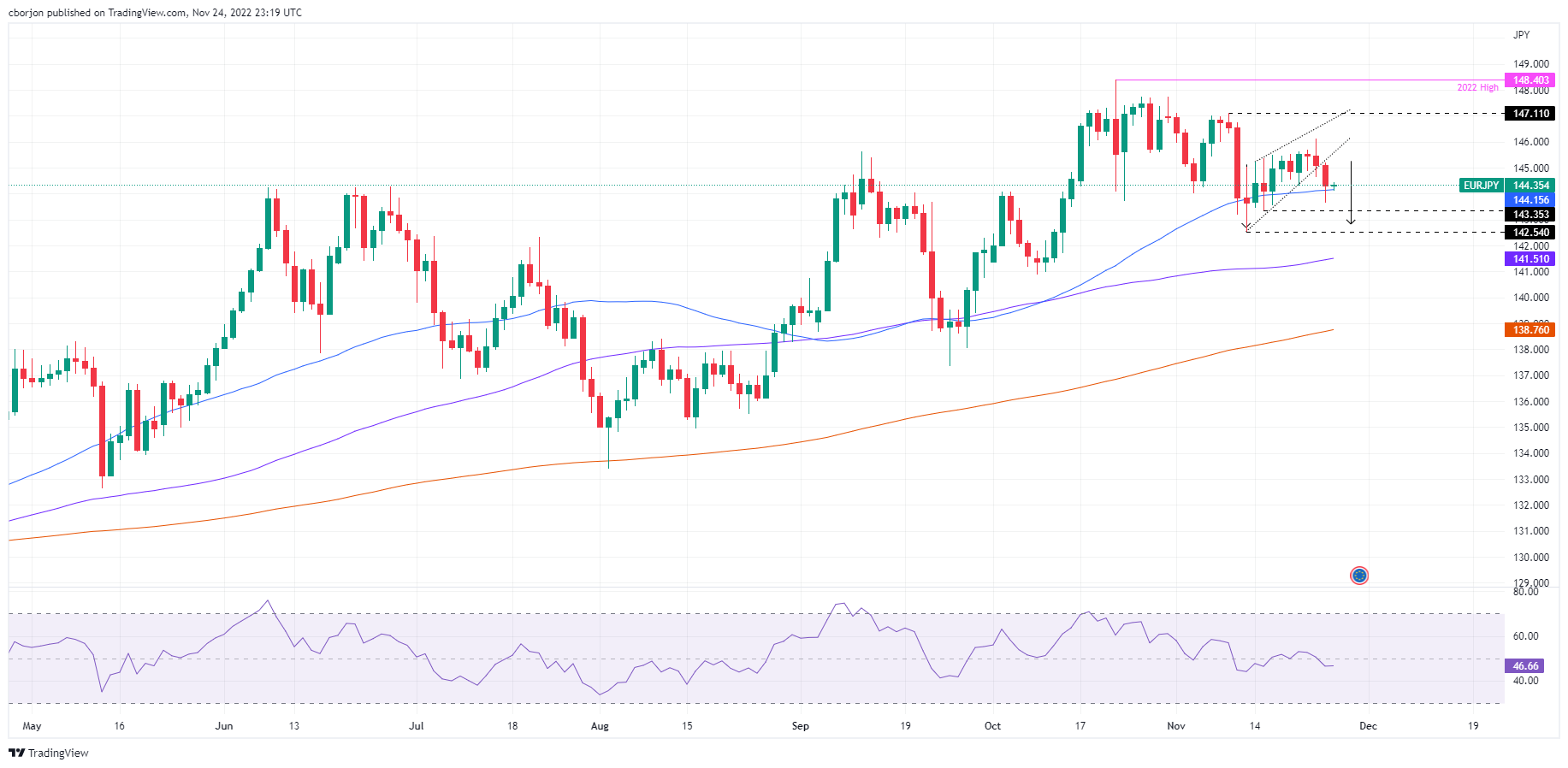
EUR/JPY Key Technical Levels
- Quiet market mood on account of Thanksgiving Day has turned the Aussie asset sideways.
- An establishment of the AUD/USD pair above 0.6700 has strengthened the Australian Dollar.
- The 200-EMA at 0.6847 is expected to be smashed by the major sooner.
The AUD/USD pair is displaying back-and-forth moves in a 10-pips range in the early Asian session. The Aussie asset has turned sideways after printing a fresh weekly high at 0.6778 amid a quiet market mood on account of Thanksgiving Day.
Meanwhile, the USD Index (DXY) is still in the hangover of ‘less-hawkish’ cues from the Federal Open Market Committee (FOMC) minutes. The US Dollar is hovering below the critical hurdle of 106.00 amid the risk appetite theme.
On a daily scale, the Aussie asset has confidently established above the horizontal support plotted near July 14 low around 0.6700. The next hurdle for the Aussie asset is the 200-period Exponential Moving Average (EMA) at 0.6847, which has remained a major ceiling.
The 20-period EMA at 0.6616 is scaling higher, which adds to the upside filters.
Meanwhile, the Relative Strength Index (RSI) (14) is focusing on shifting into the bullish range of 60.00-80.00, which will trigger a bullish momentum.
Going forward, a break above Thursday’s high at 0.6778 will extend the three-day winning streak, which will drive the asset toward the round-level resistance at 0.6800, followed by the 200-EMA at 0.6847.
On the flip side, the Australian Dollar could lose strength if the Aussie asset drops below Monday’s low at 0.6585. This will drag the major towards October 4 high at 0.6548 and November 2 high at 0.6493.
AUD/USD hourly chart
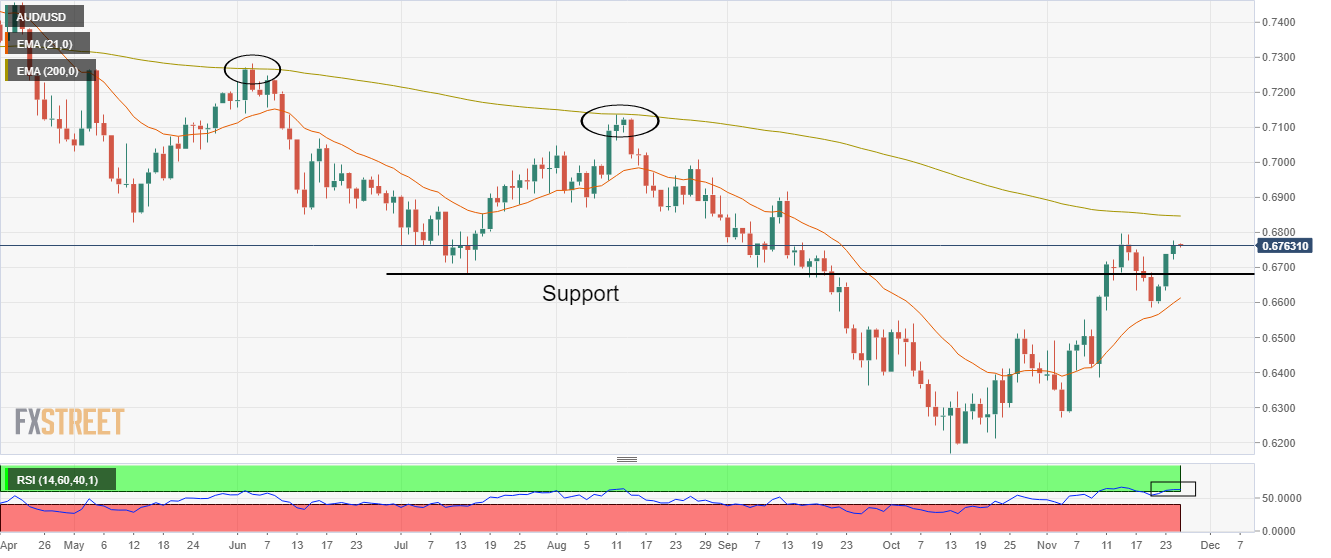
- Gold price is marching towards $1,760.00 as Fed is set to ditch the 75 bps rate hike regime.
- The US Dollar is prone to decline toward a three-month low at 105.34 amid an upbeat market mood.
- Economists at ANZ Bank consider the Gold rally an exaggerated one as the inflation rate is well above 2% target.
Gold price (XAU/USD) has attempted a recovery after declining to near $1,754.00 in the early Tokyo session. The precious metal remained sideways on Thursday due to less volume as United States markets were closed on account of Thanksgiving Day. Considering the optimism in the overall market, the gold price is expected to continue its upside journey toward the crucial hurdle of $1,760.00.
The USD index (DXY) displayed back-and-forth moves below the round-level resistance of 106.00. The US Dollar is prone to test a three-month low at 105.34 as the Federal Reserve (Fed) is set to ditch the bigger rate hike culture in its December monetary policy meeting. Meanwhile, S&P500 futures added some gains in the holiday session amid an upbeat market mood.
The Federal Open Market Committee (FOMC) minutes have cleared that the majority of Fed policymakers are in favor of decelerating the current interest rate hike pace. This may keep gold prices in a comfort zone. However, ANZ Bank shares a contrary opinion on the same. They believe that softer-than-expected US inflation triggered a sell-off in the US Dollar, helping Gold prices to recover. That is unlikely to last as inflation at 7.7% is well above the central bank’s target of 2%. “It is not enough for the Fed to be confident that inflation is on track to move back to 2% sustainably.
Gold technical analysis
On an hourly scale, Gold price has displayed a steep recovery after testing the 38.2% Fibonacci retracement (plotted from November 3 low at $1,616.69 to November 15 high at $1,758.88) at $1,722.00. The precious metal is looking for support around the 20-period Exponential Moving Average (EMA) at $1,754.65.
Meanwhile, the Relative Strength Index (RSI) (14) is declining into the 40.00-60.00 range, which indicates that Gold price is losing bullish momentum. However, it doesn’t claim a bearish reversal.
Gold hourly chart
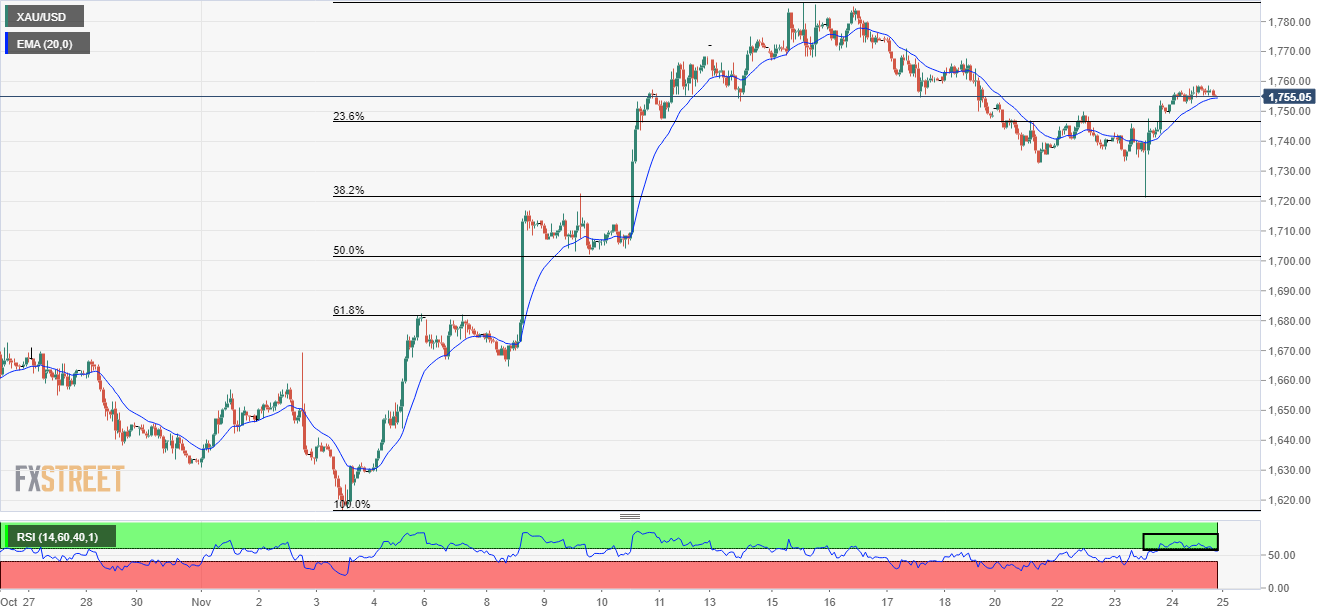
- The Australian Dollar registers decent losses vs. the Japanese Yen amidst an upbeat sentiment.
- The lack of catalyst and price action trapped within 93.00-94.00 keeps the AUD/JPY sideways.
- AUD/JPY Price Analysis: RSI’s turning bearish could open the door for a fall to 93.00.
The Australian Dollar (AUD) edges lower against the Japanese Yen (JPY) after traveling throughout the day within the 94.00-93.11 range on Thursday, hoovering below the 50 and 100-day Exponential Moving Averages (EMAs). As the Asian Pacific session begins, the AUD/JPY is trading at 93.70, below its opening price by 0.20%.
AUD/JPY Price Analysis: Technical outlook
The AUD/JPY daily chart portrays the cross, consolidated within the 93.00-94.00 range, for the last six days. Even though the 50 and 100-day Exponential Moving Averages (EMAs) around 93.87 and 94.28, respectively, above the spot price, suggest the cross is downward biased, a flat slope confirms a neutral bias.
Short term, the AUD/JPY 1-hour chart portrays the 50, 100, and 200-EMAs seesawing around the price action. On Thursday, the AUD/JPY dived sharply below the Exponential Moving Averages (EMAs), opening the door for lower prices. Investors should be aware that the Relative Strength Index (RSI) crossed below the 50-midline to bearish territory, showing that sellers are gathering momentum.
Therefore, the AUD/JPY first support would be the daily pivot point at 93.63. The break below will expose the S1 daily pivot at 93.25, followed by this week’s low at 93.11. In the event of breaking upwards, the AUD/JPY first resistance would be the 200-EMA at 93.84, which, once cleared, would expose the 94.00 figure.

AUD/JPY Key Technical Levels
- NZD/USD has sensed a marginal selling pressure as NZ Retail Sales have dropped to 0.4% vs. 0.5% as projected.
- NZ Retail Sales has landed higher against its prior release but might not delight RBNZ policymakers.
- The RBNZ sees interest rates peaking around 5.5% by September 2023.
The NZD/USD pair has shown a marginal impact of a decline in New Zealand Retail Sales data against the consensus. The Kiwi asset has slipped below 0.6260 after auctioning sideways in the early Tokyo session. The NZ Retail Sales data for the third quarter has landed at 0.4% vs. the expectations of 0.5% but has remained significantly higher than the prior release of -2.3%.
A positive Retail Sales figure might be supportive of the New Zealand Dollar but won’t delight the Reserve Bank of New Zealand (RBNZ). The central bank is putting its blood and sweat to curtail inflationary pressures. The price rise index displayed a historic surge in the third quarter and a decline in consumer demand could bring a slowdown in inflation.
A rise in Retail Sales is not going to incentivize manufacturers and service providers to look for a halt in price growth or a decline. This may put more pressure on RBNZ Governor Adrian Orr to continue with extremely restrictive policy measures.
This week, the RBNZ hiked its Official Cash Rate (OCR) by 75 basis points (bps). Earlier, the central bank was hiking its OCR by a 50 bps rate. This has pushed its OCR to 4.25%. As price pressures have not displayed any sign of exhaustion nor a peak has been found yet, the regime of an ‘extreme hawkish’ stance will continue further. Also, the RBNZ has provided a peak for interest rates at 5.5% by September 2023.
Meanwhile, the US dollar index (DXY) is displaying a sideways performance as trading activity remained light on Thursday due to the holiday on account of Thanksgiving Day. The risk profile is still positive and has not displayed signs of caution yet.
The quarterly release of Retail Sales has been released as follows:
- New Zealand Q3 s/adj real retail sales +0.4 pct Q/Q.
- New Zealand Q3 s/adj actual retail sales +4.9 pct YoY.
New Zealand retail sales volumes rose a seasonally adjusted 0.4 percent in the third quarter, data from Statistics New Zealand showed on Friday, putting sales 4.9 percent higher on the year.
NZD/USD remains stagnant at 0.6265 in thin holiday trade at the start of the Asian session.
''As we have stated in recent days, we do think higher interest rates and the RBNZ’s hawkish stance are, on balance, a positive for the Kiwi, but newspapers are awash with recession talk, and that of course brings with it the risk that negative sentiment starts to feed on itself,'' analysts at ANZ Bank explained.
''The big global uncertainty is; how does the USD treat the prospect of the Fed slowing down the pace of hikes, but potentially higher terminal rate? Does that feed bearish sentiment, or help USD carry? So there is still uncertainty.''
About New Zealand Retail Sales
The quarterly release of Retail Sales by the Statistics New Zealand directly reflects on the country’s consumer spending. Stronger sales could drive inflation higher, leading the Reserve Bank of New Zealand (RBNZ) to hike interest rates so as to maintain its inflation-containment mandate. Thus, the indicator impacts the New Zealand dollar significantly. A better-than-expected print tends to be NZD bullish. The data is published about a month and a half after the quarter ends.
- NZD/USD bears could be about to make their moves.
- Bulls eye a run to test 0.6300 while above 0.6250.
As per the prior analysis, NZD/USD Price Analysis: The Bird is in full flight, whereby the bulls were creeping higher in Asian trade despite the ground it had already made since the central bank events in the week, fresh highs were made as follows:
NZD/USD prior analysis
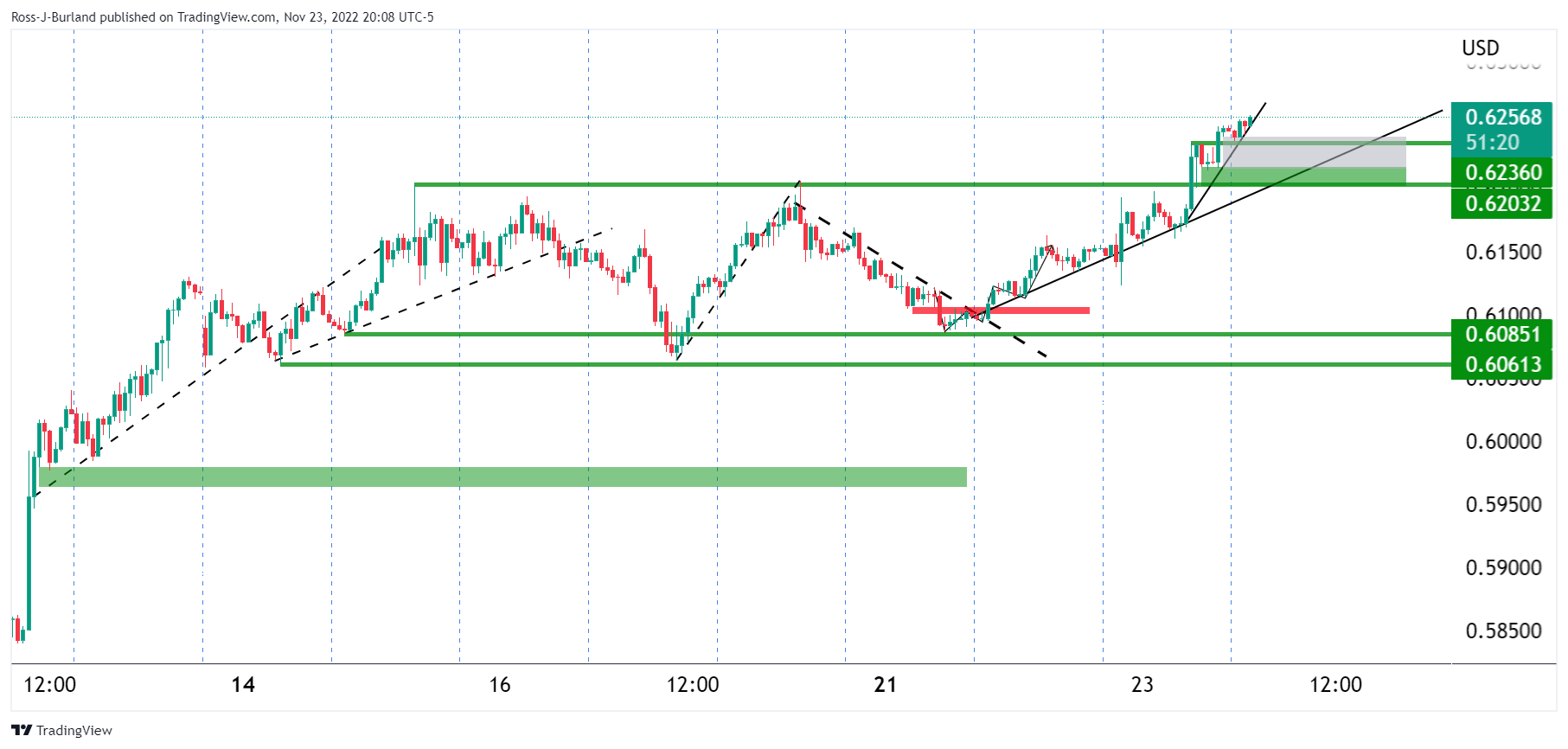
NZD/USD update
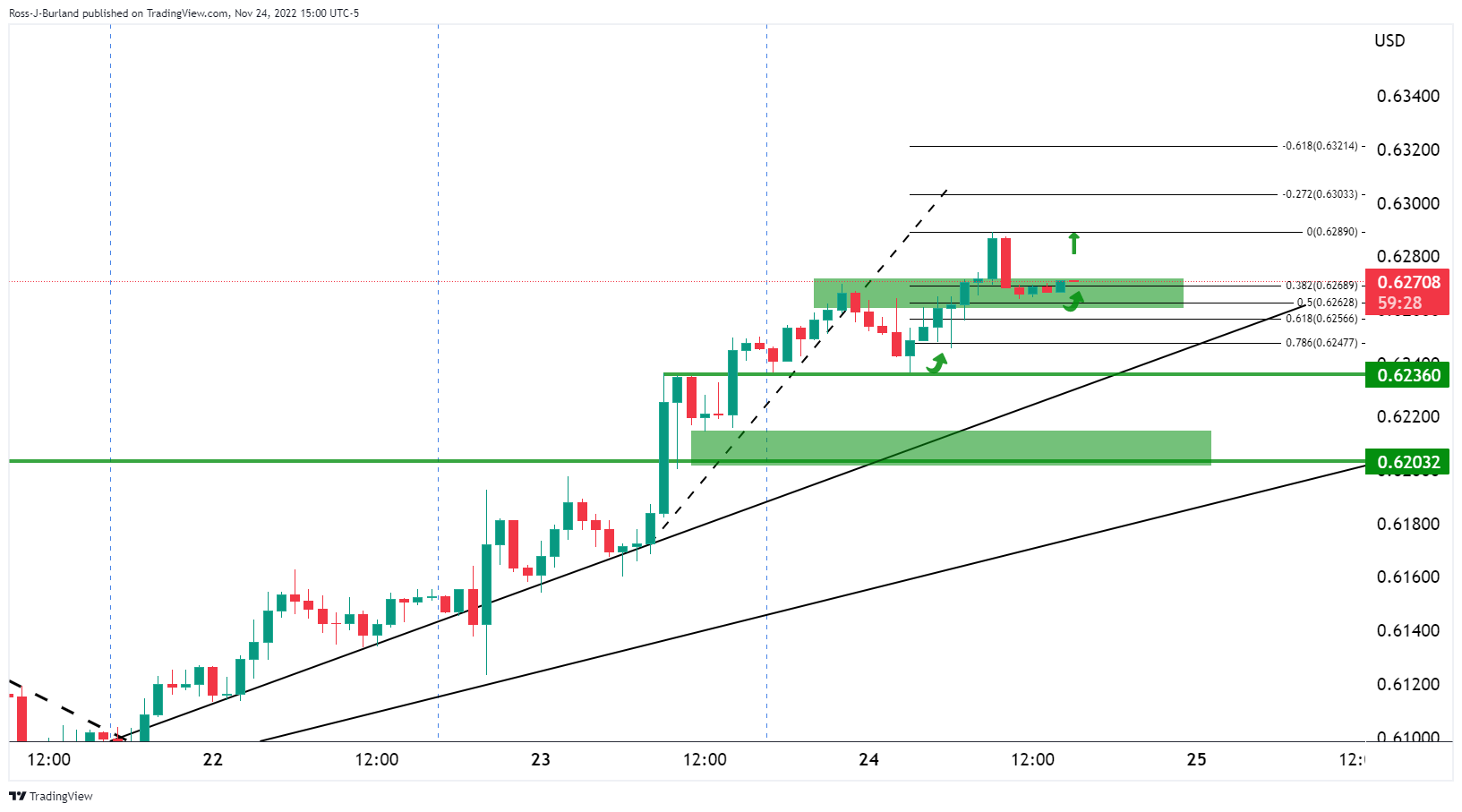
While the trendline broke, the support held and the price moved higher. At this juncture, the bulls need to commit in the upper quarter of the 0.62 area. However, the tweezer top is a bearish candle stick combination pattern that shows sellers are in the market.
The price is now testing the next trendline support a break there opens the risk of a move to the downside to test below 0.6250 and with eyes on 0.6236 prior lows and trendline before 0.6200:
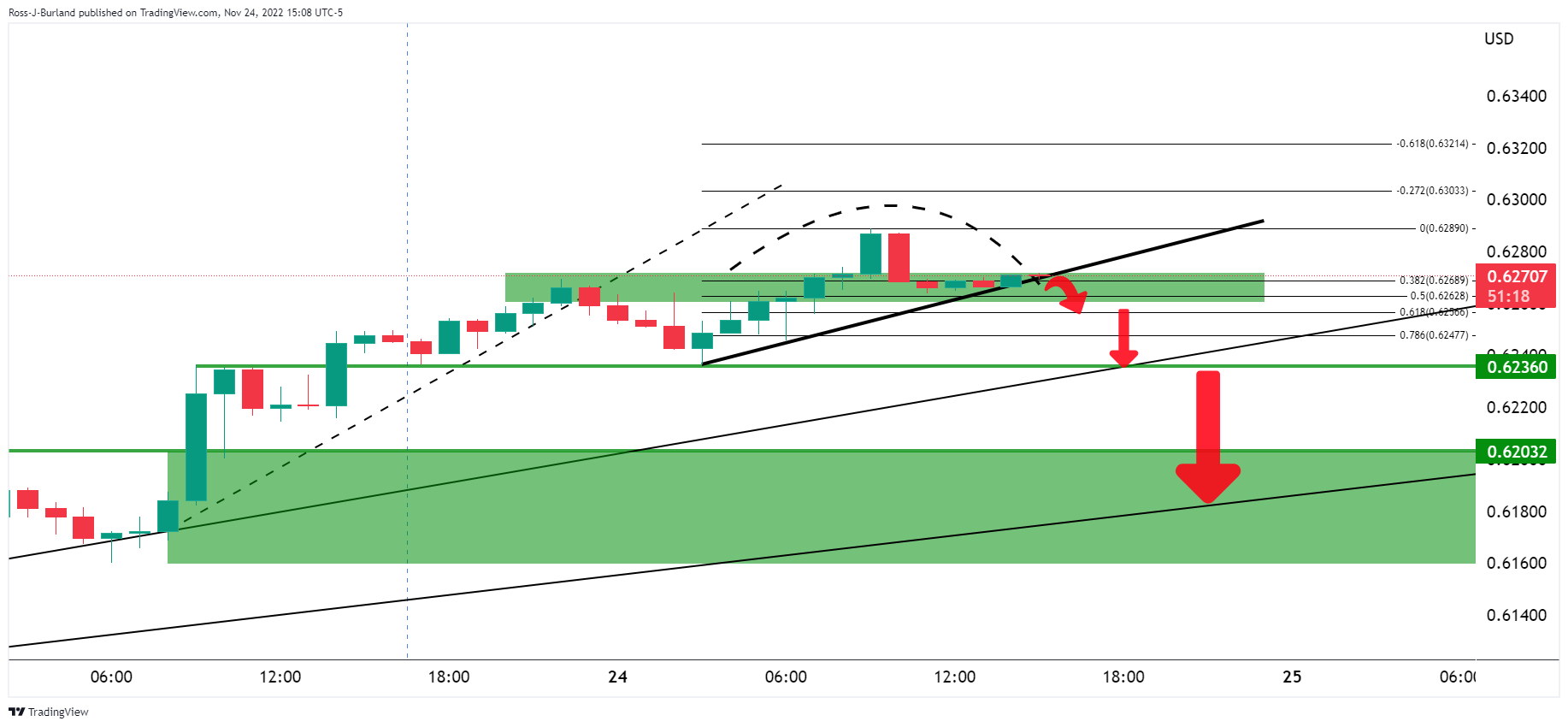
With that being said, it would be unusual for the market to simply melt without a revisit to the peak formation as distribution takes a while to play out, usually as per the following topping scenario on the 15-minute chart:
NZD/USD M15 chart

- The US Dollar remains offered, except against the Swiss Franc, as the USD/CHF rises.
- USD/CHF: A daily close above 0.9425 will pave the way toward a 0.9500 test.
The US Dollar (USD) stages a mild recovery against the Swiss Franc (CHF) following the release of the Federal Reserve (Fed) November meeting minutes, which showed policymakers’ desire to moderate interest-rate increases. Therefore, the USD/CHF tanked on Wednesday, but the story differed on Thursday. At the time of writing, the USD/CHF is trading at 0.9434 after traveling from its daily low of 0.9387.
USD/CHF Price Analysis: Technical outlook
The USD/CHF daily chart depicts Thursday’s price action forming a hammer, a candlestick that appears as a reversal pattern. Nevertheless, as with most technical analysis tools, that’s just one piece of the puzzle, as it will need further confirmation from Friday. The Relative Strength Index (RSI) shows sellers are in charge, but its slope aims upward, signaling that they might be losing momentum. If the USD/CHF achieves a daily close above Wednesday’s 0.9425, that could open the door for a re-test of 0.9500. Otherwise, sellers outweigh buyers could pressure the major towards 0.9400 before testing the November low at 0.9356.
In the near term, the USD/CHF 4-hour chart portrays the major as downward biased once it cleared an upslope trendline on November 22, exacerbating a drop below 0.9500. On its way toward a new weekly low below 0.9400, the USD/CHF surpassed the 50-Exponential Moving Average (EMA) alongside the daily pivot point at 0.9460. However, the USD/CHF S1 daily pivot at 0.9381 probed rigid support to break, and the major climbed back above 0.9400 toward the current spot price.
Therefore, the USD/CHF first resistance would be the daily pivot at 0.9460, followed by the 50-EMA at 0.9484, ahead of the psychological 0.9500 mark. As an alternative scenario, the USD/CHF first support would be 0.9400, followed by the S1 pivot level at 0.9381, ahead of November’s low at 0.9356.
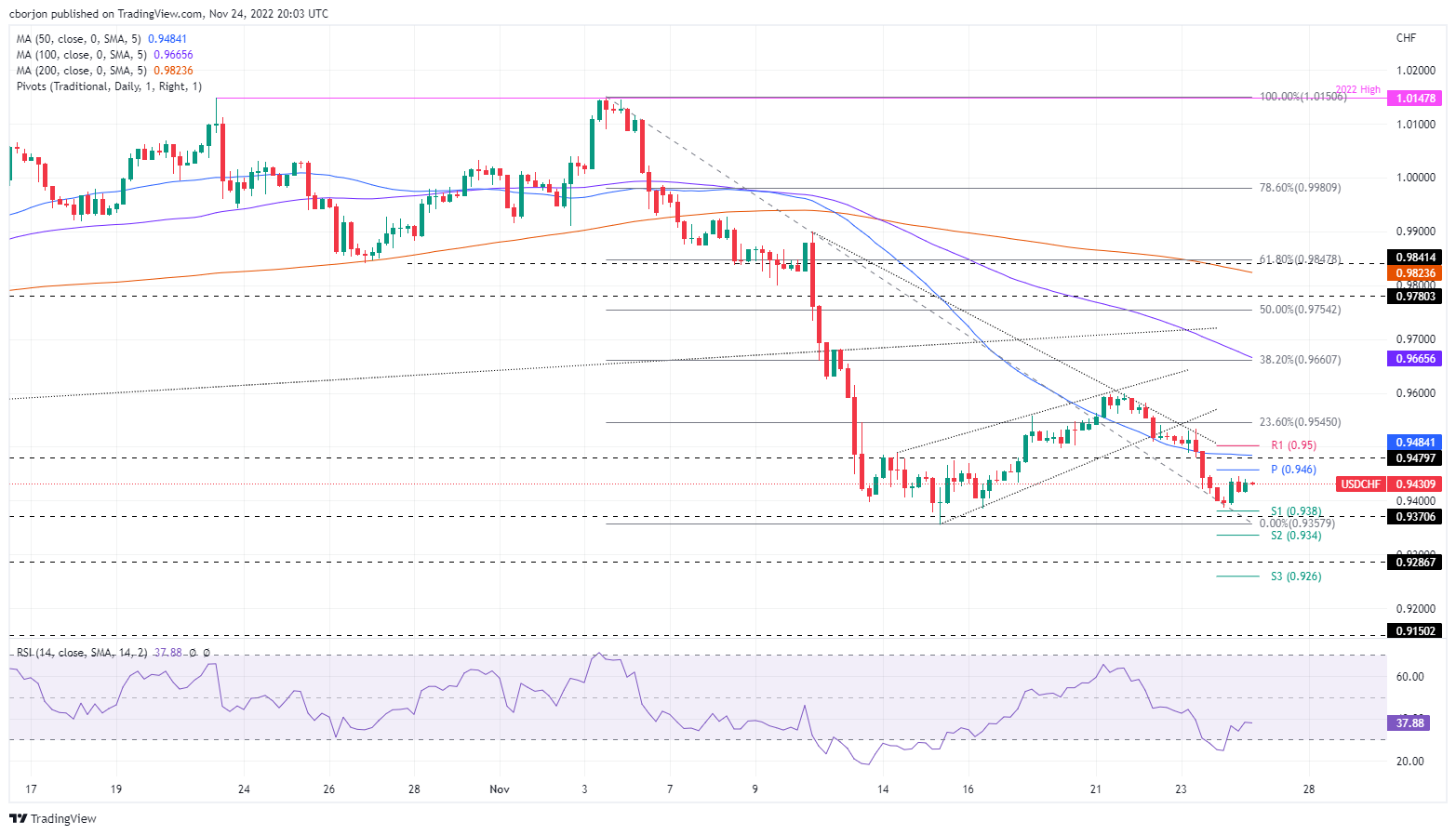
USD/CHF Key Technical Levels
What you need to take care of on Friday, November 25:
The greenback extended its weekly decline on Thursday, settling near its lows against most of its major rivals. Activity pared after London’s close, as US markets were closed due to the Thanksgiving holiday.
Generally speaking, the mood was upbeat as Asian and European indexes closed in the green. However, some worrisome headlines may soon trigger a flip in investors’ sentiment. On the one hand, tensions between Russia and the EU continue and are on their way to escalate, as European Commission President Ursula von der Leyen announced they are working full speed on a 9th sanctions package on Moscow.
On the other hand, China reported record coronavirus contagions in the country, while a state-run news channel reported that Beijing and other cities are going back into lockdown. Financial markets may turn risk-averse on renewed concerns that Chinese restrictions could interrupt global commerce, trigger fresh supply-chain issues, and result in another inflationary spiral.
EUR/USD hovers around 1.0400, while GBP/USD trades in the 1.2110 price zone. AUD/USD extended its weekly rally and stands at around 0.6760, while USD/CAD eased to the 1.3330 price zone. Finally, USD/JPY edged south and trades at around 138.40.
Spot gold consolidates around $1,755 a troy ounce, and WTI settled at $78 a barrel.
Like this article? Help us with some feedback by answering this survey:
- US Dollar weakened across the board on dovish-tilted Federal Reserve minutes.
- Mixed economic data from the United States keeps the US Dollar pressured.
- XAG/USD Price Analysis: Remains upward after conquering the 200-DMA, eyeing $22.00.
Silver price retraces after hitting a weekly high of $21.67, after climbing sharply on Wednesday, following the release of the Federal Reserve’s (FED) November meeting minutes, which weakened the US Dollar (USD). Also, factors like China’s Covid-19 crisis failed to trigger a flight to safety into the white metal. Hence, the XAG/USD trades at $21.47 a troy ounce.
On Thursday, Wall Street is closed in observance of the Thanksgiving holiday. The last meeting minutes of the Federal Reserve showed that “A substantial majority of participants judged that a slowing in the pace of increase would likely soon be appropriate,” giving the green light to investors seeking riskier assets. However, caution is warranted, as policymakers expressed “uncertainty” about how high rates need to go after emphasizing that inflation in the United States (US) remains “too high.”
Regarding Wednesday’s US economic calendar, S&P Global PMIs witnessed most indices moving into contractionary territory, another headwind for the US Dollar, while the Initial Jobless Claims for the last week jumped above forecasts, signaling that the labor market is easing.
On the positive side, US Durable Good Orders for October surprisingly rose, while the University of Michigan (UoM) Consumer Sentiment for November portrayed Americans are optimistic about the economy. The University of Michigan poll updated inflation expectations, with one-year ticking down to 5%, while for a 5-10 year horizon, were unchanged at 3%.
Back to price action, the US Dollar Index (DXY), a gauge of the buck’s value vs. its peers, drops by 0.21% at 105.875, extending its losses to three days. US Treasury yields, mainly the 10-year benchmark, followed suit, falling three bps at 3.663%.
Silver Price Forecast (XAG/USD): Technical outlook
Albeit Silver price retreated from weekly highs, it remains above the trendsetter 200-day Exponential Moving Average (EMA) at $21.37, sought as support by the white metal buyers. The XAG/USD bias remains upwards, and it could resume its uptrend if buyers reclaim $22.00. if that scenario plays out, the XAG/USD following resistance would be November 15 high at $22.24, followed by the June 6 high at $22.51. Otherwise, the XAG/USD first support would be the 200-day EMA at $21.37, followed by the psychological $21.00 mark.

- This could be the Euro's final attempt while below 1.0450.
- A breach there, however, opens the risk of a move into the support quarter of the 1.04 area.
- A break of 1.0500 could be significant bullish development with the risk of a move to 1.0600.
EUR/USD was last up 0.1% at 1.0405, and has stuck to a range of between 1.0381 and 1.0448 while US markets are closed on Thursday for Thanksgiving and liquidity will likely be thinner than usual until Asia and Frankfurt crossover on Friday.
The euro held onto gains after the minutes of the European Central Bank's October meeting showed policymakers feared that inflation may be getting entrenched. This leaves the divergence between the Federal Reserve and the ECB thinner and may favour an upside bias for the euro for the medium term. In this regard, The U. Dollar has extended losses on Thursday after the minutes from the Federal Reserve's November meeting supported the view that the Fed will start to relax the pace of rate hikes into smaller increments, starting as soon as the next meeting in mid-December.
The minutes of the Nov. 1-2 meeting showed officials were largely satisfied they could now move in smaller steps, with a 50 basis point rate rise likely next month after four consecutive 75 basis point increases. In other key statements, the minutes showed that a slower pace of rate hikes would better allow the FOMC to assess progress toward its goals given the uncertain lags around monetary policy. A few participants said slowing the pace of rate hikes could reduce the financial system risks; others that slowing should await more progress on inflation.
The dollar index DXY, which measures the greenback against six major peers, was down 0.2% at 105.87, after sliding 1.1% on Wednesday. As Reuters noted, ''the Fed has taken interest rates to levels not seen since 2008 but slightly cooler-than-expected US consumer price data has stoked expectations of a more moderate pace of hikes.'' Consequently, the US Dollar index slide 5.2% in November, putting it on track for its worst monthly performance in 12 years.
Meanwhile, analysts at Rabobank are more pessimistic about the eurozone than what recent price action might otherwise say for the euro. ''The current economic outlook is more vulnerable given the impact of higher energy prices. By the ECB’s next policy meeting, Germany may already be in recession. As has been in the case in the UK in recent months, there is no guarantee that the EUR will respond favourably to higher rates if the economic backdrop appears grim. Although we see the risk of recession in the US next year, the outlook is not as severe as in Europe. ''
EUR/USD technical analysis
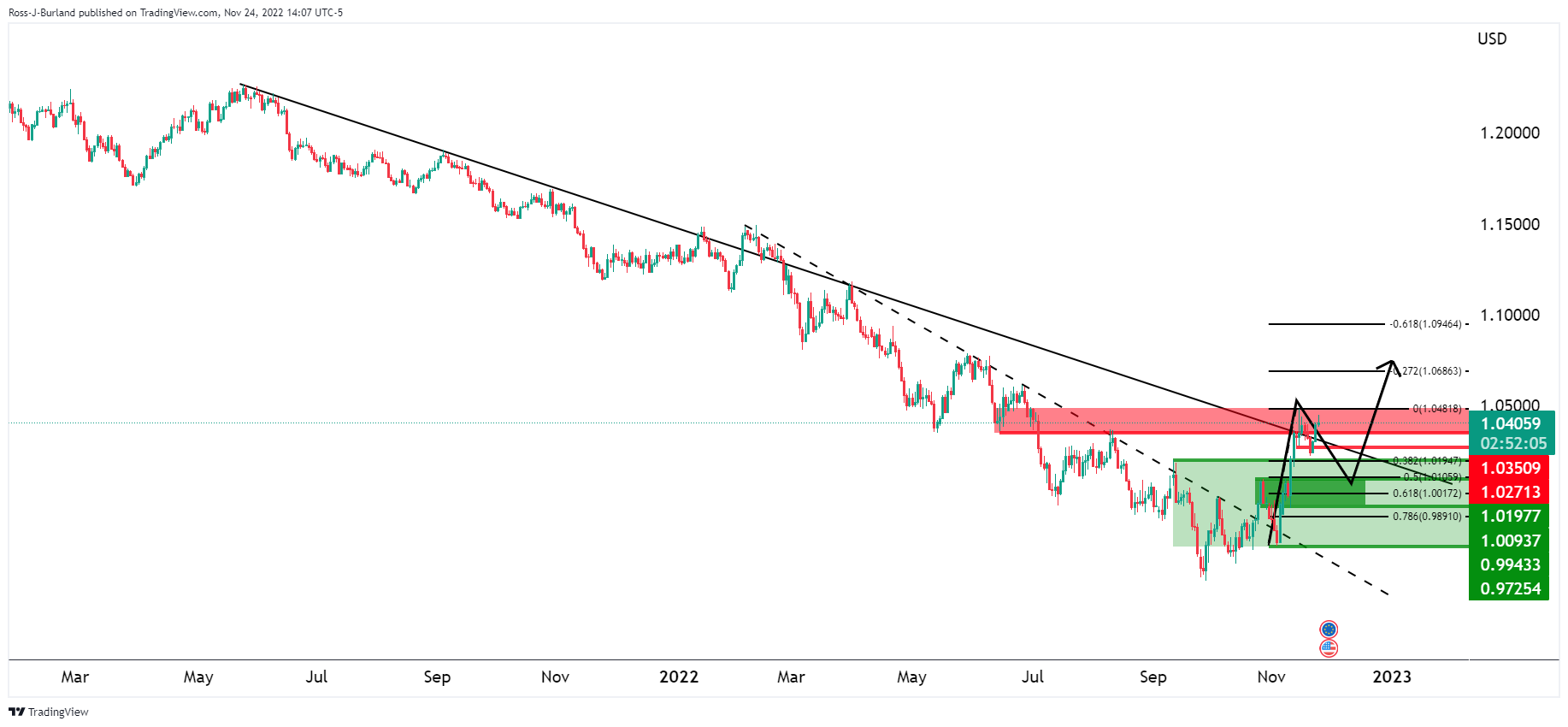
The euro is potentially topping out at this juncture, as per the daily chart.
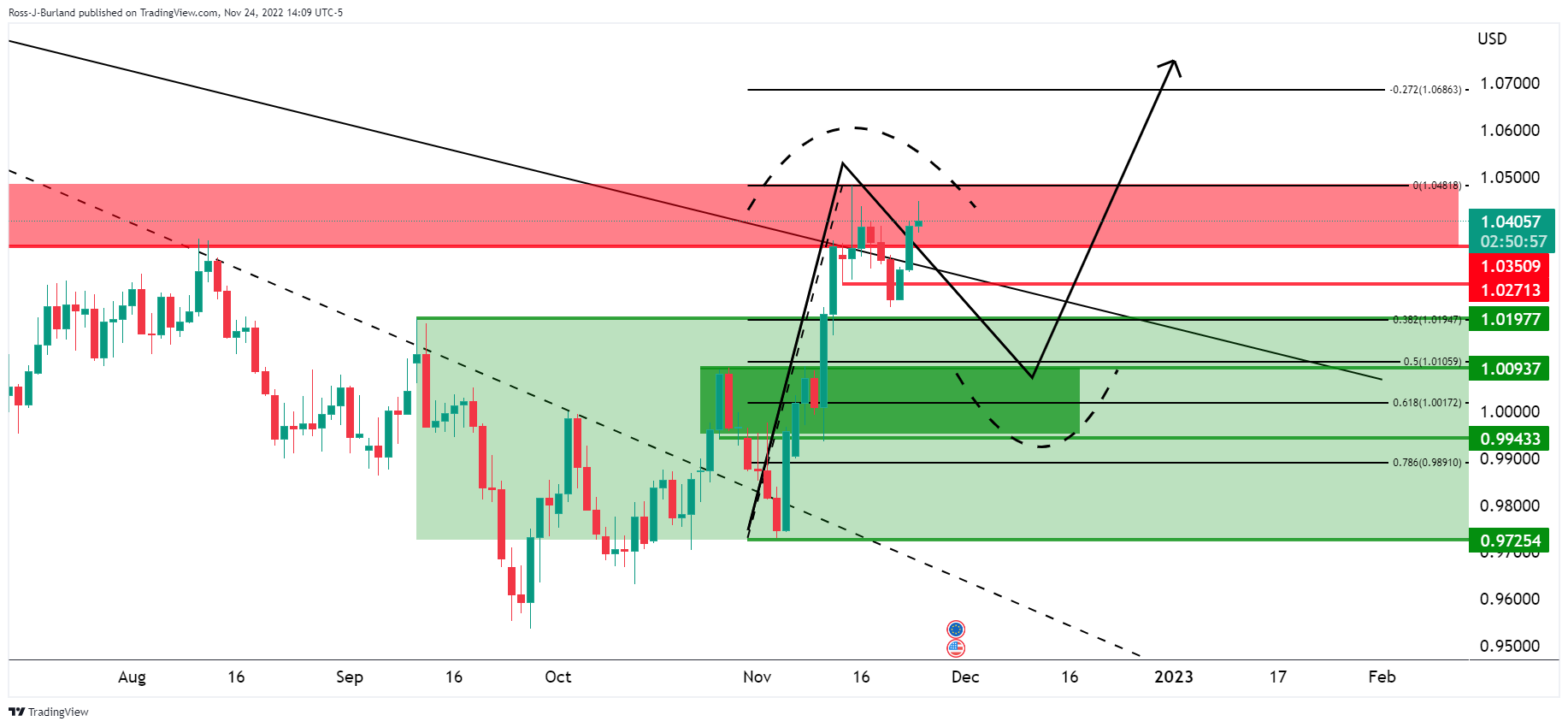
While there is another push into the peak formation, this could be its final attempt while below 1.0450. A breach there, however, opens the risk of a move into the support quarter of the 1.04 area for the end of the week. A break of 1.0500 could be significant bullish development with the risk of a move to 1.0600.
- The inverted head-and-shoulders chart pattern on the GBP/JPY daily chart remains intact.
- From the daily chart perspective, the GBP/JPY is upward biased.
- GBP/JPY Price Analysis: After breaking below 168.00, it exacerbated a fall towards 167.00 and beyond.
The British Pound (GBP) is losing ground against the Japanese Yen (JPY) on Thursday, even though sentiment improved after the US Federal Reserve (Fed) agreed to slow the pace of rate increases. Hence, Asian and European stocks rallied, but the JPY had the upper hand in the FX space. At the time of writing, the GBP/JPY is trading at 167.71 after hitting a daily high of 168.29.
GBP/JPY Price Analysis: Technical outlook
The GBP/JPY daily chart illustrates the pair as upward biased, even though a head-and-shoulders chart pattern emerged and remains intact. On Wednesday, the cross climbed nearby the pattern’s right shoulder, but sellers leaning below 169.00 sent the GBP/JPY tumbling towards 168.00 and beyond. Of note, the Relative Strength Index (RSI) remains above the 50-midline, but buyers are losing momentum as the slope turns down.
Short term, the GBP/JPY 4-hour chart shows the cross broke below the bottom-trendline of a rising wedge, signaling that sellers are moving in. However, unless the GBP/JPY tumbles below the 200-Exponential Moving Average (EMA) at 167.18 and the S1 daily pivot at 167.00, risks will remain skewed to the upside. On the other hand, if the GBP/JPY reclaims 168.00, the inverted head-and-shoulders chart pattern could be invalidated if the cross pierces 169.00.
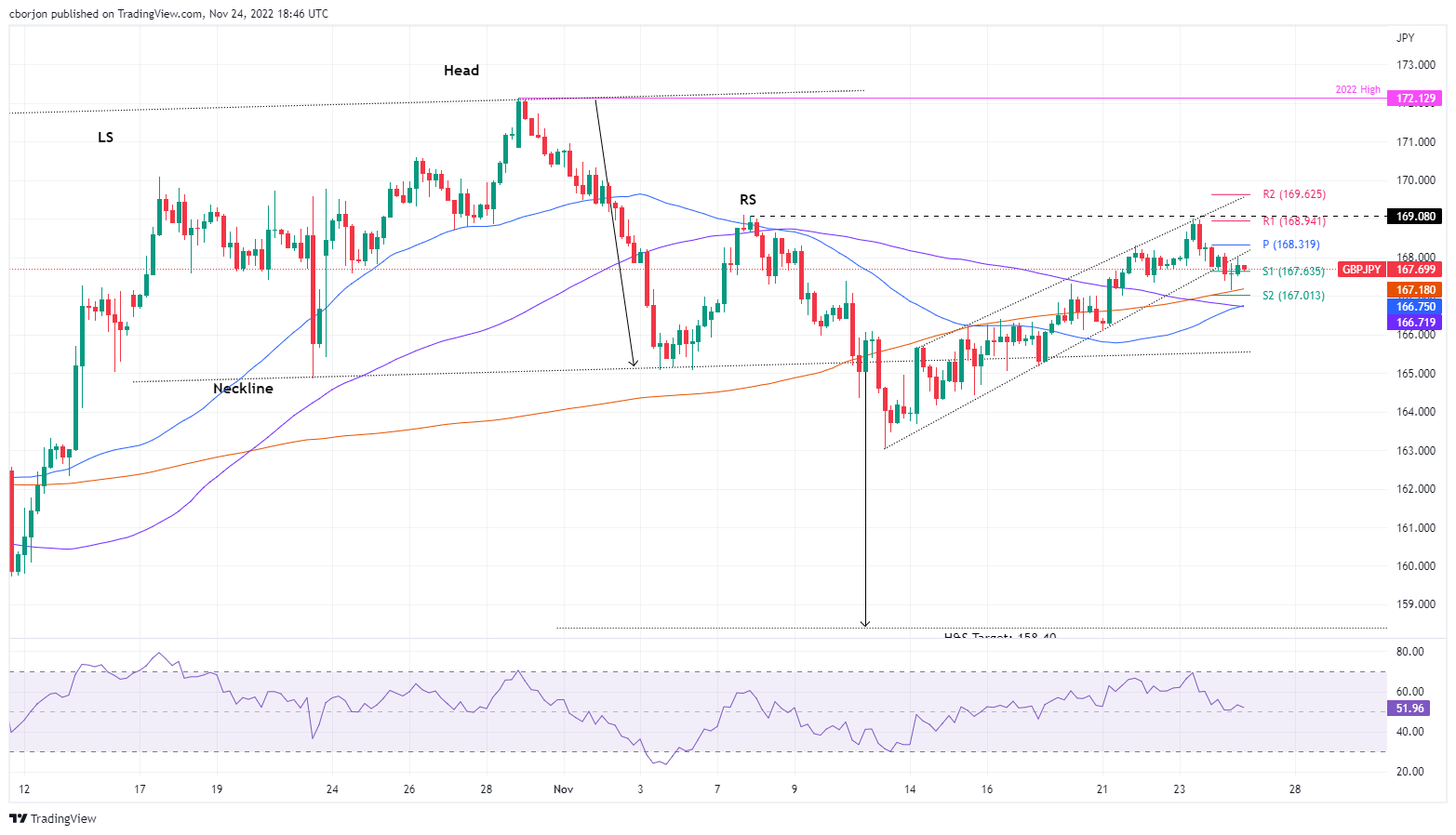
GBP/JPY Key Technical Levels
- USD/JPY bears are lurking for low-hanging fruit.
- A break of recent lows opens risk of a downside move to 138.00.
With US markets closed on Thursday for Thanksgiving, liquidity will likely be thinner than usual which means in the absence of traders, sideways choppy price action is in play. However, that is not to say there have not been opportunities in the New york session as the following illustrates:
USD/JPY M1 chart
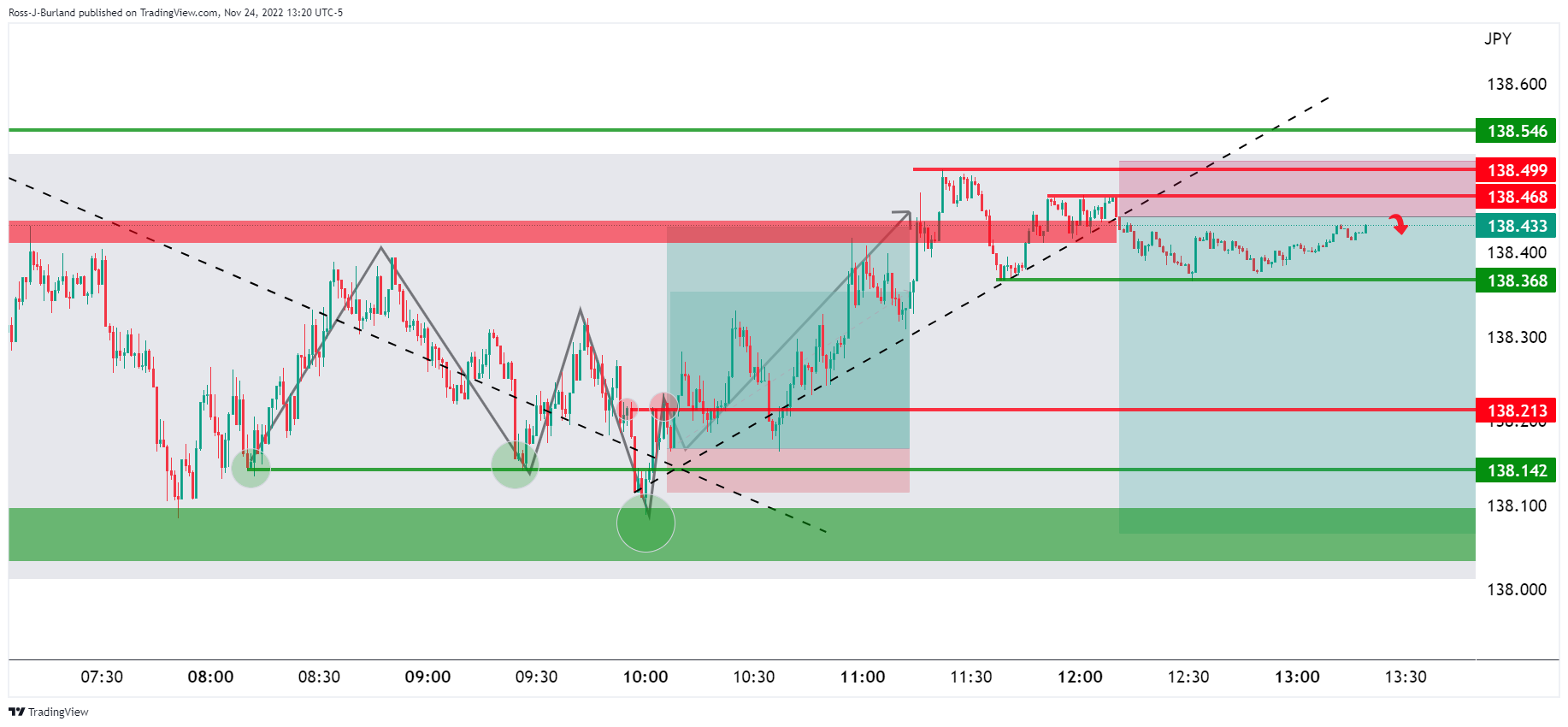
As seen, the price at the start of the session broke a trendline resistance and established equal lows around 138.15 before violating those and subsequently moving higher, all the while remaining on the back side of the counter trendline.
There is a similar scenario playing out for the downside, as shown above, although the volumes in forex have petered out being so late in the day, so there is a lack of momentum. Nonetheless, the setup is as follows:
USD/JPY H1 chart
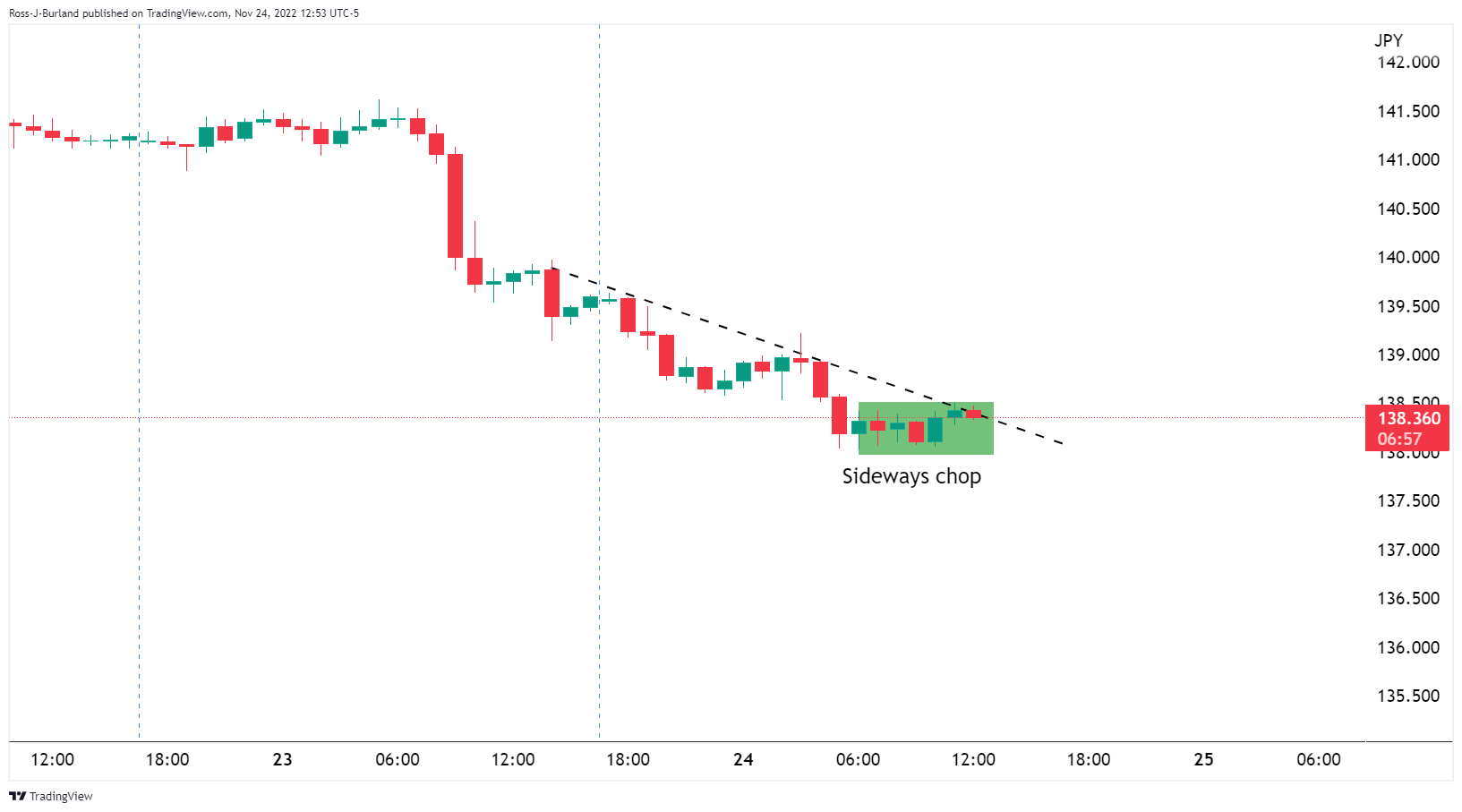
USD/JPY M15 chart
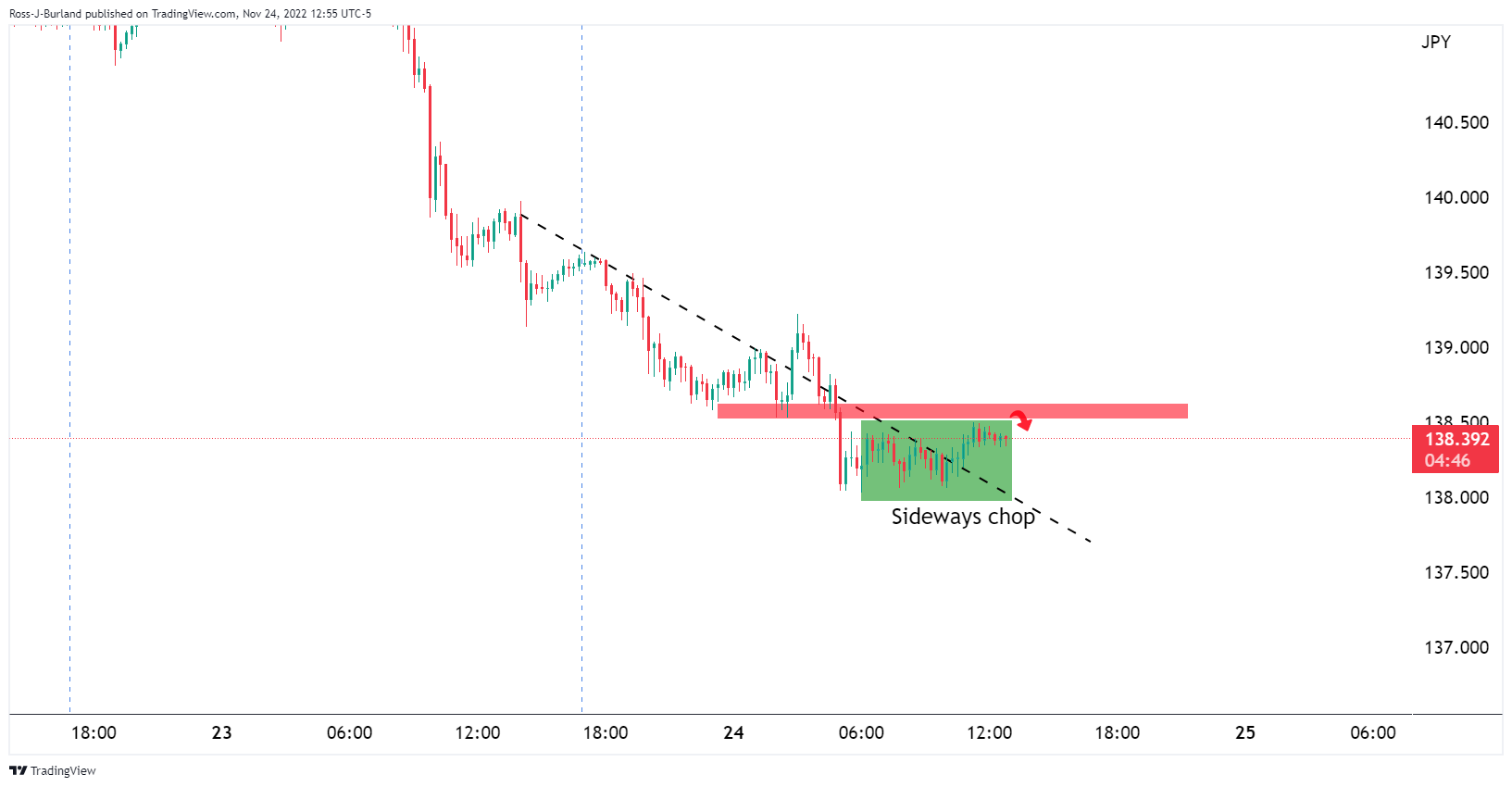
The price recently broke onto the backside of the trendline and that usually would be followed by a correction from below resistance.
USD/JPY M5 chart

There is low hanging fruit for the bears below recent consolidation lows and the sideways channel.
USD/JPY M1 chart
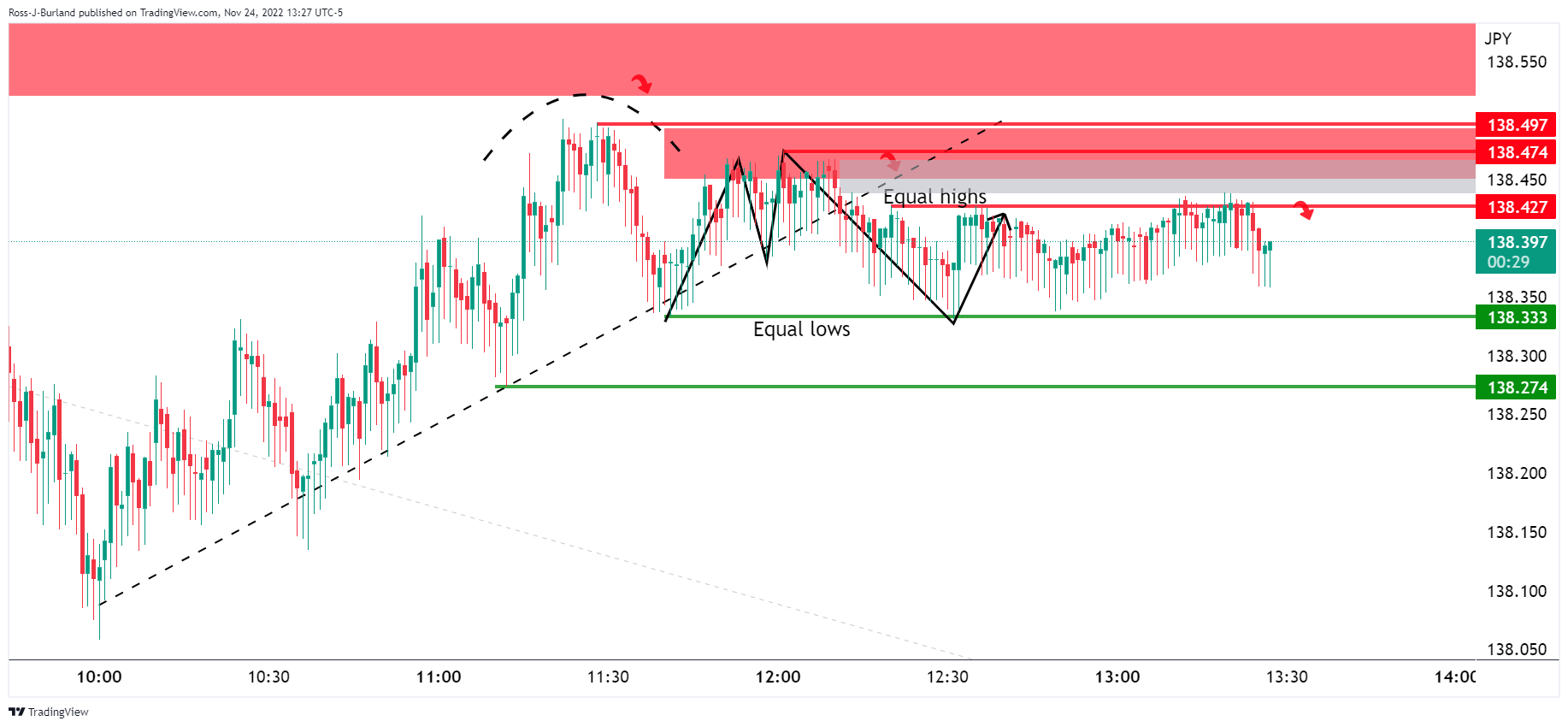
The minute chart shows the price trapped in a sideways chop but a violation of the recent equal highs points to prospects of a test of the price imbalance for mitigation. This could be the trigger for a stronger move to the downside and a test of equal lows. A break there opens the risk of a move into 138.00 the figure. However, until volumes return, in Asia and Frankfurt, sideways price action is the name of the game.
- The minutes of the Federal Reserve’s last meeting laid the ground for moderate rate hikes.
- US Dollar consequently weakened across the board against most G8 currencies.
- The Australian Dollar was bolstered by RBNZ’s hawkish commentary and a risk-on impulse.
- AUD/USD is on its way to hitting the inverted head-and-shoulders target at 0.6870.
The Australian Dollar (AUD) extended its gains for three straight days and reclaimed the 0.6700 figure on Thursday, courtesy of the November Federal Reserve minutes, which plunged the US Dollar (USD) against most G8 currencies. Therefore, the AUD/USD is trading at 0.6764, after hitting a daily low of 0.6726, in a light trading session, in observance of the Thanksgiving holiday in the United States (US).
Sentiment remains positive, as shown by European equities finishing in the green. The release of the Federal Reserve Open Market Committee (FOMC) minutes weighed on the US Dollar as officials agreed to slow the pace of rate hikes. Minutes were dovish tilted, as policymakers saw growth risks are skewed to the downside. In fact, Fed officials acknowledged a 50-50 chance of a recession in the United States.
Nevertheless, investors should be aware that policymakers expressed “uncertainty” about how high rates need to go and would be data-dependent. That said, caution is warranted, as the Federal Reserve would continue to increase borrowing costs.
Data-wise, the US economic docket on Wednesday was packed. S&P Global PMIs for November flashed signs of recession, mainly the Manufacturing Index, dropping to 47.6 vs. 50.4 on the previous reading. Later, the Consumer sentiment report released by the University of Michigan (UOM) printed 56.9, showing that Americans remain slightly optimistic about the economy. Inflation expectations were mainly unchanged.
US Initial Jobless Claims for the last week exceeded estimates, showing that the labor market is easing. At the same time, US Durable Good Orders beat forecasts, signaling consumers’ resilience amidst high inflation and higher borrowing costs.
On the Australian side, Covid-19 cases in China would likely keep the Australian Dollar (AUD) contained. However, the AUD was bolstered by hawkish comments by the Reserve Bank of New Zealand (RBNZ), which lifted rates by 75 bps on Wednesday. Investors should remember that the Reserve Bank of Australia (RBA) minutes showed that officials are open to either pausing the tightening cycle or returning to more significant interest rate hikes depending on incoming data.
AUD/USD Price Analysis: Technical outlook
The AUD/USD daily chart shows the major resumed its uptrend, after testing the 50% Fibonacci retracement at 0.6596, on Monday. Once the Australian Dollar buyers reclaimed 0.6700, they briefly tested the November high of 0.6797, which, once cleared, could send the AUD/USD toward the inverted head-and-shoulders chart pattern target of 0.6870. As an alternative scenario, the AUD/USD first support would be 0.6700, followed by the 100-day Exponential Moving Average (EMA) at 0.6687 and the 38.2% Fibonacci level at 0.6644.
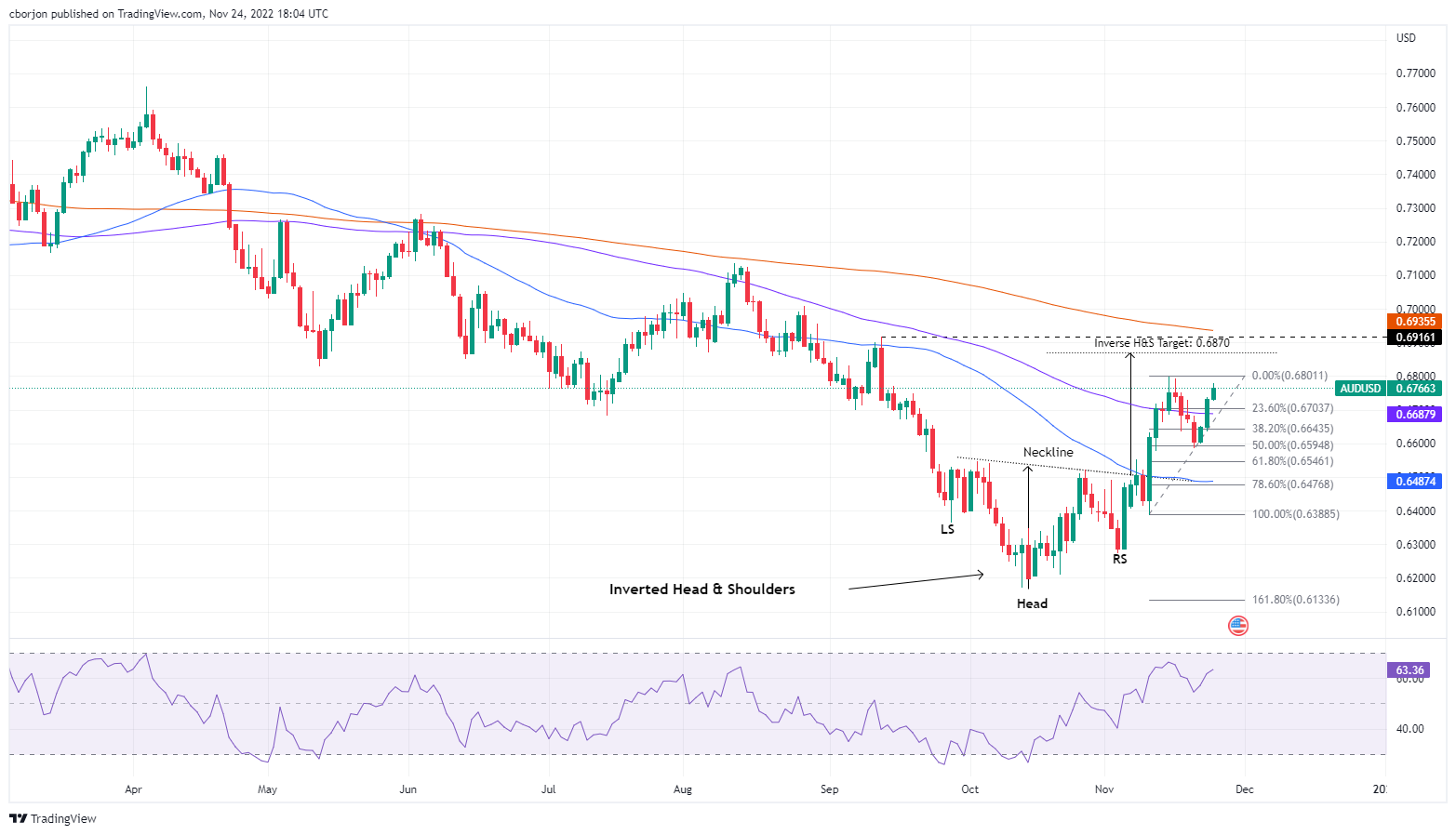
- Federal Reserve’s dovish tilted November minutes weighed on the US Dollar and bolstered the Canadian Dollar.
- US S&P Global PMIs dived into a recessionary territory, meaning that the US economy is decelerating fast.
- USD/CAD Price Analysis: Downward biased, eyeing the head-and-shoulders target at 1.3030.
The Canadian Dollar (CAD) continued its advance against the US Dollar (USD), courtesy of several factors, principally the US Federal Reserve (Fed) minutes perceived as slightly dovish, with the board ready to slow the pace of rate hikes. That, alongside a gloomy economic outlook in the United States (US) with PMIs entering the recessionary territory, weighed on the USD. At the time of writing, the USD/CAD is trading at 1.3338, below its opening price by 0.17%
US Dollar remains soft on Fed officials ready to moderate hikes
Sentiment remains upbeat, amidst low volume trading conditions, on the observance of the Thanksgiving holiday in the US. On Wednesday, the Federal Reserve Open Market Committee (FOMC), revealed November’s minutes, which expressed that “A substantial majority of participants judged that a slowing in the pace of increase would likely soon be appropriate,” giving the green light to investors seeking riskier assets. Nevertheless, traders should be aware that policymakers expressed “uncertainty” about how high rates need to go and would be data-dependent.
The same minutes reported that recessionary risks have increased, with odds at a 50% chance that the US economy would tap into a recession, as officials acknowledged that growth risks are skewed to the downside.
Aside from this, a slew of mixed economic data from the United States on Wednesday witnessed the S&P Global PMIs Manufacturing, Services, and Composite Indices for November entered the recessionary territory. Later, the University of Michigan (UOM) Consumer Sentiment remained positive at 56.9, below the preliminary reading but above estimates. Inflation expectations were mainly unchanged.
Earlier, the Initial Jobless Claims for the last week exceeded estimates, showing that the labor market is easing. At the same time, US Durable Good Orders beat forecasts, signaling consumers’ resilience amidst a period of high inflation and higher borrowing costs.
Meanwhile, the US Dollar Index (DXY), a gauge of the buck’s value against a basket of peers, is down b 0.23%, at 105.857, closing to the 200-day Exponential Moving Average (EMA) at 105.272. If the 200-day EMA is broken, that will exacerbate a test of the 100.000 figure.
Shifting our focus towards Canada, Bank of Canada (BoC) Governor Tiff Macklem appeared at the parliament, testifying on the October Monetary Policy Report. Macklem did not comment on anything new. He stressed the need to balance the risk of over and under-tightening. He said that they expect rates to rise further and added that inflation in Canada remains high and broadening, reflecting increases in goods and services prices
USD/CAD Price Analysis: Technical outlook
The USD/CAD resumed its downtrend after testing the head-and-shoulders neckline on Monday, though failure to crack it kept the chart pattern in play. The aftermath of the November Fed minutes release left the USD/CAD trading below 1.3400. Nevertheless, the lack of liquidity due to the US holidays kept the USD/CAD trading sideways. However, the USD/CAD path of least resistance is downwards.
Therefore, the USD/CAD first support is 1.3300. The break below will expose the 100-day Exponential Moving Average (EMA) at 1.3264, followed by 1.3200.
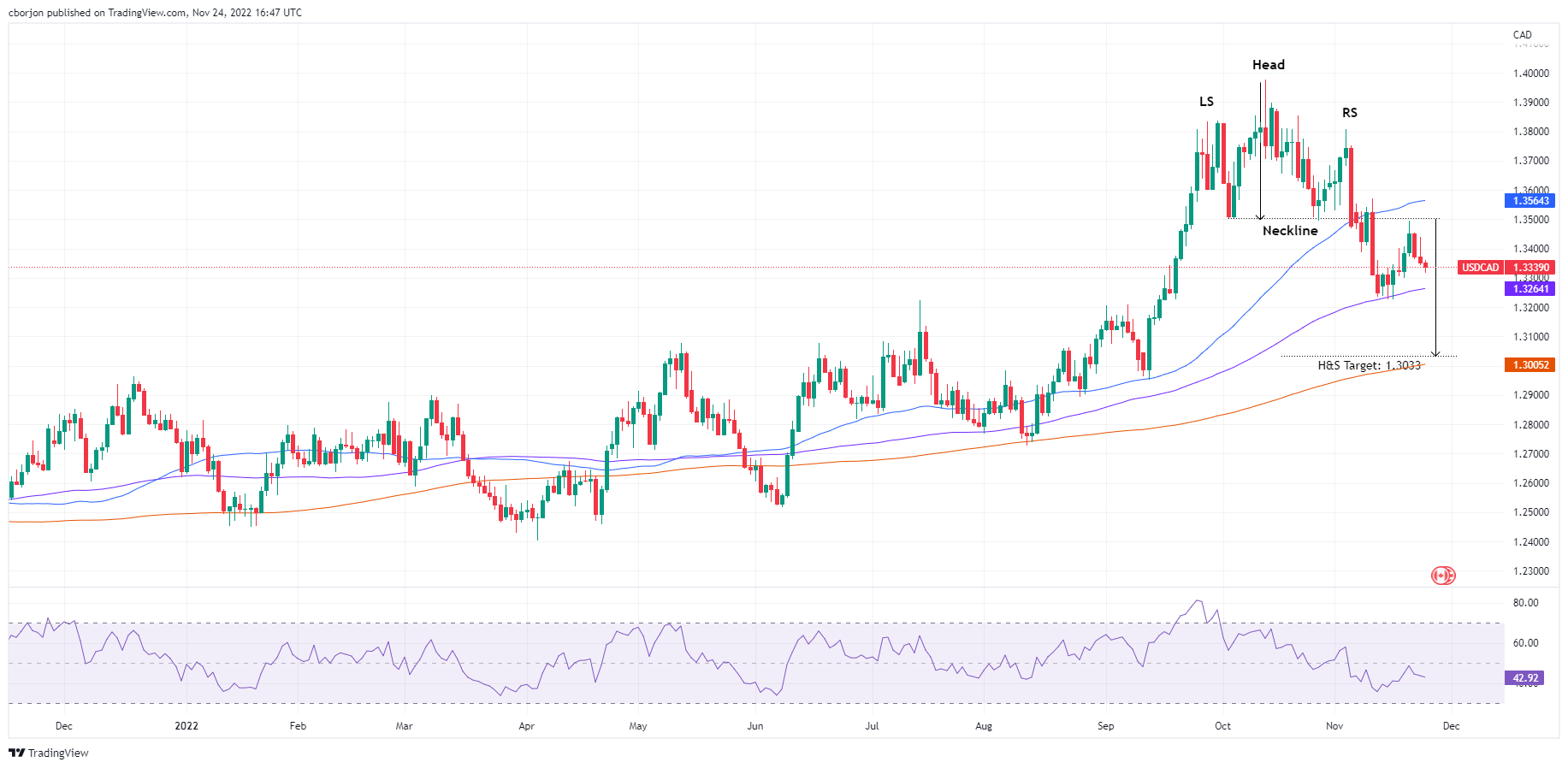
Data due next week includes Eurozone inflation data. Analysts at Wells Fargo expect data to show price growth slowed in November but is still elevated. They see the European Central Bank tightening monetary policy through the end of 2022 and EUR/USD slipping back below parity.
Key Quotes:
“Europe has seen persistent inflationary pressures, and next week, we expect those pressures to still be reflected in November CPI data. To that point, headline inflation is currently 10.7% year-over-year; however, we expect November data to show price growth slowed over the course of the month, but remains elevated. While energy prices have come down and supply chain disruptions have eased, natural gas supply disruptions have kept inflation well above the European Central Bank's (ECB) target range.”
“Policymakers have communicated interest rates are likely to rise in the near future, and while we believe additional tightening is likely, the ECB is unlikely to deliver the amount of tightening priced by financial markets. In that sense, we expect the euro to slip back below parity as markets adjust to a more gradual pace of tightening.”
“Eurozone inflation is likely to remain above the ECB's target for all of 2023, only starting to head on a downward trajectory in a few months' time.”
Ahead of the next US official employment report, due next week, analysts at Wells Fargo, look for job growth to moderate further in November and the subsequent month. They point out that wage data will also be crucial for the Federal Reserve.
Key Quotes:
“Nonfarm payrolls rose 261K in October, topping expectations again. Yet beneath the surface, there were some signs in the data that cracks are emerging in the labor market. Technical factors related to the birth-death model appear to be flattering the headline nonfarm payroll numbers. Employment, as measured by the household survey, fell by 328K in October, and the labor force participation rate again tumbled back to where it was when the year began.”
“We look for job growth to moderate further in November and the subsequent months. Layoffs, according to initial jobless claims and the JOLTS report, remain low, but discharges are only half the net hiring equation. Demand for additional workers appears to be slipping. Job openings, hiring plans, PMI employment sub-components and consumers' views of the labor market have all deteriorated since the spring. Beyond the headline, the average hourly earnings data also will be crucial for Federal Reserve policymakers. It will take more than normalizing supply chains to return inflation to 2%, and slower wage growth is another important piece of the puzzle.”
- US Dollar remains under pressure after FOMC minutes.
- Limited trading activity as Wall Street remains close.
- GBP/USD heads for the highest close in three months.
The GBP/USD rose further during the American session and hit at 1.2152, the highest level since mid-August. It is up rising for the third consecutive day. While the Pound holds to recent gains, the US Dollar is under pressure.
Cable has risen more than 300 pips since Tuesday as the UK leaves behind the chaotic September and October. Price has approached the 200-day Simple Moving Average that stands at 1.2180. The last time the GBP/USD closed above was back in September 2021.
The short-term bias favors the upside although some overbought readings are seen. The 1.2030 zone has become the initial support followed by 1.1960. A sharp correction, could reach the 1.1700 without changing the upside bias.
The US Dollar continues to slide following the FOMC minutes released on Wednesday. Expectations that the US central bank might slow the pace of rate hikes after four 75 basis points hikes weighed on the Greenback and boosted Treasuries. The Fed will likely continue to raise rates as inflation remains elevated and far from the target.
On Thursday, price action is limited on Thanksgiving Day. Wall Street is closed and Friday will see a shortened session.
Technical levels
The average monthly performance of the Euro against the Dollar for the last 20 years shows that the EUR/USD pair has usually risen in December, economists at Société Générale report.
Danger of falling over on an icy sidewalk in January
“The last 20 Decembers have seen EUR/USD rising on 16 occasions, making it the Euro’s best month by some distance. Part of the reason may be that Euro sentiment has been negative more often than not, over that period. The average position in the FX markets market, for example, has been short Euros over that period. This means that there is frequently pressure to cover short Euro positions into the end of the year.”
“January is usually the Euro’s worst month, perhaps because the bearish sentiment doesn’t go away. This year, with a massive Dollar-bullish consensus taking EUR/USD lower, short-covering pressures may be even bigger than usual.”
“The danger is that the conditions for a January EUR/USD wobble are very easy to imagine. US consumers, still supported by strong balance sheets, don’t stop spending, and the Fed is forced to remain hawkish in the New Year. Winter arrives in Europe and concerns about energy supplies grow. Russian missile attacks on Ukraine raise fears of a bloody stalemate. That kind of news after a strong Euro rebound is exactly the kind of icy sidewalk that even a careful currency strategist could fall over on!”
- US Dollar weakened due to the dovish tone of the Federal Reserve’s last meeting minutes.
- US S&P Global PMIs dropped to contractionary territory, a headwind for the USD.
- According to the University of Michigan Consumer Sentiment poll, inflation expectations in the United States remained unchanged.
- Gold Price Analysis: Upward biased, needing to clear $1800 to extend the uptrend.
Gold Price advanced steadily on Thursday amidst thin liquidity conditions courtesy due to the observance of the Thanksgiving holiday in the United States (US), with Wall Street and the bond market closed. Factors like Federal Reserve (Fed) policymakers agreeing to moderate interest-rate increases and a risk-on mood keep the US Dollar (USD) on the defensive. Therefore, XAU/USD is trading at $1756 a troy ounce at the time of writing.
Federal Reserve minutes a headwind for the US Dollar
On Wednesday, the Federal Reserve revealed its latest minutes, which showed that officials are ready to begin hiking rates on smaller sizes after lifting the Federal Funds rate (FFR) by 75 bps four times in 2022. Even though the minutes are slightly dovish, investors should know that Federal Reserve officials are uncertain how high rates will end, with most policymakers expressing that 5% could be the peak for some participants.
US S&P Global PMI tumbled to recessionary territory, triggering USD weakness
On Wednesday, S&P Global PMIs revealed for the United States showed that the economy is slowing faster than expected, with Manufacturing, Services, and Composite Indices lying in contractionary territory. Chris Williamson, Chief Business Economist at S&P Global Market Intelligence, said that “business conditions across the US worsened in November” and added that “according to the preliminary PMI survey findings, with output and demand falling at increased rates, consistent with the economy contracting at an annualized rate of 1%.”
US consumer sentiment remained positive
At the same time, the University of Michigan (UOM) Consumer Sentiment for November, on its final reading, came at 56.9, above expectations but below the 59.9 preliminary reading. The same report updated American expectations for inflation, with one-year estimated to rise hit 4.9%, while the 5-10 year estimates remained unchanged at 3%.
Mixed US economic data pressured the US Dollar
Earlier, the US economic docket featured Initial Jobless Claims for the last week, which jumped above expectations, flashing that the labor market is easing. At the same time, US Durable Good Orders for October rose sharply by 1% MoM, against 0.4% estimates, as consumers’ resilience kept manufacturing activity from slowing down.
Aside from this, US Treasury yields extended their losses, with the 10-year T-bond yield dropping six bps, down to 3.70%, a tailwind for the Gold price, undermining the USD. Meanwhile, the US Dollar Index (DXY), a gauge of the buck’s value against a basket of rivals, stumbles 0.36%, at 105.705.
Gold Price Analysis (XAU/USD): Technical outlook
From a daily chart perspective, XAU/USD is neutral-upward biased. However, Gold stays below the “trendsetter” 200-day Exponential Moving Average (EMA), used as confirmation for bullish/bearish bias in the long term. So if XAU buyers want to regain control, they need to clear $1800, so they can pose a threat to send XAU/USD rallying towards the June 17 swing high at $1857 ahead of the psychological $1900 figure. Otherwise, the XAU/USD will be exposed to selling pressure, opening the door for a fall to the 100-day EMA at $1711.51, ahead of the $1700 mark.
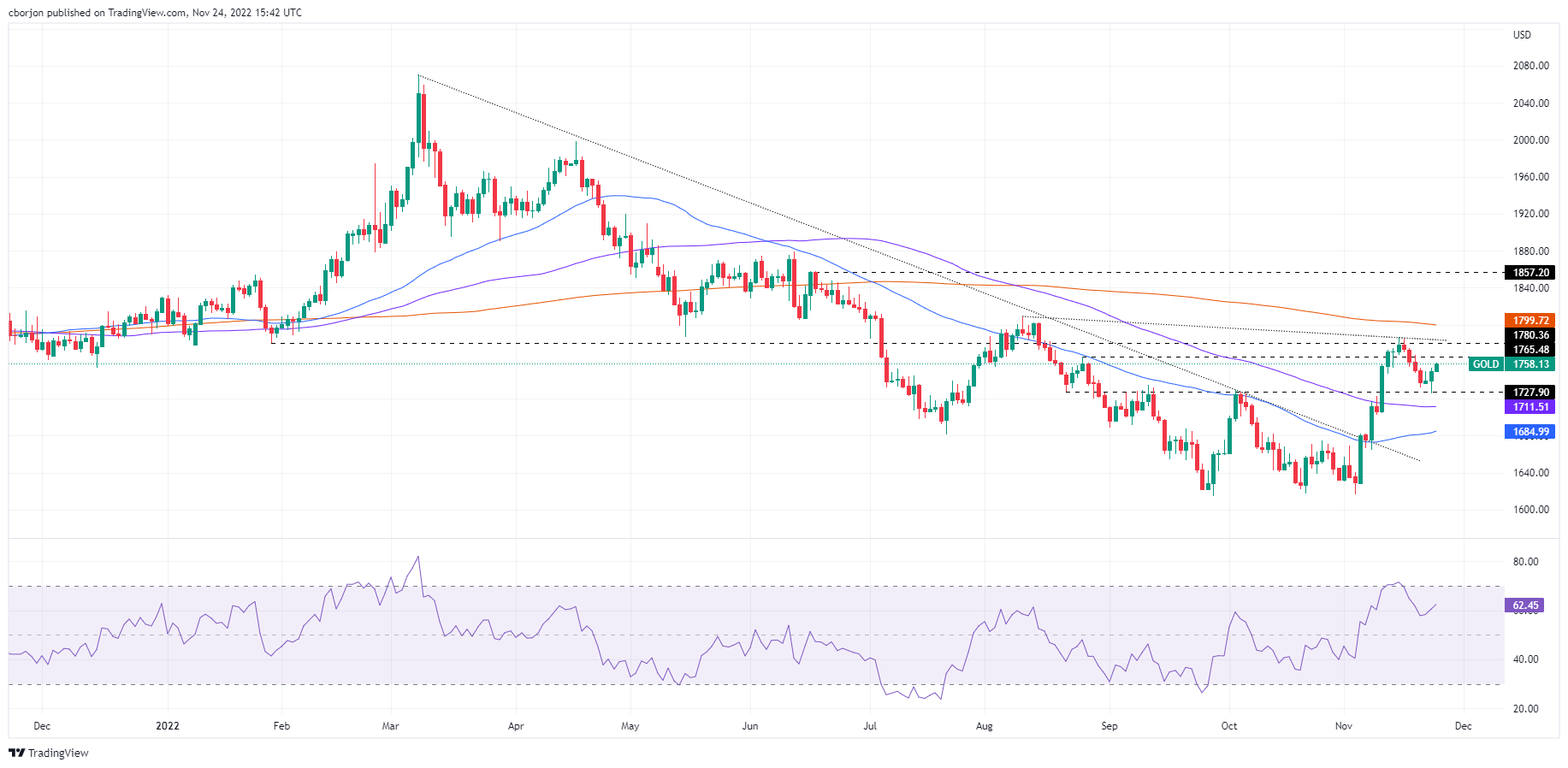
The US Dollar Index is close to testing the recent intra-day low from 15th November at 105.34. However, economists at MUFG believe that the USD sell-off does not have too much further to go.
FOMC minutes fail to provide conviction for higher terminal rate
“The release of the FOMC minutes last night in our view failed to provide enough conviction to the belief expressed by Fed Chair Powell that the terminal rate for the fed funds would need to be higher than the September media dot implied (4.625%).”
“The US Dollar will remain vulnerable to speculation of an end to the tightening cycle. The 2s10s continues to invert and is indicative of a growing belief that inflation risks are receding but with the Fed not in a position to pause. But the escalation of covid infections to record high levels in China and recession in Europe also mean there are limits to the scale of USD selling that should mean this long Dollar squeeze does not have too much further to go.”
Bank of England (BOE) policymaker Catherine Mann said on Thursday that price and wage dynamics in the UK were not consistent with the 2% inflation target but noted that they were not observing a wage-price spiral, as reported by Reuters.
"The BOE has communicated effectively that rates need to rise and that market expectations before the November meeting were too high," Mann added.
Market reaction
GBP/USD preserves its bullish momentum and trades near 1.2150 after these comments, rising 0.8% on a daily basis.
Brent Oil dropped 3.4% on Wednesday. A break under the September low of $84.06 would intensify downside pressure, strategists at MUFG Bank report.
Lower oil prices alleviate the negative terms of trade shock on EUR, GBP and JPY
“Weak growth is a possible factor but in addition, the speculation of a Saudi-led push for a production increase could still be weighing on crude oil prices.”
“Lower crude oil prices and still low natural gas prices alleviate considerably the negative terms of trade shock on the Euro, Pound and Japanese Yen.”
“A close in Brent below the September low of $84.06 would be a technically bearish signal.”
- Japanese yen among top performs on Thursday amid lower bond yields.
- US Dollar still affected by the FOMC minutes.
- USD/JPY is about to post the lowest daily close in almost three months.
The USD/JPY is hovering around 138.15/20, holding a bearish tone on the back of a weaker Dollar but also amid a stronger Japanese yen. The pair bottomed at 138.04, the lowest since November 15, before bouncing modestly to the upside.
As long as USD/JPY remains under 138.50, more losses seem likely. The immediate support is the 138.00 zone followed then by the November low at 137.65. The pair is on its way toward the lowest daily close since August 26, another bearish sign.
Dollar under pressure
The US Dollar has been under pressure since Wednesday. The FOMC minutes added to the negative tone. Expectations that the Fed might slow the pace of interest rate hikes as soon as the next meeting, December 13/14 weighed on the Dollar and boosted Treasuries. The US 10-year yield fell to as low as 3.68% approaching the monthly low. The DXY is falling by 0.35%, trading at 105.75, headed toward the lowest daily close since mid-August.
The decline in bond yields boosted the Japanese yen across the board. The currency is among the top performers on a quiet session. Wall Street is closed due to a holyday in the US (Thanksgiving Day).
No economic data is due in the US for the rest of the week. In Japan, on Friday, the Tokio Consumer Price Index will be released. It will be a shortened session in Wall Street that will resume normal activity on Monday.
Technical levels
GBP/USD extends gains through the 1.20 area. Economists at Scotiabank expect Cable to test the 1.22/1.23 region.
Resistance at 1.2050/00 turns into support
“Solid intraday trends are backing up a positive longer-term technical picture for the GBP.”
“Clear and sustained Cable gains through the 1.2000/50 zone this week put the Pound on course for an extension higher to test the 1.22/1.23 area.”
“The GBP’s 200-day MA stands at 1.2192 and figures as important resistance for the next few days ahead.”
“Support is 1.2000/50, former resistance.”
- EUR/USD rises for the third session in a row and trespasses 1.0400.
- Further gains could challenge the monthly peak around 1.0480.
EUR/USD flirts with the multi-month resistance line around 1.0450 amidst the continuation of the upside momentum on Thursday.
A close above the key 200-day Simple Moving Average, today at 1.0391, is needed to shift the pair’s outlook to positive and thus allow for extra gains to potentially visit the November high at 1.0481 (November 15).
Above the latter, the pair could aim for a move to the round level at 1.0500.
EUR/USD daily chart
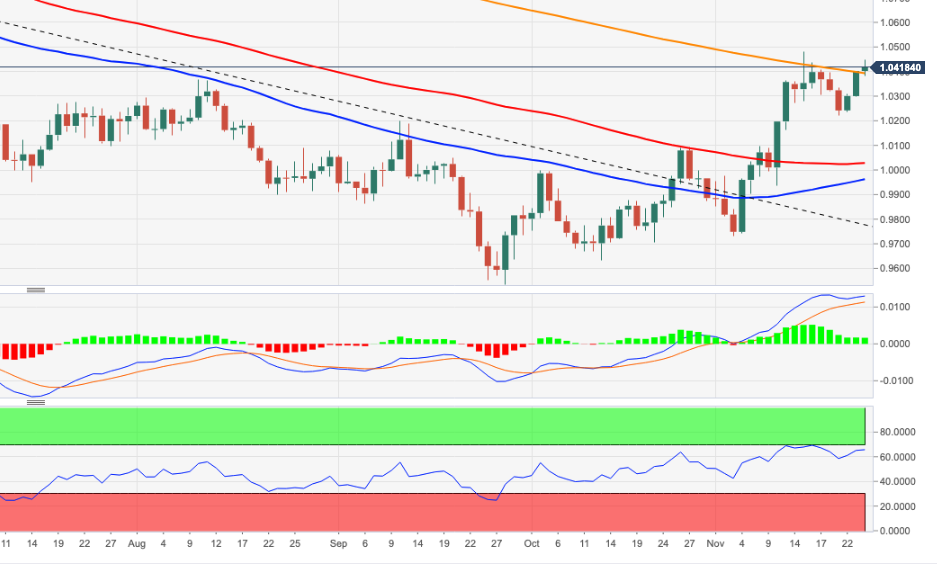
- The index succumbs to the selling pressure and breaches 106.00.
- A deeper pullback opens the door to the November low near 105.30.
DXY keeps the downtrend well and sound in the second half of the week, this time dropping well south of the 106.00 support.
In case the selling pressure accelerates, the dollar could shed further ground and dispute the November low at 105.34 (November 15). This area of contention appears underpinned by the proximity of the always relevant 200-day SMA, today at 105.27
While above the 200-day SMA, the outlook for the index should remain constructive.
DXY daily chart
USD/CAD peeled off steadily yesterday, losing around 90 pips into the close to retest the low-1.33s. A dip below here would open up the room for further losses, economists at Scotiabank report.
Intraday charts reflect firm USD selling pressure
“Spot’s turn lower from Monday’s high/retest of the head and shoulders breakdown at 1.3495 looks a little more emphatic now, with steady losses pushing the USD back to the low 1.33s.”
“Intraday charts reflect firm USD selling pressure on USD gains above 1.34 yesterday and we look for better selling pressure on modest gains to curb the USD today and perhaps into tomorrow.”
- EUR/JPY adds to the corrective downside and breaches 144.00.
- The continuation of the leg lower could revisit 142.50.
EUR/JPY corrects further south and briefly tests the 143.60 region on Thursday, or multi-session lows.
The cross reversed the strong rebound soon after trespassing the 146.00 mark on Wednesday and sparked quite a marked reversal. That said, further weakness could now motivate EUR/JPY to slip back to the November low at 142.54 (November 11) sooner rather than later.
In the longer run, while above the key 200-day SMA at 138.68, the positive outlook is expected to remain unchanged.
EUR/JPY daily chart
Economist Lee Sue Ann and Markets Strategist Quek Ser Leang at UOB Group see USD/CNH keeping the side-lined trading between 7.0600 and 7.2100 for the time being.
Key Quotes
24-hour view: “Our view for USD to weaken yesterday was incorrect as it soared to a high of 7.1837 before quickly falling back down. The sharp but short-lived swings have resulted in a mixed outlook. We expect USD to trade between 7.1200 and 7.1650 today.”
Next 1-3 weeks: “We continue to hold the same view as from last Friday (18 Nov, spot at 7.1460) where USD has likely moved into a consolidation phase. We expect USD to trade sideways for now, likely to be between 7.0600 and 7.2100.”
Steady gains in the EUR/USD since Tuesday leave the pair trading relatively firmly. Economists at Scotiabank note that EUR/USD is on the cusp of a further push higher.
EUR/USD nears 200-Day Moving Average test
“Short-term trading patterns are positive, with the EUR gaining steadily from its early week low and accelerating higher yesterday after regaining the 1.03 zone.”
“EUR/USD is on the cusp of retesting the mid-Nov high (1.0479) on the short-term chart and we continue to think that gains should extend to the low 1.05 (retracement resistance point) following the break above long term trend resistance. More significant, however, is the fact that the EUR is poised to regain (conclusively) its 200DMA, which it last saw in Jun 2021. Pushing through this benchmark would be hugely supportive from a market point of view.”
European Central Bank (ECB) Governing Council member Isabel Schnabel said on Thursday that they will probably need to raise interest rates further into restrictive territory, as reported by Reuters.
Key takeaways
"In the current environment, there is a risk that monetary and fiscal policies may pull in opposite directions."
"We continue to stand ready to counter fragmentation in financial markets that is not justified."
"Incoming data so far suggest that the room for slowing down the pace of interest rate adjustments remains limited."
"The new macroeconomic environment requires a different mix of monetary and fiscal policies."
"The largest risk for central banks remains a policy that is falsely calibrated on the assumption of a fast decline in inflation."
Market reaction
These comments failed to trigger a noticeable market reaction and EUR/USD was last seen trading at 1.0410, where it was up 0.15% on the day.
USD/TRY remains stuck in a narrow range at around 18.60. Economists at TD Securities expect the pair to jump toward to 27 by the first quarter of 2023.
CBRT ends easing with a final cut
“The CBRT cut the policy repo by 150 bps to 9.00%, in line with our forecasts and the consensus. With rates achieving 'single-digit' levels, the CBRT has called the end of easing.”
“Today's decision cuts ex-ante real rates further to -76.5%. While inflation is likely to be at or close to the peak, monetary policy in Turkey will remain excessively expansionary for the foreseeable future.This suggests persistent inflationary and negative currency pressures.”
“We still expect USD/TRY to blow up to around 27 (from 18.63) in Q1 2023. We also expect rates to be hiked in emergency mode next year, with a likely peak of around 40%.”
The accounts of the European Central Bank's (ECB) October policy meeting revealed on Thursday that a few members of the Governing Council expressed a preference for increasing the policy rate by 50 basis points (bps) rather than 75, per Reuters.
Additional takeaways
"The view was widely shared that the inflation outlook continued to worsen."
"These developments indicated an increasing risk that inflation might become entrenched."
"ECB now needed to show equal determination when inflation was above the target, countering far too high inflation and preventing it from becoming entrenched, irrespective of a deteriorating outlook."
"Wage growth was accelerating, it could still be considered moderate."
"Weakening in economic activity would not suffice to curb inflation to a significant extent."
"Governing Council should continue normalising and tightening monetary policy, whereas it might want to pause if there was a prolonged and deep recession."
"Although wage growth was accelerating, it could still be considered moderate."
"75 basis points hike was supported by a very large majority."
"It was noted that market participants were pricing in an increase of this size."
Market reaction
The ECB's publication failed to trigger a noticeable market reaction and EUR/USD was last seen trading sideways at around 1.0400.
EUR/SEK broke out above a multi-month trend line resulting in a move towards 11.10 in October. Economists at Société Générale expect the pair to advance nicely towards 11.10, then 11.26.
Upward momentum prevails
“Currently a phase of pullback is underway however the pair has so far successfully defended that support line at 10.68/10.63.”
“Daily MACD has entered positive territory denoting prevalence of upward momentum.”
“Holding above 10.68/10.63, the up move could persist gradually towards 11.10 and projections of 11.26.”
See – EUR/SEK: Krona to weaken over the coming quarters – Danske Bank
- USD/TRY reverses the recent weakness after the CBRT move.
- The central bank cut the interest rate by 150 bps, as expected.
- The CBRT said that the easing cycle is now terminated.
The Turkish lira gives away some of its previous gains and prompts USD/TRY to advance to the 18.6300 region on Thursday.
USD/TRY up on CBRT rate cut
USD/TRY sets aside two daily pullbacks in a row and regains upside momentum on the back of the resumption of the bearish note around the Turkish lira.
Indeed, sellers put the lira under pressure after the Turkish central bank (CBRT) cut the One-Week Repo Rate by 150 bps to 9.00% at Thursday’s event, matching estimates.
The central bank announced that the easing cycle that started back in August is now over. It is worth recalling that the CBRT reduced the policy rate from 14.00% in July to 9.00% in November, fulfilling President Erdogan’s pledge of having single-digits interest rate by end of the year.
There were no changes to the CBRT’s statement, which still contemplates the inflation target at 5%.
On the latter, consumer prices tracked by the headline CPI rose more than 85% in the year to October and the government expects it to recede to around 65% by year end.
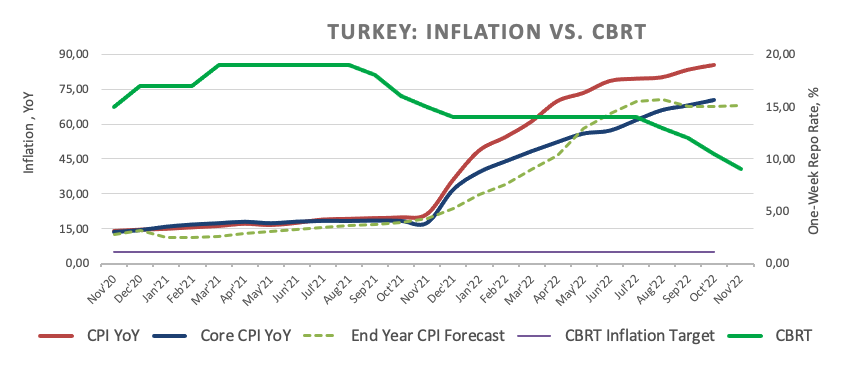
Earlier in the calendar, Capacity Utilization in Türkiye eased to 75.9% in November and the Manufacturing Confidence receded to 97.9 in the same month.
What to look for around TRY
USD/TRY remains side-lined above/around the 18.6000 region amidst omnipresent intervention in the FX markets.
So far, price action around the Turkish lira is expected to keep gyrating around the performance of energy and commodity prices - which are directly correlated to developments from the war in Ukraine - the broad risk appetite trends and the Fed’s rate path in the next months.
Extra risks facing the Turkish currency also come from the domestic backyard, as inflation gives no signs of abating and real interest rates remain entrenched well in the negative territory
In addition, the lira is poised to keep suffering against the backdrop of Ankara’s plans to prioritize growth via transforming the current account deficit into surplus, always following a lower-interest-rate recipe.
Key events in Türkiye this week: Capacity Utilization, Manufacturing Confidence, CBRT Interest Rate Decision (Thursday).
Eminent issues on the back boiler: FX intervention by the CBRT. Progress of the government’s scheme oriented to support the lira via protected time deposits. Constant government pressure on the CBRT vs. bank’s credibility/independence. Bouts of geopolitical concerns. Structural reforms. Presidential/Parliamentary elections in June 23.
USD/TRY key levels
So far, the pair is gaining 0.13% at 18.6262 and faces the next hurdle at 18.6503 (all-time high November 3) followed by 19.00 (round level). On the downside, a break below 18.3642 (monthly low November 7) would expose 18.2077 (100-day SMA) and finally 17.8590 (weekly low August 17).
European currencies are strengthening amid a favourable backdrop. Nonetheless, economists at ING do not expect a smooth ride as energy prices are set to rise.
Enjoying an ideal mix for now
“European currencies are enjoying a strong rally, as lower energy prices (crude was hit by the EU oil price cap proposal) and higher-than-expected PMIs yesterday had already offered some support to European sentiment before the Fed delivered some dovish minutes.”
“We remain doubtful that it will be a smooth ride to recovery for European currencies, and our commodities team continues to see upside risks for energy prices into the new year despite recent developments.”
Further downside could drag USD/JPY to retest the 137.70 region in the next few weeks, note Economist Lee Sue Ann and Markets Strategist Quek Ser Leang at UOB Group.
Key Quotes
24-hour view: “While we expected a lower USD yesterday, we did not expect a break of the strong support at 140.30. However, USD cracked 140.30 and plunged to a low of 139.15. Impulsive downward momentum indicates further decline. The level to watch is at 138.50, followed by 137.70. The latter level is unlikely to come into view today. Resistance is at 139.80, followed by 140.30.”
Next 1-3 weeks: “After USD soared above 142.00, we indicated on Tuesday (22 Nov, spot at 141.80) that upward momentum is building. However, we were of the view that USD has to break and hold above 142.50 before further gains are likely. USD did not challenge 142.50 but instead, dropped below our ‘strong support’ level of 140.30 yesterday. The sharp and swift drop has shifted the risk to the downside towards 137.70. On the upside, the ‘strong resistance’ at 140.80 is likely to come under challenge, at least for the next 1 to 2 days.”
EUR/USD is gaining traction above the 200-Day Moving Average (DMA) at 1.0393. Analysts at Société Générale expect the pair to target 1.0630/90 on a move above the 1.0480 mark.
Weekly low at 1.0220 provides support
“EUR/USD is attempting a break beyond the 200DMA denoting possibility of continuation in bounce.”
“Beyond 1.0480, next potential hurdles are at projections of 1.0570 and 1.0630/1.0690.”
“The low formed this week at 1.0220 is near term support.”
See: EUR/USD may extend its rally to 1.0500/1.0550 in the near term – ING
NZD/USD closed above 0.62 for the first time since 25 August. Economists at DBS Bank expect the pair to struggle at the 0.6270 resistance.
RBNZ says overnight cash rate needs to hit 5.5%
“The Reserve Bank of New Zealand delivered the 75 bps hike expected by consensus. With the official cash rate at 4.25% and above the 4.1% terminal rate projected in August, the RBNZ now sees more hikes to 5.5% in 2023.”
“Unlike the US, inflation has yet to show signs of peaking in New Zealand. RBNZ reckoned CPI inflation could rise further to 7.5% over the next couple of quarters from 7.2% in September. RBNZ also played down the 11.5% fall in house prices from its November 2021 peak, citing the 15% rise in household wealth since end-2020. However, the central bank did not mind a recession to return inflation to its 1-3% target.”
“Kiwi may find resistance at its 50% Fibonacci retracement level of around 0.6270.”
USD/ZAR has broken below 17.00. Economists at Société Générale expect the pair to trend lower toward 15.00 over the coming months.
An initial rebound is expected
“An initial rebound is expected however the channel limit at 17.27 and recent pivot high of 17.55 are likely to be near term hurdles.”
“Failure to hold 16.85 can extend the decline towards 16.65 and perhaps even towards the 200-Day Moving Average near 16.40/16.35. This could be a crucial support zone.”
“We see the Rand strengthening towards 15.00/USD over the next 12 months.”
Riksbank has hiked by 75 basis points as expected. However, economists at Danske Bank expect the Swedish Krona to weaken in the coming months.
Slightly dovish tilt
“The 75 bps hike to 2.50% and a the slightly higher rate path was bang in line Overview of macro forecasts with our expectations. They will also end QE reinvestments as of year-end. The revised rate path is still somewhat shy of market expectations, and hence somewhat dovish.”
“The initial reaction is for a somewhat weaker SEK, which seems warranted given the slightly dovish rate path (compared to market pricing).”
“We don’t see anything in either monetary policy or the Riksbank’s communication here and now that changes the outlook for the SEK over the coming quarters, where we expect a further weakening.”
European Central Bank (ECB) Governing Council member Gabriel Makhlouf said on Thursday that “housing markets across the world responding to rising interest rates, early indications of reduced demand.”
Further comments
“Vulnerabilities accumulated during the period of low rates means the full impact of shocks are hard to foresee.”
“Undoubtedly risks of further asset price falls, potential episodes of market disruption as we tackle inflation.”
Market reaction
EUR/USD is clinging to gains above 1.0400, currently trading at 1.0425, 0.30% higher on the day.
- EUR/USD picks up pace and surpasses the 1.0400 barrier.
- The dollar remains offered following Wednesday’s FOMC Minutes
- German IFO Business Climate surprised to the upside in November.
The optimism around the European currency remains on the rise and now lifts EUR/USD back above the 1.0400 hurdle, or new multi-day highs.
EUR/USD up on weaker dollar, positive data
EUR/USD now advances for the third session in a row and flirts with the multi-month resistance line near 1.0450, just ahead of the November highs around 1.0480.
The combination of the weaker note in the greenback - which was exacerbated following the release of the FOMC Minutes on Wednesday – and the inactivity in the US markets due to the Thanksgiving Day holiday all collaborates with the upbeat sentiment in the risk complex and underpins the upside bias in spot.
Also adding to the pair’s uptick, the German Business Climate tracked by the IFO Institute improved to 86.3 in November (from 84.5). Later in the session, the ECB will publish its Accounts of the last event seconded by speeches by Board members De Guindos, Schnabel and Enria.
What to look for around EUR
EUR/USD trades on a firm note and manages to break above the 1.0400 barrier, as the dollar remains offered and the appetite for the risk assets looks firmer.
In the meantime, the European currency is expected to closely follow dollar dynamics, geopolitical concerns and the Fed-ECB divergence. In addition, markets repricing of a potential pivot in the Fed’s policy remains the exclusive driver of the pair’s price action for the time being.
Back to the euro area, the increasing speculation of a potential recession in the region - which looks propped up by dwindling sentiment gauges as well as an incipient slowdown in some fundamentals – emerges as an important domestic headwind facing the euro in the short-term horizon.
Key events in the euro area this week: Germany Final Q3 GDP Growth Rate, GfK Consumer Confidence (Friday).
Eminent issues on the back boiler: Continuation of the ECB hiking cycle vs. increasing recession risks. Impact of the war in Ukraine and the persistent energy crunch on the region’s growth prospects and inflation outlook. Risks of inflation becoming entrenched.
EUR/USD levels to watch
So far, the pair is gaining 0.29% at 1.0425 and faces the next up barrier at 1.0481 (monthly high November 15) ahead of 1.0500 (round level) and finally 1.0614 (weekly high June 27). On the flip side, a breach of 1.0222 (weekly low November 21) would target 1.0026 (100-day SMA) en route to 0.9935 (low November 10).
The dovish tone seen in the FOMC Minutes weighed on the US Dollar. Economists at Commerzbank expect the EUR/USD to trade between 1.04 and 1.05.
Dollar under pressure again
“It should have been clear to many since the last Fed meeting at the beginning of November and the US inflation figures for October that the Fed would shift down a gear at some point with regard to the pace of interest rate hikes. But clearly many seemed to need the reminder from the Fed minutes to bring that back to mind. But perhaps some also got cold feet about entering the long Thanksgiving weekend in the US with a ‘too strong’ USD.”
“Obviously, the new comfort level (i.e. the new equilibrium price for the USD) is more likely to be between 1.04 and 1.05 against the backdrop of smaller Fed rate hikes in the near future. Which is why the Dollar's brief rally is already over.”
Germany’s central bank, the Bundesbank, said in a statement on Thursday, “macro-financial environment has deteriorated substantially and major downside risks remain.“
Additional takeaways
There are no signs of a severe slump in real estate prices or of overvaluations receding.
No need to release countercyclical buffers.
Energy crisis, a sharp economic slump and abruptly rising market rates could put the German financial system under pressure.
Rising costs raise future credit risk.
Related reads
- German IFO Business Climate Index improves to 86.3 in November vs. 85.0 expected
- EUR/USD Forecast: 1.0450 aligns as next hurdle for Euro
In light of the recent price action, AUD/USD is now poised to extra gains to the 0.6800 region, comment Economist Lee Sue Ann and Markets Strategist Quek Ser Leang at UOB Group.
Key Quotes
24-hour view: “The strong surge in AUD yesterday came as a surprise (we were expecting AUD to range trade). The overbought rally has room to extend but a clear break of 0.6800 is unlikely today. It is worth noting there is another resistance at 0.6770. On the downside, a breach of 0.6680 (minor support is at 0.6715) would indicate that AUD is not advancing further.”
Next 1-3 weeks: “Two days ago (22 Nov, spot at 0.6605), we highlighted that AUD is under mild downward pressure. However, we noted that it has to break and stay below 0.6570 before further decline is likely. Yesterday (23 Nov), AUD took out our ‘strong resistance’ level of 0.6690 as it surged to a high of 0.6739. The rapid rise has shifted the risk to the upside towards 0.6800. Overall, only a break of 0.6645 would indicate that the upside risk has faded.”
Bank of England (BoE) Deputy Governor Dave Ramsden said in a scheduled appearance on Thursday, “my bias is towards further tightening, but depends on the economy.”
Additional quotes
I am acutely conscious that our actions are adding to the difficulties caused to households by the current situation.
MPC must take the necessarysteps in terms of monetary policy to return inflation to achieve the 2%.
I favor a watchful and responsive approach to setting policy.
Although my bias is towards further tightening, if the economy develops differently to then i would consider the case for reducing bank rate.
Market reaction
The Pound Sterling is little moved on the BOE policymaker’s remarks, keeping its range at around 1.2075, still up 0.18% on a daily basis.
The US Dollar Index (DXY) stays on the back foot and continues to edge lower despite thin holiday trading. However, economists at ING do not expect DXY to trade sustainably under the 105 level.
USD embedding a good deal of Fed-related negatives now
“The degree of cautiousness manifested by Fed officials after the softer CPI figures means that markets may be reluctant to further revise their peak rate bets lower in the near term. This means that one-way traffic in FX, with the Dollar staying on a downtrend for longer, still appears unlikely.”
“The greenback has now absorbed a good deal of negatives when it comes to the Fed story, and in our view can still benefit from the deteriorating outlook outside of the US (especially in Europe and China) in the coming months.”
“While we don’t exclude the Dollar contraction to take DXY below 105.00, we struggle to see sub-105 levels holding for very long.”
- GBP/USD kicks off the week on the wrong footing amid resurgent US Dollar demand.
- Risk aversion weighs negatively on the Pound Sterling ahead of BoE-speak.
- GBP/USD buyers stay hopeful amid bullish RSI, eyes on 1.2128 rising wedge hurdle.
GBP/USD is consolidating the upside below 1.2100, having failed to sustain above the latter earlier in the Asian session this Thursday. The strength in the major can be mainly attributed to the broad-based weakness in the US Dollar following the dovish FOMC minutes and downbeat US S&P Global PMIs.
The greenback has failed to capitalize on a cautious market mood, courtesy of the record high covid cases in China and the resultant restrictions. The subdued trading on Thanksgiving Day is also adding to the weight on the US Dollar while keeping GBP/USD afloat.
The upside in the pair, however, appears capped on account of looming Brexit concerns. UK Prime Minister Rishi Sunak said that Britain will not pursue any post-Brexit relationship with the EU "that relies on alignment with EU laws”.
Looking forward, thin market conditions could exaggerate the moves in GBP/USD pair while traders will also closely follow the speeches from the Bank of England (BoE) policymakers in the day ahead.
From a short-term technical perspective, GBP/USD is gathering strength to clear out the critical resistance near 1.2200, which is the convergence of the rising wedge upper boundary and the bearish 21-Daily Moving Average (DMA).
The 14-day Relative Strength Index (RSI) has turned flat while above the midline, justifying the listless action in the pair, at the moment. Although bulls stay hopeful so long as the RSI holds above the 50.00 level.
Acceptance above the aforesaid key resistance will initiate a solid uptrend towards the 1.2250 psychological level.
GBP/USD: Daily chart
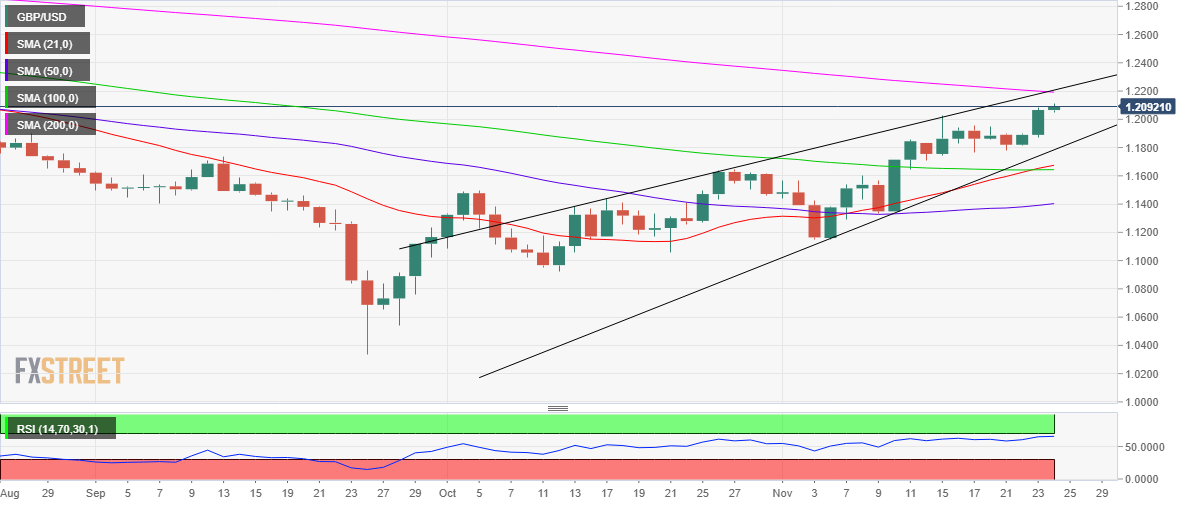
On the flip side, bears need a sustained move below the 1.2050 support area to negate the upbeat momentum. The downside will then open up toward the lower boundary of the rising wedge at 1.1784.
The next relevant cushion is seen at the confluence of the 21 and 100-Daily Moving Averages (DMA) at around 1.1660.
GBP/USD: Additional technical levels
EUR/USD has broken above 1.0400. The cuurency pair could extend its race higher to the 1.0500/50 area in the near term, in the opinion of analysts at ING.
Return towards parity likely in December
“EUR/USD may extend its rally to 1.0500/1.0550 in the near term, but we suspect the bullish trend may start to run out of steam as we approach year-end.”
“A return towards parity remains our base case for December.”
See: EUR/USD to see small fluctuations around the 1.03 level – Commerzbank
Following the release of the German IFO Business Survey, the institute’s Economist Klaus Wohlrabe said that “the German economy is sending signals of hope.”
Additional quotes
59.3% of companies surveyed complained about supply bottlenecks in November vs 63.8% in October.
46.8% of companies surveyed want to raise prices in the coming three months, pressure to increase prices is sinking continuously.
Industry export expectations rose just into positive territory.
Retailers and hospitality sectors showing small signs of hope, state support helps.
- EUR/USD may extend its rally to 1.0500/1.0550 in the near term – ING
- German IFO Business Climate Index came in at 86.3 in November.
- IFO Current Economic Assessment for Germany rose to 93.1 this month.
- November German IFO Expectations Index arrived at 80.0, beating estimates.
The headline German IFO Business Climate Index climbed to 86.3 in November versus the previous reading of 84.5 and the market consensus of 85.0.
Meanwhile, the Current Economic Assessment improved to 93.1 points in the reported month when compared to October's 84.2 and 93.8 expected.
The IFO Expectations Index – indicating firms’ projections for the next six months, rose to 80.0 in November from the last month’s 75.9 and against the estimates of 77.0.
Market reaction
EUR/USD shrugs off the upbeat German IFO survey. At the time of writing, the pair is trading at 1.0412, up 0.19% on the day.
About German IFO
The headline IFO business climate index was rebased and recalibrated in April after the IFO Research Institute changed the series from the base year of 2000 to the base year of 2005 as of May 2011 and then changed the series to include services as of April 2018. The survey now includes 9,000 monthly survey responses from firms in the manufacturing, service sector, trade and construction.
- The index adds to the weekly pullback and breaches 106.00.
- US markets will be closed due to the Thanksgiving Day holiday.
- The dollar remains depressed following FOMC Minutes.
The greenback loses ground for the third session in a row and breaks below the 106.00 support when gauged by the USD Index (DXY).
USD Index looks offered post-Minutes
The index trades in multi-day lows in the sub-106.00 zone amidst the tenacious improvement in the risk-associated universe and already approaches the November low near 105.30, just ahead of the critical 200-day SMA, today at 105.27.
In the meantime, the dollar remains offered in the current post-FOMC Minutes context, where participants agreed that a slower pace of future interest rate hikes could be appropriate to better assess the progress of the ongoing normalization of the Fed’s monetary conditions.
It is worth recalling, however, that FOMC members still see the ultimate level of the interest rates higher than previously thought.
What to look for around USD
The dollar extends the pronounced drop from Monday’s peaks around the108.00 barrier and already trades in the area below the 106.00 yardstick pari passu with the persistent recovery in the risk-linked galaxy.
While hawkish Fedspeak maintains the Fed’s pivot narrative in the freezer, upcoming results in US fundamentals would likely play a key role in determining the chances of a slower pace of the Fed’s normalization process in the short term.
Key events in the US this week: Thanksgiving Day holiday (Thursday).
Eminent issues on the back boiler: Hard/soft/softish? landing of the US economy. Prospects for further rate hikes by the Federal Reserve vs. speculation of a recession in the next months. Fed’s pivot. Geopolitical effervescence vs. Russia and China. US-China persistent trade conflict.
USD Index relevant levels
Now, the index is retreating 0.15% at 105.94 and the breakdown of 105.34 (monthly low November 15) would open the door to 105.27 (200-day SMA) and finally 104.63 (monthly low August 10). On the other hand, the next up barrier comes at 107.99 (weekly high November 21) followed by 109.16 (100-day SMA) and then 110.55 (55-day SMA).
Gold price eyes more upside amid light trading on Thanksgiving Day after dovish US Federal Reserve minutes and weak United States data down the US Dollar and US Treasury bond yields, FXStreet’s Dhwani Mehta reports.
United States data, Federal Reserve minutes smash USD
“The US Dollar and US Treasury bond yields are reeling from the pain inflicted by the dovish US Fed November meeting minutes and discouraging top-tier US economic releases. The highly-influential United States events almost sealed in a 50 basis points (bps) rate hike by the Fed in December, triggering a sharp sell-off in the USD alongside the US Treasury bond yields while powering the upswing in XAU/USD. Lower rates tend to benefit the non-interest-bearing Gold price.”
“The market sentiment remains cautiously optimistic, as the Federal Reserve’s dovishness overshadows China’s covid concerns, as traders from the United States move on the sidelines to celebrate Thanksgiving Day.”
According to Economist Lee Sue Ann and Markets Strategist Quek Ser Leang at UOB Group, the positive outlook for NZD/USD remains unchanged above the 0.6145 level for the time being.
Key Quotes
24-hour view: “We expected NZD to edge higher yesterday but we were of the view that it ‘is unlikely to break the major resistance at 0.6200’. However, NZD took out 0.6200 and surged to 0.6250. Upward momentum is strong and we expect NZD to rise further. That said, overbought conditions suggest 0.6300 could be out of reach today. Support is at 0.6220, followed by 0.6190.”
Next 1-3 weeks: “Our latest narrative was from last Friday (18 Nov, spot at 0.6135) where NZD is likely to consolidate and trade within a range of 0.6035/0.6200. Yesterday (23 Nov), NZD surged above 0.6200. The price actions indicate that the consolidation phase has ended. In other words, we anticipate NZD gains from here, likely to 0.6200, possibly 0.6240. The upside risk is intact as long as NZD does not move below 0.6145 (‘strong support’ level).”
The South African Reserve Bank (SARB) will hike its key rate further from 6.25%. A 75 basis points hike could support the Rand, economists at Commerzbank report.
A rate hike of 50 bps is unlikely to affect the Rand
“The decision is likely to be quite narrow, although we consider it likely that the SARB will switch down a gear. At the same time, the model-based rate outlook is likely to be corrected to the upside to signal further rate hikes.”
“As a rate hike of 50 bps seems to be largely priced in on the market this is unlikely to affect the Rand much, in particular, if the vote, statement and rate outlook seem sufficiently hawkish.”
“A surprise hike in the key interest rate by 75 bps to 7% from a market perspective could give the Rand a boost, at least for a short time.”
Riksbank is expected to hike its key rate by 75 basis points. The decision is unlikely to provide lasting support to the Krona, but another leg higher in SEK could be seen in the coming days, economists at ING report.
Riksbank to hike by 75 bps
“We expect a 75 bps hike, which appears to be very much a consensus call. We did see the RB surprise with a 100 bps move earlier this year, but that would likely be a risky move given the strains in the Swedish housing market.”
“We don’t expect major and long-lasting implications from today’s policy decision for the Krona, which is currently enjoying a rather unique combination of positive factors (on the European and global risk sentiment side).”
“We could see a further leg higher in SEK in the coming days, but our longer-term view remains that the Krona will underperform as the eurozone enters a prolonged recession in 2023. We forecast a sustained return to levels below 10.50 in EUR/SEK only in the second half of next year.”
See – Riksbank Preview: Forecasts from five major banks, another big rate hike
Chinese Commerce Minister Wang Wentao expressed concerns over US trade restrictions against China during talks with US Trade Representative Katherine Tai last week.
Wang said he “hopes to push Sino-US. economic and trade relations back to the healthy and stable track.”
Market reaction
AUD/USD is unfazed by the above comments, consolidating the upside near 0.6750. At the press time, the pair is up 0.35% on the day.
US Dollar stays under pressure on thin holiday trading. Economists at Commerzbank expect the EUR/USD pair to hover around the 1.03 mark.
Sit back and relax, it is likely to get a bit dull
“In view of the Thanksgiving weekend, there is no data due for publication in the US. However, we are unlikely to see anything earth-shattering from the eurozone either.”
“I expect quiet Dollar markets until the weekend with small fluctuations in EUR/USD around the 1.03 level. So, let’s sit back and relax as it might get a bit dull.”
The main event today will be the Riksbank meeting, where a 75 basis points hike is widely expected. However, only a 100 bps increase will strengthen the Swedish Krona, economists at Commerzbank report.
Not much support for Krona from hawkish Riksbank?
“As market expectations have also moved in the direction of 75 bps for today’s meeting and as it is clear that the Riksbank will probably hike the rate path I see little appreciation potential for Krona. For that to happen the expected peak of interest rates would have to be moved well above the 3% level with the statement sounding hawkish – something the Riksbank might want to avoid though with a view to the housing market.”
“If, however, today results in 100 bps combined with a significant move in Riksbank key rate expectations to the upside EUR/SEK might finally move away from the 11 mark again on a sustainable basis.”
See – Riksbank Preview: Forecasts from five major banks, another big rate hike
Open interest in natural gas futures markets rose by around 5.6K contracts on Wednesday, setting aside the previous pullback according to preliminary readings from CME Group. In the same line, volume went up by around 88.3K contracts and maintained the ongoing erratic performance.
Natural Gas now focuses on $8.00 and above
Wednesday’s strong advance in prices of natural gas reached multi-week highs around $7.60. The move was against the backdrop of increasing open interest and volume, indicative that the rally remains well and sound for the time being. That said, the next hurdle for the commodity is seen at the $8.00 mark per MMBtu in the very near term.

Here is what you need to know on Thursday, November 24:
Pressured by the disappointing macroeconomic data releases and the dovish tone seen in the FOMC Minutes, the US Dollar suffered heavy losses against its rivals with the US Dollar Index (DXY losing nearly 1% on Wednesday. The DXY stays on the back foot early Thursday and continues to edge lower despite thin holiday trading. Bond and stock markets in the US will be closed in observance of the Thanksgiving Day holiday. The European economic docket will feature IFO sentiment surveys and the European Central Bank will publish the Monetary Policy Meeting Accounts.
The data published by S&P Global revealed on Wednesday that the business activity in the US private sector contracted sharply in November. Commenting on the data, "business conditions across the US worsened in November," noted Chris Williamson, Chief Business Economist at S&P Global Market Intelligence. "According to the preliminary PMI survey findings, with output and demand falling at increased rates, consistent with the economy contracting at an annualised rate of 1%."
The US Dollar selloff that was triggered by gloomy PMI surveys intensified later in the day after the minutes of the US Federal Reserve's latest policy meeting revealed that most policymakers backed slowing the pace of rate increases soon. According to the CME Group FedWatch Tool, the probability of a 50 basis points Fed rate hike in December currently stands at 76%. The 10-year US Treasury bond yield fell nearly 2% and closed the day below 3.7%. Meanwhile, Wall Street's main indexes closed higher, reflecting the positive impact of the Fed's publication on risk sentiment.
EUR/USD capitalized on the broad-based selling pressure surrounding the US Dollar and climbed to a fresh weekly high above 1.0400. The pair continues to edge higher toward 1.0450 early Thursday.
GBP/USD gained nearly 200 pips on Wednesday and broke above 1.2000. The pair was last seen trading at its highest level since mid-August near 1.2100.
USD/JPY fell sharply for the second straight day on Wednesday and erased all of its weekly gains. The pair continues to push lower early Thursday and fluctuates below 139.00.
Gold price took advantage of falling US Treasury bond yields and closed above $1,750 on Wednesday. XAU/USD edges higher toward $1,760 in the European morning.
The risk-positive market environment helped Bitcoin find demand and BTC/USD was last seen gaining nearly 1% on the day at around $16,700. Similarly, Ethereum is up already more than 2% on the day at $1,200 after having gained 4% on Wednesday.
- USD/JPY remains pressured around weekly low, down for the third consecutive day.
- Mixed data from Japan, absence of bond traders failed to stop bears amid broad-based US Dollar weakness.
- Concerns surrounding Fed’s next move, China underpin cautious optimism, weigh on the USD.
USD/JPY holds lower ground near the weekly bottom surrounding 138.60 during the initial hour of Thursday’s European session. In doing so, the Yen pair prints a three-day losing streak amid broad US Dollar weakness while ignoring mixed numbers from Tokyo.
Japan’s manufacturing activity shrunk at the fastest pace in two years in November while the activity of the services industry also eased. That said, Japan’s Jibun Bank Manufacturing PMI dropped to 49.4 versus 50.7 prior release and forecasts. Further, the Services counterpart flashed the 50.00 figure compared to 53.1 expected and 53.2 previous readings.
Additionally, Japan’s Coincident Index rose past 101.1 market forecasts to 101.4, versus an upwardly revised 101.8 prior, whereas the Leading Economic Index came in as 97.5 compared to 97.4 expectations and 101.30 previous figures.
That said, easing fears of the US Federal Reserve’s (Fed) aggressive rate hikes, especially after the previous day’s Federal Open Market Committee (FOMC) Meeting Minutes, keeps the USD/JPY hopeful. On the same line are the hopes for Chinese government stimulus and a cut to the People’s Bank of China’s (PBOC) Reserve Requirement Ratio (RRR), as well as hopes of quick recovery from the COVID-19-led grim economic conditions.
It should be noted that the S&P 500 Futures join firmer Asia-Pacific shares to print mild gains and weigh on the US Dollar but the Treasury yields are inactive amid the Thanksgiving holiday. Further, the US Dollar Index (DXY) remains pressured towards the monthly low near 105.35, around the weekly low of 105.63 by the press time.
Moving on, a lack of major data/events and holiday mood in the US might challenge the USD/JPY bears. Even so, headlines surrounding China and Japan could entertain the Yen pair traders.
Technical analysis
A U-turn from the 38.2% Fibonacci retracement level of the May-October upside, a clear downside break of the 100-DMA and bearish MACD signals favor USD/JPY bears.
Also read: USD/JPY Price Analysis: Bears approach 138.40 key support
Gold price is rejoicing fresh bids above the $1,750 psychological level. As FXStreet’s Dhwani Mehta notes, bull flag opens doors toward $1,787.
Bull flag breakout and bullish crossover on the daily chart
“Gold price finally yielded a bull flag confirmation after closing Thursday above falling trendline resistance, then at $1,737. The upside break opens doors toward the three-month high of $1,787. Although bulls will need to clear this week’s high near $1,770, at first.”
“Adding credence to the bullish potential, the upward-sloping 21-Daily Moving Average (DMA) crossed the mildly bearish 100DMA for the upside, validating a bull cross.”
“On the flip side, a strong cushion is seen at Monday’s low of $1,733, below which the confluence of the 21 and 100DMAs at $1,712 will be challenged. The last line of defense for XAU/USD is seen at the November 10 low of $1,703.”
USD/TRY remains pressured around 18.60, down for the third consecutive day, as traders prepare for the Interest Rate Decision from the Central Bank of the Republic of Turkiye (CBRT).
That said, the Turkish central bank is likely to keep diverging from its global counterparts, despite strong inflation, as market consensus suggests a third consecutive rate cut to 9.0%, from 10.5% current level.
In addition to the pre-CBRT consolidation, the bearish signals from the options market also weigh on the USD/TRY prices.
The one-month risk reversal (RR), a gauge of the difference between the call options and the put options, drop to -0.030 level at the latest. However, the weekly RR prints +0.050 figure to consolidate the biggest loss since late August marked in the last week.
On an immediate basis, Turkiye’s Capacity Utilization and Manufacturing Confidence for November could act as catalysts.
Considering advanced prints from CME Group for crude oil futures markets, traders added around 7.1K contracts to their open interest positions and reversed at the same time three daily pullbacks in a row. Volume followed suit and went up by more than 242K contracts after two consecutive daily drops.
WTI now targets the 2022 low near $74.00
Prices of the WTI dropped strongly and breached the key $80.00 mark per barrel on Wednesday. The sharp pullback was reinforced by increasing open interest and volume and signals that further weakness lies ahead in the very near term. That said, the WTI could slip back and revisit the YTD low at $74.30 (January 3).
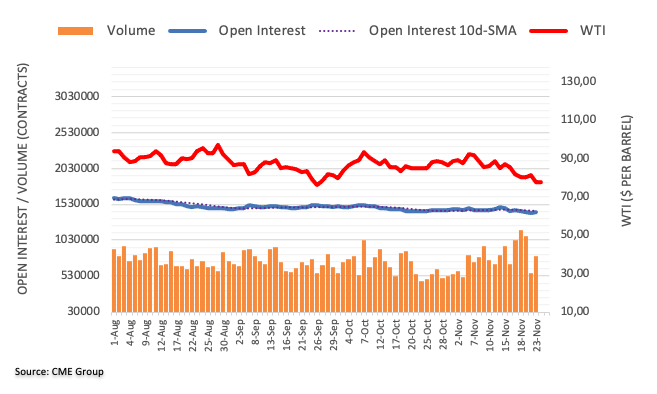
- Gold price consolidates intraday gains during three-day uptrend.
- Market sentiment remains positive amid hopes of easy Fed rate hikes, more stimulus from China.
- XAU/USD bulls may struggle amid Thanksgiving Day holiday.
Gold price (XAU/USD) pares intraday gains around $1,753 during the early hours of Thursday morning in Europe. Even so, the precious metal prints a three-day winning streak amid the market’s cautious optimism.
The commodity’s latest pullback could be linked to the consolidation ahead of the European session openings, after witnessing a sluggish Thursday due to the Thanksgiving holiday. Also likely to test the XAU/USD bulls are the Covid fears from China.
However, receding fears of the US Federal Reserve’s (Fed) aggressive rate hikes, especially after the previous day’s Federal Open Market Committee (FOMC) Meeting Minutes, keep the gold buyers hopeful. On the same line are the hopes for Chinese government stimulus and a cut to the People’s Bank of China’s (PBOC) Reserve Requirement Ratio (RRR), as well as hopes of quick recovery from the COVID-19-led grim economic conditions.
Amid these plays, the S&P 500 Futures join firmer Asia-Pacific shares to print mild gains but the Treasury yields are inactive amid the Thanksgiving celebration in the US. Further, the US Dollar Index (DXY) remains pressured towards the monthly low near 105.35, around the weekly low of 105.63 by the press time.
Looking forward, a light calendar and holiday mood in the US could challenge the gold traders but the buyers are likely to keep the reins.
Technical analysis
Although 50-SMA challenges the immediate upside of the Gold price near $1,758, a clear upside break of the one-week-old descending trend line joins bullish MACD signals to keep the buyers hopeful. Also suggesting the XAU/USD’s further advances is the previous day’s U-turn from the 100-SMA.
Hence, the latest pullback could aim for the previous resistance line, around $1,737, and will be less problematic unless the quote stays beyond the 100-SMA level of $1,724.
Following that, the 50% and 61.8% Fibonacci retracement levels of the metal’s November 03-15 upside, respectively near $1,700 and $1,680, could challenge the Gold bears.
Meanwhile, an upside clearance of the immediate 50-SMA hurdle surrounding $1,758 could quickly propel the bullion prices toward the monthly high near $1,787.
In a case where the Gold price refreshes monthly top, highs marked in August around $1,808 will be in focus.
Gold price: Four-hour chart
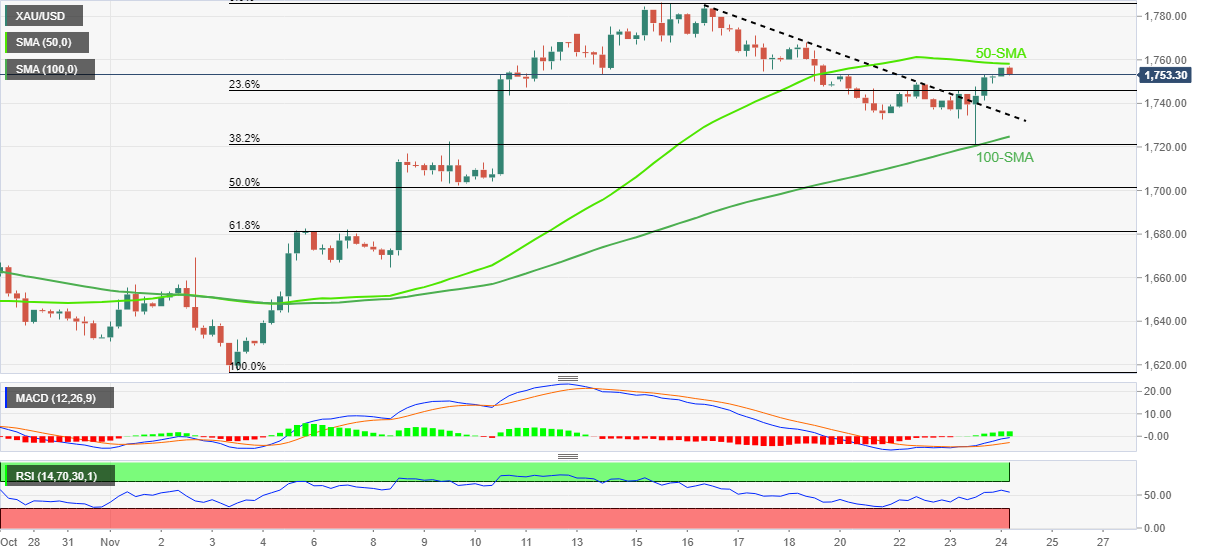
Trend: Bullish
In the opinion of Economist Lee Sue Ann and Markets Strategist Quek Ser Leang at UOB Group, GBP/USD is expected to climb further and could revisit 1.2200 in the next weeks.
Key Quotes
24-hour view: “While we expected GBP to strengthen yesterday, we were of the view that it ‘is unlikely to break the major resistance at 1.1940’. However, GBP blew past 1.1940 and rocketed to a high of 1.2080. There is room for GBP to strengthen further but in view of the deeply overbought conditions, the next major resistance at 1.2200 is unlikely to come into view (there is another resistance at 1.2140). On the downside, a breach of 1.1975 (minor support is at 1.2025) would indicate that the strong rally is ready to take a breather.”
Next 1-3 weeks: “Our latest narrative was from Tuesday (22 Nov, spot at 1.1825) where GBP is likely to trade between 1.1680 and 1.1940 for the time being. Yesterday (23 Nov), GBP lifted off and rocketed past 1.1940 (high has been 1.2080). The rapid accumulation of momentum suggests GBP is likely to strengthen further in the coming days. The level to monitor is at 1.2200. The upside risk is intact as long as GBP does not move below 1.1930 (‘strong support’ level).”
FX option expiries for Nov 24 NY cut at 10:00 Eastern Time, via DTCC, can be found below.
- EUR/USD: EUR amounts
- 1.0350 411m
- 1.0380 489m
- 1.0400 606m
- GBP/USD: GBP amounts
- 1.1330 319m
- 1.1605 357m
- USD/JPY: USD amounts
- 140.30 765m
- 141.15 600m
- USD/CHF: USD amounts
- 0.9500 495m
- AUD/USD: AUD amounts
- 0.6500 366m
- 0.6585 381m
- 0.6600 296m
- 0.6675 349m
- NZD/USD: NZD amounts
- 0.5600 485m
CME Group’s flash data for gold futures markets noted open interest extended the decline for yet another session on Wednesday, this time by around 1.3K contracts. Volume, instead, remained choppy and went up by around 32.3K contracts.
Gold faces solid resistance around $1,750
Gold prices advanced markedly on Wednesday and briefly revisited the $1,750 region. The daily uptick was on the back of shrinking open interest, however, and hinted at the possibility of a near term correction in the current rebound. On the downside, the weekly low at $1,727 (November 23) should offer initial contention for the time being.
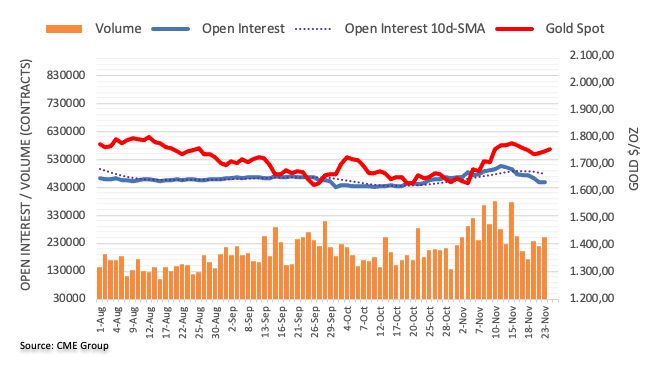
- Oil prices have surrendered their juggernaut recovery recorded after hitting a fresh 11-month low of $75.28.
- A significant rise in Covid-19 infections in China has escalated fears of a decline in oil demand.
- Nomura has lowered China's GDP growth forecast for 2022 and 2023 to 2.8% and 4.0% respectively.
West Texas Intermediate (WTI), futures on NYMEX, have sensed selling pressure after a weak rebound to near $78.00 in the early European session. On Wednesday, the oil prices witnessed a perpendicular downside move after failing to sustain above the critical hurdle of $81.00.
Earlier, the black gold witnessed a juggernaut recovery after printing a fresh 11-month low at $75.28. The firmer responsive buying action was propelled by escalating supply worries. Chatters over intervention by the OPEC+ in the oil market to support oil prices from its imbalanced movements got confirmed after Saudi Energy Minister said that the current OPEC+ deal will continue till the end of 2023.
According to the OPEC+ deal, the oil exporting countries agreed to cut production by two million barrels each day to boost oil prices. The street expected that the move is likely to disturb the current demand-supply mechanism, therefore, the oil prices were shaping themselves to turn efficient.
The recovery has been surrendered as Covid-19 infections have soared dramatically in China. It is reported that China's daily COVID cases rose to 29,754, the highest of the pandemic, so far. The easing norms by the Chinese administration are expected to be rolled back to curtail the spread.
China’s doctors have a blunt message for Xi Jinping: the country’s healthcare system is not prepared to deal with a huge nationwide coronavirus outbreak that will inevitably follow any easing of strict measures to contain Covid-19, as reported by Financial Times after it interviewed a dozen of health professionals.
Citing Covid-19 risks, Nomura has lowered China's GDP growth forecast for 2022 and 2023 to 2.8% and 4.0% respectively.
Economist Lee Sue Ann and Markets Strategist Quek Ser Leang at UOB Group suggest the next target of note for EUR/USD emerges at the 1.0480 level in the near term.
Key Quotes
24-hour view: “We highlighted yesterday that ‘the rebound in EUR has scope to extend but the major resistance at 1.0375 is unlikely to come into view’. The anticipated advance exceeded our expectations as EUR soared to a high of 1.0404. Strong upward momentum suggests further EUR strength even though last week’s high of 1.0480 is likely out of reach today (there is another resistance level at 1.0440). Support is at 1.0360, a breach of 1.0335 would indicate that the current upward pressure has eased.”
Next 1-3 weeks: “Yesterday (23 Nov, spot at 1.0305), we held the view that EUR is likely to trade within a range of 1.0180/1.0375. We did not expect the rapid manner in which EUR soared above 1.0375 (high has been 1.0404). The rapid build-up in momentum is likely to lead to further EUR gains. The level to monitor is last week’s high of 1.0480. The upside risk is intact as long as EUR does not move below the ‘strong support’ level, currently at 1.0300. On a shorter-term note, 1.0335 is already a strong support level. Looking ahead, the next resistance above 1.0480 is at 1.0560.”
- USD/CHF extends week-start pullback towards the monthly low.
- Three-month-old horizontal area challenges sellers amid oversold RSI, 200-DMA restricts buyer’s entry.
- 61.8% and 78.6% Fibonacci retracement levels act as additional trading filters.
USD/CHF takes offers to refresh the weekly low near 0.9390 as sellers cheer the third consecutive daily fall heading into Thursday’s European session.
In doing so, the Swiss Franc (CHF) pair extends Tuesday‘s U-turn from 0.9600, as well as the previous day’s downside break of the 61.8% Fibonacci retracement level of January-November upside. That said, the bearish MACD signals add strength to the downside bias.
However, nearly oversold conditions of the Relative Strength Index (RSI), placed at 14, suggest limited downside room for the USD/CHF pair.
As a result, an area comprising lows marked during August and so far in November, around 0.9370-55, gains the major attention of the bears.
If at all the USD/CHF bears conquer the 0.9355 support, the 78.6% Fibonacci retracement level near 0.9310 and the 0.9300 round figure could act as additional downside filter to challenge the pair’s further declines.
On the contrary, March’s high of 0.9460 acts as an immediate upside hurdle for the USD/CHF bulls, a break of which could escalate the corrective bounce towards the 61.8% Fibonacci retracement level near 0.9500.
However, the pair buyers are likely to remain indecisive unless witnessing a clear upside break of the 200-DMA, around 0.9635, at the latest.
USD/CHF: Daily chart
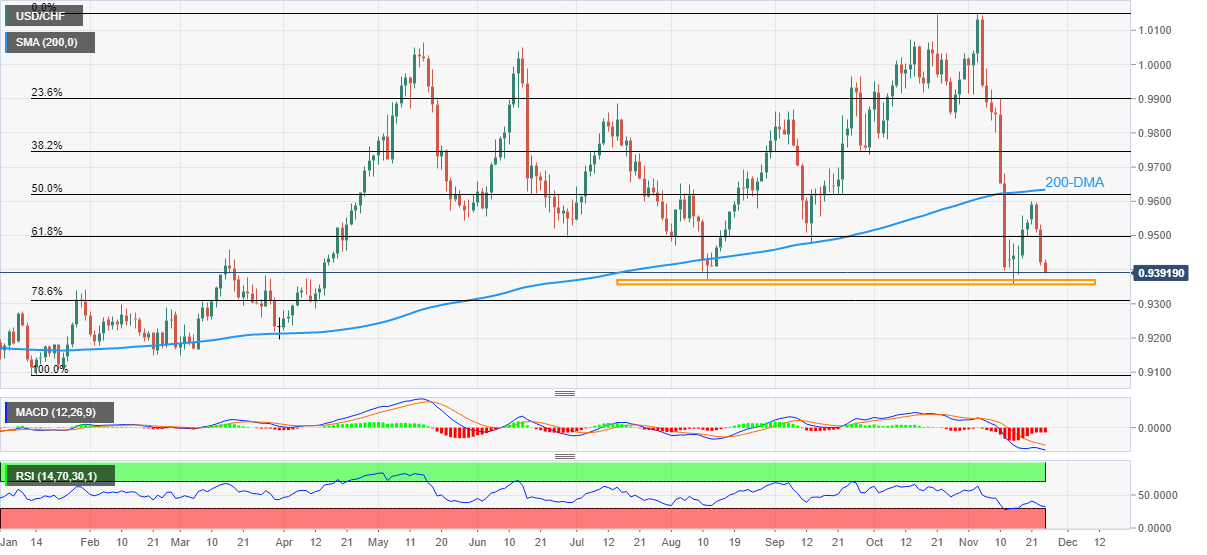
Trend: Limited downside expected
- AUD/USD is inching strongly towards the crucial hurdle of 0.6800 as US Dollar is facing immense selling pressure.
- The US Dollar is exposed to test a three-month low at 105.34 amid a risk appetite theme.
- Economists at ANZ Bank believe that the sell-off in US Dollar is exaggerated as current inflation is well above 2% target.
The AUD/USD pair is marching firmly towards the round-level hurdle of 0.6800 in the early European session. The asset has gained immense buying interest from the market participants as the US dollar index (DXY) has extended its losses. A stellar improvement in investors’ risk appetite has underpinned the Aussie Dollar. The major has continued its two-day winning spell and is prepared to display more upside amid upbeat market sentiment.
The US Dollar has displayed sheer losses after surrendering the critical support of 106.00. The mighty US Dollar has dropped to near 105.70 and is exposed to test the three-month low of 105.34. S&P500 futures are holding their gains recorded in Tokyo. The 500-stock basket is expected to remain quiet as US markets will remain closed on Thursday on account of Thanksgiving Day. The 10-year US Treasury yields are hovering below 3.69%.
Less-hawkish opinions by the Federal Reserve (Fed) policymakers as recorded in Federal Open Market Committee (FOMC) minutes have cleared that days of a bigger rate hike by the US central bank are over. To reduce financial risks and to observe the efforts made by Fed in decelerating inflation yet, teammates of Fed chair Jerome Powell have vouched for slowing down the interest rate hike pace.
Economists at ANZ Bank have a contrary opinion as they believe that softer-than-expected US inflation triggered a sell-off in the US Dollar and market reaction to the latest inflation print is exaggerated. Inflation remained near 7.7%, which is well above the central bank’s target of 2%. They further added that “It is not enough for the Fed to be confident that inflation is on track to move back to 2% sustainably”.
On the Aussie front, weaker S&P PMI data has not impacted the Aussie Dollar. The Manufacturing PMI landed at 51.5, lower than the expectations of 52.4. While Services PMI dropped to 47.2 vs. the consensus of 49.1.
- EUR/USD extends 200-DMA breakout towards the monthly high.
- Concerns surrounding China, Fed underpin market’s firmer sentiment.
- Cautious optimism, softer US Dollar favor three-day winning streak.
- Germany’s IFO Sentiment figure, ECB Monetary Policy Meeting Accounts eyed for clear directions.
EUR/USD bulls are in full mood to refresh the monthly top during the three-day uptrend, up 0.40% intraday near 1.0440 heading into Thursday’s European session. The major currency pair’s latest gains could be linked to the risk-on mood, as well as broad-based US Dollar weakness.
Market sentiment improves amid receding fears of the US Federal Reserve’s (Fed) aggressive rate hikes, especially after the previous day’s Federal Open Market Committee (FOMC) Meeting Minutes. Also likely to underpin the cautious optimism are hopes of Chinese government stimulus and a cut to the People’s Bank of China’s (PBOC) Reserve Requirement Ratio (RRR).
While portraying the mood, the S&P 500 Futures join firmer Asia-Pacific shares to print mild gains but the Treasury yields are inactive amid the Thanksgiving celebration in the US.
On the other hand, upbeat prints of the bloc’s activity numbers for November contrasted with the softer PMIs for the United States, published on Wednesday, also keep the EUR/USD buyers hopeful.
It’s worth observing, however, that the EUR/USD Risk Reversal (RR), a gauge of call options to put one, braces for the second weekly negative, suggests the bears aren’t off the table. As a result, today’s readings of German IFO sentiment numbers for November and details of the European Central Bank (ECB) Monetary Policy Meeting Accounts, will be closely observed for clear directions.
While the softer statistics from the bloc’s powerhouse may allow the EUR/USD bulls to take a breather, the recently hawkish calls from the ECB policymakers contrast with the Fed minutes and favor the expectations of witnessing further upside.
Technical analysis
A successful upside break of the 200-DMA, currently around 1.0395, directs EUR/USD buyers toward the monthly peak of 1.0481. However, nearly overbought RSI (14) may challenge the pair’s further upside.
- NZD/USD has surpassed the crucial hurdle of 0.6250 amid solid risk-on impulse.
- Federal Reserve policymakers are supporting the interest rate hike slowdown regime to reduce financial risks.
- The Reserve Bank of New Zealand sees the interest rate peak at 5.5%.
- NZD/USD is aiming to smash the round-level resistance of 0.6300 as RBNZ-Fed policy divergence has widened.
NZD/USD is advancing firmly after overstepping the critical resistance of 0.6250 in the Asian session. The Kiwi Dollar has gained significant traction as the extent of optimism is skyrocketing in the currency market. The asset has continued its two-day winning streak and has refreshed its three-month high at 0.6270. The major is exposed to kiss the round-level resistance of 0.6300 amid no signs of amelioration in the positive market sentiment.
A significant jump in investors’ risk appetite has weakened demand for the US Dollar. The US Dollar Index (DXY) is falling like a house of cards and has surrendered the cushion of 106.00. The mighty US Dollar is looking to test three month low at 105.34. Meanwhile, S&P500 futures are displaying strength ahead of the US holiday on account of Thanksgiving Day. The 10-year US Treasury yields have slipped below 3.69% as investors see no continuation of 75 basis points (bps) rate hike spell for the fifth time by the Federal Reserve (Fed).
Federal Reserve policymakers vouched for decelerating interest rate hike pace
A satisfactory October inflation report has eased some troubles for the Federal Reserve policymakers. Fed chair Jerome Powell and his mates are continuously making efforts to bring price stability. A decline in the headline Consumer Price Index (CPI) has delighted the Federal Reserve, which is visible in Federal Open Market Committee (FOMC) minutes. The majority of Federal Reserve policymakers have vouched for a slowdown in the interest rate hike pace to reduce financial risks and to observe the progress of efforts yet made in the form of restrictive policy measures.
This has resulted in a significant fall in the US Dollar. Considering the persistent nature of inflation in the United States economy, Fed chair Jerome Powell will shift to a half-percent rate hike extent for December’s monetary policy meeting.
Upbeat United States Durable Goods Orders failed to cushion the US Dollar
Market participants always await indicators that depict demand by the households to make projections for Consumer Price Index (CPI) figures. The United States Durable Goods Orders data that display consumer demand for durables improved by 1% in October vs. the expectation and the prior release of 0.4%. This indicates that the consumer demand is robust and core CPI could display stagnancy ahead. This may end the plan of decelerating interest rates by the Federal Reserve.
It is worth noting that households in the United States are addressing expenses with lower real income. Also, higher interest rates will result in higher interest obligations on purchases of durable goods, which could result in accelerating delinquency costs for credit providers.
Reserve Bank of New Zealand sees interest rate peak at 5.5%
On Wednesday, Reserve Bank of New Zealand Governor Adrian Orr hiked its Official Cash Rate (OCR) by 75 bps. This has widened the Reserve Bank of New Zealand-Federal Reserve policy divergence. In order to tighten its fight against a historic surge in inflation, the Reserve Bank of New Zealand ditched its 50 bps rate hike regime and went for a bigger rate hike. Earlier, the RBNZ hikes its OCR 50 bps consecutively five times. Price pressure in the New Zealand economy has not displayed signs of exhaustion and a peak yet, therefore, policy tightening will continue to accelerate further. The Reserve Bank of New Zealand has also provided an interest rate peak of 5.5%.
Widened Reserve Bank of New Zealand-Federal Reserve policy divergence and hawkish interest rate guidance is likely to strengthen the Kiwi Dollar further and NZD/USD may smash 0.6300 sooner.
NZD/USD technical outlook
-638048631844073420.png)
NZD/USD is marching towards the horizontal resistance placed from August 12 high at 0.6469 on a daily scale. The asset has comfortably established above the 61.8% Fibonacci retracement (placed from August 12 high at 0.6469 to October 13 low at 0.5560) at 0.6103. The pair has crossed the 200-period Exponential Moving Average (EMA) at 0.6233 for the first time in the past seven months.
Meanwhile, the Relative Strength Index (RSI) (14) is oscillating in a bullish range of 60.00-80.00, which indicates more upside for the Kiwi Dollar.
- USD/CAD holds lower ground nearly weekly bottom, eyes further downside.
- U-turn from 21-DMA, support-turned-resistance line from August favor sellers.
- 100-DMA, 61.8% Fibonacci retracement level lure the bears.
USD/CAD prints a three-day downtrend as it refreshes the weekly low around 1.3330 heading into Thursday’s European session.
In doing so, the Loonie pair justifies the early-week pullback from the 21-DMA, as well as the previous support line from August. Also keeping the USD/CAD pair sellers hopeful are the bearish MACD signals.
With this, the Loonie pair sellers are on their way to the 100-DMA support surrounding 1.3265.
However, the tops marked during early September join the 61.8% Fibonacci retracement level of the pair’s August-October upside to highlight the 1.3200 threshold as a tough nut to crack for the USD/CAD bears.
In a case where the pair breaks the 1.3200 key support, the odds of its slump to the sub-1.3000 region can’t be ruled out.
Alternatively, recovery moves could initially aim for the 21-DMA hurdle surrounding 1.3455 before aiming for the support-turned-resistance line near 1.3490.
Even if the quote remains firmer past 1.3490, the 38.2% Fibonacci retracement level near 1.3500 could challenge the USD/CAD bulls before giving them control.
Overall, USD/CAD is likely to extend the latest weakness but the downside room appears limited.
USD/CAD: Daily chart
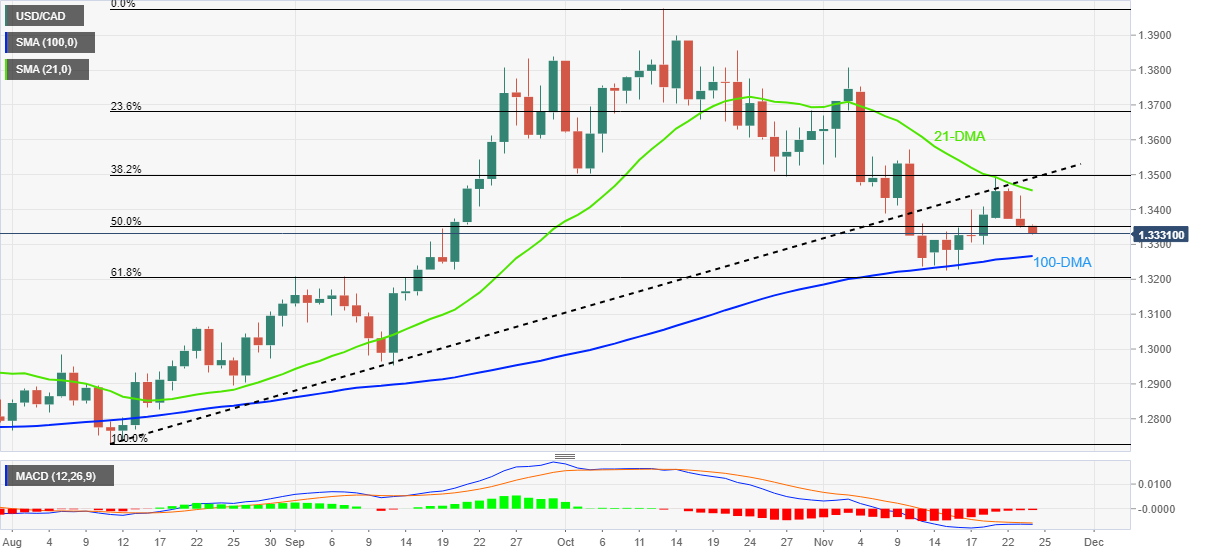
Trend: Further downside expected
- Asia-Pacific shares remain firmer after FOMC Minutes flagged pivot discussions.
- China’s covid cases surge but hope of RRR cut, additional stimulus measures keep buyers hopeful.
- Japan’s manufacturing activity shrunk at the fastest pace in two years, BOK lifts benchmark rate by 25 bps.
Market sentiment in Asia improved during early Thursday amid a lack of major catalysts. That said, hopes of more stimulus from China and the chatters surrounding easy rate lifts also underpin the market’s cautious optimism.
As per the latest Federal Open Market Committee (FOMC) Meeting Minutes, the majority of the policymakers discussed the need of slowing down the interest rate hikes, which in turn propelled the risk-on mood. Additionally weighing on the Greenback were chatters over the “sufficiently restrictive” level of the Federal Reserve’s (Fed) interest rates.
Elsewhere, hopes of Chinese government measures to ease the pains of the real estate and financial sector, as well as chatters surrounding a cut to the People’s Bank of China’s (PBOC) Reserve Requirement Ratio (RRR), seemed to have favored the risk-on mood.
Amid these plays, MSCI’s index of Asia-Pacific shares outside Japan extends the previous day’s recovery whereas Japan’s Nikkei 225 rise 1.10% intraday by the press time.
It’s worth noting that preliminary readings of Japan’s Jibun Bank Manufacturing PMI dropped to 49.4 versus 50.7 prior release and forecasts, which in turn suggests a stack decline in Tokyo’s manufacturing activities.
Stocks in China are the biggest gainers while South Korea’s KOSPI fails to justify the Bank of Korea’s rate hike. Further, equities in Australia and India are also up while shares from New Zealand ignore hawkish comments from Reserve Bank of New Zealand (RBNZ) Governor Adrian Orr.
On a different page, a holiday in the US and a light calendar elsewhere join the mixed performance of oil prices to challenge momentum traders. However, hopes of easy rates keep equity traders positive during sluggish early hours of the day.
Also read: S&P 500 Futures print mild gains, Treasury yields struggle amid Fed, Covid chatters on Thanksgiving Day
- USD/INR holds lower ground near intraday bottom after two-day downtrend.
- Clear break of two-week-old ascending trend line favors intraday sellers to aim for 50-SMA.
- 200-SMA acts as an extra filter towards the north.
USD/INR remains pressured for the third consecutive day, holding lower ground near the intraday bottom of 81.60 during early Thursday in Europe.
In doing so, the Indian Rupee (INR) pair justifies the previous day’s downside break of the fortnight-old support line, now resistance near 81.90.
Also keeping the USD/INR bears hopeful is the pair’s sustained trading below the 200-SMA, as well as the bearish MACD signals.
As a result, the quote is well-set to test the 50-SMA support of 81.50 during the immediate downside.
Following that, the early November swing low near 81.15 and the 81.00 round figure could entertain the pair sellers before highlighting the monthly trough near 80.40.
On the upside, a successful break of the 81.90 support-turned-resistance can direct USD/INR toward the 200-SMA level of 82.05.
Even if the quote remains firmer past 82.05, the 61.8% Fibonacci retracement level, also known as the golden ratio, of the pair’s October-November downside around 82.30 will be in the spotlight.
It’s worth mentioning that a five-week-old descending trend line near 82.85 acts as the last defense of the USD/INR bears.
USD/INR: Four-hour chart
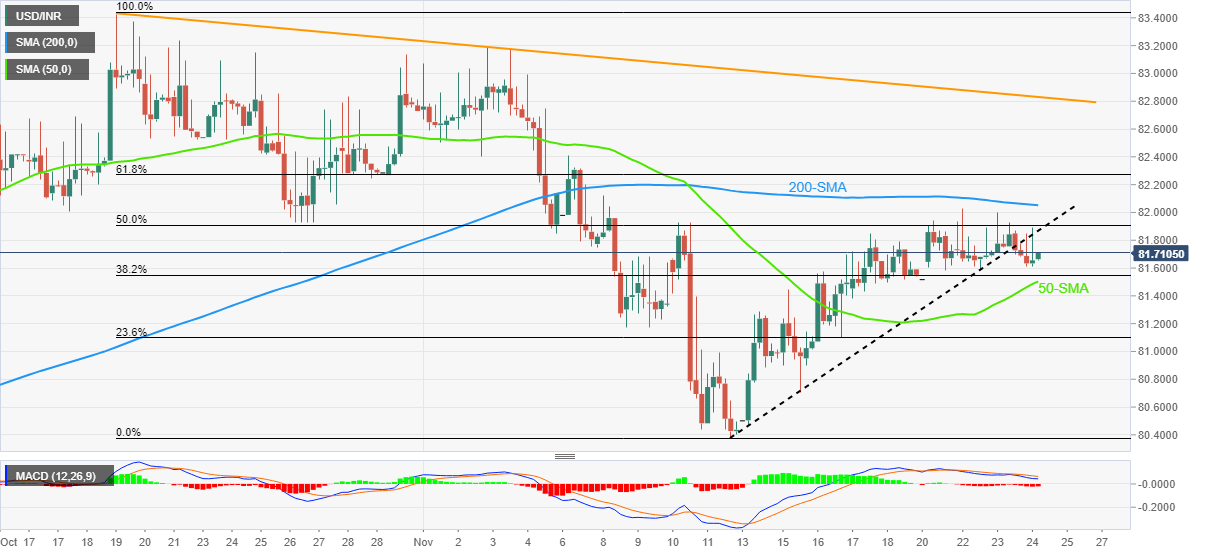
Trend: Further downside expected
- GBP/USD cheers broad US Dollar weakness to refresh multi-day top.
- Brexit pessimism, mixed UK PMIs probe upside momentum during Thanksgiving holiday in the United States.
- Fed Minutes propelled pivot talks and joined downbeat US statistics to weigh on the USD.
GBP/USD takes the bids at the highest levels since August 17 as buyers attack 1.2100 threshold heading into Thursday’s London open. In doing so, the Cable pair cheers the broad-based US Dollar while paying a little heed to the UK’s Brexit-linked issues and recently mixed data.
The United Kingdom’s (UK) Prime Minister (PM) turned down expectations of having a soft corner for the European Union (EU), especially due to Chancellor Jeremy Hunt’s secret wish. Even so, the Financial Times (FT) said, “Rishi Sunak is under pressure from a broad alliance of British business, legal, worker and environmental groups to drop controversial plans to automatically strip swaths of EU-derived law from the British statute book by the end of next year.” It should be noted that the British Supreme Court rejected the Scottish plea to have a fresh referendum for an independent nation.
On a different page, the UK’s first readings of S&P Global/CIPS Manufacturing PMI for November reprinted 46.2 figure versus 45.8 market forecasts while the Services counterpart also followed the suit while again flashing 48.8 numbers compared to 48.0 expected figure. Even so, the S&P Global/CIPS Composite PMI for the said month improved to 48.3 from 48.2 prior while beating 47.5 market expectations.
Above all, easing fears of the US Federal Reserve’s (Fed) aggressive rate hikes, due to the latest Federal Open Market Committee (FOMC) Meeting Minutes, seemed to have lured the GBP/USD bulls. As per the recent minute statement, the majority of the policymakers discussed the need of slowing down the interest rate hikes. Additionally weighing on the Greenback were chatters over the “sufficiently restrictive” level of the Federal Reserve’s (Fed) interest rates, as indicated in the Fed Minutes.
Additionally fueling the GBP/USD price are the most downbeat US statistics. The preliminary readings of the US S&P Global Manufacturing PMI for November eased to 47.6 from 50.0 expected and 50.4 prior whereas the Services PMI also followed the suit while declining to 46.1 compared to 47.9 market forecasts and 47.8 previous readings. Overall, the S&P Global Composite PMI for November dropped to 46.3 versus 47.7 expected and 48.2 prior readouts. On the same line, United States Weekly Jobless Claims rose the most since June, to 240K versus 225K expected and 223K prior, which in turn favored the sentiment and drowned the US Dollar.
It’s worth noting that the cautious optimism surrounding China’s ability to overcome the Covid woes and readiness for further stimulus appeared to favor the risk-on mood as of late. While portraying the mood, the S&P 500 Futures prints mild gains near the monthly high but the off in the United States due to the Thanksgiving celebration restricts the bond moves. Even so, the scheduled speeches of multiple officers from the Bank of England (BOE) and headlines surrounding Brexit may entertain the GBP/USD pair traders.
Technical analysis
200-day EMA joins the overbought RSI (14) to challenge GBP/USD bulls around 1.2105. The pullback moves, however, remain less problematic unless declining below July’s low near 1.1760.
- Gold price is rising for the third straight day on Thursday, having recaptured $1,750.
- Dovish Fed minutes and weak US data weigh on the US Dollar alongside US Treasury yields.
- Gold price faces an uphill battle on the upside, with eyes on the key $1,775 resistance.
Gold price is trading at the best levels seen so far this week, as bulls find fresh impetus after having recaptured the $1,750 psychological mark. The main reason behind the renewed upside in the bright metal is the extended US Dollar weakness in tandem with the US Treasury bond yields. Dovish US Federal Reserve minutes and weak United States PMIs and Jobless Claims data triggered a fresh sell-off in the US Dollar, as the US Tresaury yields tumbled across the curve amid increased expectations of smaller Fed rate hikes in the months ahead. The greenback ignored the Chinese coronavirus-led concerns, which kept the risk rally on the global stocks largely capped. Gold price could preserve recent gains amid Thanksgiving Day-driven thin market conditions, as the bias for the US Dollar remains to the downside.
Also read: Stagflation: The worse for US, the better for gold
Gold Price: Key levels to watch
The Technical Confluence Detector shows that the gold price is struggling to take out a strong resistance at around $1,759, where the SMA10 one-day, Fibonacci 23.6% one-week and SMA50 four-hour coincide.
The next critical resistance is envisioned at $1,762, the intersection of the Fibonacci 38.2% one-week and pivot point one-day R1.
Acceptance above the latter will trigger a fresh rally toward the confluence of the Fibonacci 61.8% one-week and pivot point one-month R2 at $1,772.
Further up, the pivot point one-day R2 and one-week R1 at $1,775 will be put to test.
On the flip side, the immediate support is pegged at the previous day’s high of $1,753, below which the previous week’s low at $1,748 will come into play.
The line in the sand for Gold buyers is the $1,742 demand area, which is the Fibonacci 38.2% one-day.
Here is how it looks on the tool
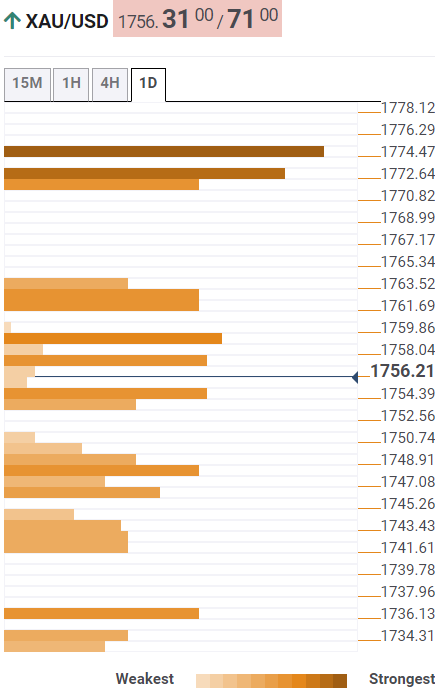
About Technical Confluences Detector
The TCD (Technical Confluences Detector) is a tool to locate and point out those price levels where there is a congestion of indicators, moving averages, Fibonacci levels, Pivot Points, etc. If you are a short-term trader, you will find entry points for counter-trend strategies and hunt a few points at a time. If you are a medium-to-long-term trader, this tool will allow you to know in advance the price levels where a medium-to-long-term trend may stop and rest, where to unwind positions, or where to increase your position size.
- EUR/JPY is likely to drop to near 144.40 as ECB has projected negative growth rates in Eurozone.
- A price ceiling on European gas could result in an additional margin of $33bln for energy traders.
- The Japanese yen is performing better after a holiday on account of Thanksgiving Day.
The EUR/JPY pair has refreshed its three-day low at 144.61 and is expected to display more weakness further. The cross is facing immense pressure after Tokyo’s open post a holiday on account of Thanksgiving Day. The risk profile is extremely upbeat as US Treasury yields are facing immense pressure.
The shared currency bulls are facing a sell-off against the Japanese yen as European Central Bank (ECB) Vice President Luis de Guindos has projected negative growth rates for the fourth quarter. He further added that “Upcoming inflation data projections will still be high before starting to slow down in the first quarter of 2023”.
Supply chain bottlenecks led by Russia-Ukraine tensions have resulted in a significant decline in Eurozone economic activities. Also, expensive energy prices have weighed on the real income of households. Meanwhile, chatters over a price cap on energy have triggered fears of destabilization of the market.
European Union (EU) authorities are planning to levy a ceiling on energy prices to safeguard households from a sheer decline in their real income. In response to that, Intercontinental Exchange (ICE) has warned that the finalization of the price ceiling on European gas would force energy traders to stump up an additional $33 bln in margin payments, as reported by Financial Times. Such a large increase in margin requirements could “destabilize the market”,
On the Japanese yen front, low inflation is still a major concern for Japan. To combat deflation, Japanese Prime Minster Fumio Kishida has announced a $200 billion stimulus package recently. This kind of stimulus package usually spurts global inflation. However, Vitor Gaspar, Director of the fiscal affairs department at the International Monetary Fund (IMF), told Nikkei it is important for Japan that inflation rises to a sustainable target to counter the effects of deflation.
Analysts at Goldman Sachs believe that the People’s Bank of China (PBOC) will slash the Reserve Requirement Ratio (RRR) by 25 basis points (bps) in the coming days.
Key quotes
"view this (Wednesday's State Council) meeting as the response to increased growth downward pressures due to widened Covid curbs on the back of the rising local COVID case numbers."
"The hint of RRR cuts is consistent with our expectation that policymakers could deliver a 25bps RRR cut before year-end to promote economic growth."
"The discussion of banks cutting profits for the benefit of lowering funding cost of SMEs implies policymakers might consider interest rate cuts as well, though according to this statement, it might not be broad interest rate cuts but rather targeted interest rate reduction through implicit guidance on banks or lowering SME re-lending rates."
"The disappointing October credit data amid sluggish credit demand and a large amount of maturing Medium-term Lending Facility (MLF) in the next few months might have also contributed to the decision of RRR cut. We expect PBOC to deliver the RRR cut in the next few days after the State Council's hint."
"Despite these supportive measures, we continue to forecast weak activity growth in the rest of the year and the first half of next year, based on our expectation that China would only begin to reopen in Q2 2023."
- The asset has continued its two-day bullish momentum after surpassing Wednesday’s high at 1.0482.
- A confident establishment above the 200-EMA will strengthen the Euro bulls further.
- The RSI (14)’s oscillation in the 60.00-80.00 range indicates that the upside momentum is active.
The EUR/USD pair has continued its two-day winning streak after overstepping Wednesday’s high at 1.0405 in the Tokyo session. The asset is looking to re-test November high at 1.0482 as the risk profile has turned extremely bullish.
Meanwhile, the US dollar index (DXY) has extended its downside journey to near 105.76 amid a significant decline in safe-haven’s appeal. S&P500 futures have carry-forwarded its upside momentum on Thanksgiving Day.
The EUR/USD pair is aiming to establish comfortably above the 200-period Exponential Moving Average (EMA) at 1.0389. The corrective move in the asset after printing a high of 1.0482 to near 1.0226 has been supported by the upward-sloping trendline placed from November low at 0.9730.
Meanwhile, the Relative Strength Index (RSI) (14) is oscillating in a bullish range of 60.00-80.00, which indicates more upside ahead.
Should the asset break above November’s high at 1.0482, the major will be exposed to the horizontal resistances plotted from June 27 high at 1.0615 and May 30 high at 1.0787.
On the contrary, the shared currency bulls could lose strength if the asset drops below Monday’s low at 1.0226. This will drag the asset towards November 11 low at 1.0163, followed by the round-level support at 1.0100.
EUR/USD daily chart
-638048557820983878.png)
- USD/JPY takes offers to refresh weekly low, prints three-day downtrend.
- Ascending trend line from August lures sellers but RSI conditions challenge further downside past 138.40.
- 100-DMA, recent swing high guard recovery moves, October’s low holds the key for buyer’s entry.
USD/JPY stands on the slippery ground as it renews its weekly low near 138.80 during early Thursday. In doing so, the Japanese Yen (JPY) pair drops for the third consecutive day after reversing from the 38.2% Fibonacci retracement level of the May-October upside.
In addition to the U-turn from an important Fibonacci hurdle, a clear downside break of the 100-DMA and bearish MACD signals also favor USD/JPY bears.
However, an upward-sloping trend line from early August, around 138.40 by the press time, could restrict the Yen pair’s further downside amid a nearly oversold RSI (14) line.
Even if the quote breaks the 138.40 support, a six-month-old ascending support line, close to 136.90 at the latest, will act as an additional downside filter to challenge USD/JPY sellers.
It’s worth observing that the 61.8% Fibonacci retracement level near 136.10, also known as the golden ratio, will act as the last defense of the USD/JPY bulls.
On the contrary, the 100-DMA and the aforementioned 38.2% Fibonacci retracement level, respectively near 141.15 and 142.20, could restrict the short-term upside of the pair.
However, a horizontal area comprising multiple levels marked since early September, close to 145.10, will be a tough nut to crack for the USD/JPY bulls.
USD/JPY: Daily chart
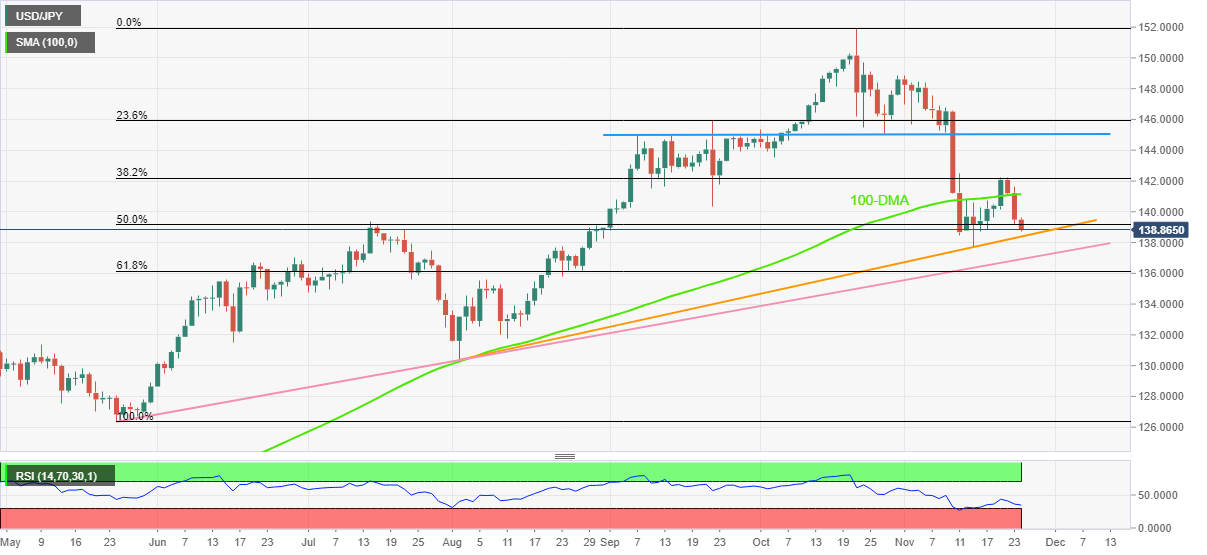
Trend: Further downside expected
The preliminary findings released earlier this week by the International Monetary Fund (IMF) showed that China's economy is projected to grow at 3.2% in 2022, then rise by 4.4% for the next two years as the country's growth remains under pressure following an "impressive" recovery from the pandemic's initial impact.
Gita Gopinath, IMF's first Deputy Managing Director, said: "Under the zero-COVID strategy, China weathered the initial impact of the pandemic well, allowing the economy to recover swiftly from the early-2020 lockdowns and to expand the global supply of medical goods and durable goods significantly at a critical time for the global economy.”
Additional comments
"However, China's growth has since slowed and remains under pressure amid recurring COVID outbreaks, deep challenges in the property sector and slowing global demand.”
“The regulatory tightening in the property sector, while well intended to rein in high leverage, has added to severe financial strains for developers, leading to a rapid slowdown in housing sales and investment, along with a sharp decline in local government land-sale revenues.”
"Against this backdrop, growth is projected at 3.2 percent for 2022, increasing to 4.4 percent in 2023 and 2024, under the assumption that the current zero-COVID strategy will be gradually and safely lifted in the second half of 2023.”
Market reaction
USD/CNY is losing 0.35% on the day to trade at 7.1427, at the time of writing. The Chinese Yuan is resilient to the concerns over China’s record high covid cases and economic growth.
| Raw materials | Closed | Change, % |
|---|---|---|
| Silver | 21.526 | 2.16 |
| Gold | 1749.45 | 0.54 |
| Palladium | 1874.59 | 0.94 |
- USD/CAD takes offers to print three-day downtrend, renews weekly low.
- Oil prices rebound after a heavy slump amid cautious optimism in the market.
- US Dollar drops on concerns that the Fed is near to ‘pivot’.
- Thanksgiving holiday, light calendar can restrict the pair’s immediate moves.
USD/CAD holds on the bearish bias as it refreshes the weekly low near 1.3350 during early Thursday. In doing so, the Loonie pair reverses the previous week’s gains, the first in five, amid recently firmer prices of WTI crude oil and a broad-based US Dollar weakness.
WTI crude oil, Canada’s biggest export item, licks its wounds around $77.80 while paring the biggest daily fall in two months amid market’s mildly bid sentiment. The black gold’s previous downside could be linked to the fears of less demand due to the coronavirus-linked lockdowns in China, as well as expectations of more supplies from the OPEC+. However, the US Dollar weakness and chatters over gradual opening in the dragon nation appeared to have favored the energy buyers of late.
That said, Bloomberg reports that China’s daily Covid infections climbed to a record high, exceeding the previous peak in April, as it battles an outbreak that has grown since the country adopted a more targeted approach to containing the virus. The news also added that the country reported 29,754 new cases for Wednesday, more than the 28,973 infections recorded in mid-April when the financial hub of Shanghai was in the midst of a grueling two-month lockdown that saw residents struggle to access food and medical services. Even so, Chinese policymakers are warned about altering the zero-covid policy in the latest mediate coverage.
It’s worth noting that the hopes of Chinese government measures to ease the pains of real-estate and financial sector, as well as chatters surrounding a cut to the People’s Bank of China’s (PBOC) Reserve Requirement Ratio, also seemed to have favored the risk-on mood.
On the other hand, the US Dollar Index (DXY) dropped the most in a fortnight the previous day after the latest Federal Open Market Committee (FOMC) Meeting Minutes signaled that the policymakers discussed the need of slowing down the interest rate hikes. Additionally weighing on the Greenback were chatters over the “sufficiently restrictive” level of the Federal Reserve’s (Fed) interest rates, as indicated in the Fed Minutes.
Additionally, downbeat prints of the US activity data for November also weighed on the US Dollar and favoerd the USD/CAD bears. The preliminary readings of the US S&P Global Manufacturing PMI for November eased to 47.6 from 50.0 expected and 50.4 prior whereas the Services PMI also followed the suit while declining to 46.1 compared to 47.9 market forecasts and 47.8 previous readings. Overall, the S&P Global Composite PMI for November dropped to 46.3 versus 47.7 expected and 48.2 prior readouts..
Amid these plays, S&P 500 Futures print mild gains while Treasury yields stay pressured around 3.69%.
Moving on, a light calendar can keep the USD/CAD bears hopeful but a corrective bounce amid a lack of liquidity can’t be ruled out.
Technical analysis
A clear U-turn from the 21-DMA hurdle, around 1.3455 by the press time, directs USD/CAD bears towards the 100-DMA support near 1.3265.
An adviser to the monetary policy committee of the People's Bank of China (PBOC), Wang Yiming, said on Thursday that China should aim to bring economic growth back to normal as soon as possible.
Additional quotes
“With the recovery of consumption particularly important amid weakening external demand which could slow exports and manufacturing investment growth next year.”
“It is necessary to release the spending potential of 460 million families, as it will be difficult to maintain the supply-demand balance if consumption is not supported as exports fall.”
“Next year's monetary policy should continue to be prudent, tilted to loosening, and maintain reasonable and ample liquidity.”
- USD/CNH pares weekly gains near 7.1400 amid mixed concerns over Covid, China GDP
- USD/CNH takes offers to refresh intraday low, stays on the way to second weekly gain.
- Chinese policymakers face criticism over zero-covid policy amid strong virus numbers.
- Nomura cuts China’s Gross Domestic Product (GDP) forecasts for 2022, 2023.
- FOMC Minutes, downbeat US PMIs adds strength to the pullback moves.
USD/CNH cheers softer US Dollar, as well as cautious optimism in the market, while printing daily losses around 7.1400 during early Thursday. In doing so, the offshore Chinese Yuan (CNH) pair drops 0.10% intraday while consolidating the second weekly gain in a row.
While broad USD weakness is the key catalyst for the USD/CNH pair’s latest losses, Chinese policymakers’ rush towards easing the virus-led activity restrictions, despite record high Covid numbers, also weighed on the quote.
Bloomberg said that China’s daily Covid infections climbed to a record high, exceeding the previous peak in April, as it battles an outbreak that has grown since the country adopted a more targeted approach to containing the virus. The news also added that the country reported 29,754 new cases for Wednesday, more than the 28,973 infections recorded in mid-April when the financial hub of Shanghai was in the midst of a grueling two-month lockdown that saw residents struggle to access food and medical services. Even so, Chinese policymakers are warned about altering the zero-covid policy in the latest mediate coverage.
Elsewhere, Nomura lowers China's GDP growth forecasts for 2022 and 2023 to 2.8% and 4.0% versus 2.9% and 4.3% previous projections in that order.
On the other hand, the latest Federal Open Market Committee (FOMC) Meeting Minutes signaled that the policymakers discussed the need of slowing down the interest rate hikes. Additionally weighing on the Greenback were chatters over the “sufficiently restrictive” level of the Federal Reserve’s (Fed) interest rates, as indicated in the Fed Minutes.
Furthermore, mostly downbeat US statistics offered an extra favor to the USD/CNH bears. The preliminary readings of the US S&P Global Manufacturing PMI for November eased to 47.6 from 50.0 expected and 50.4 prior whereas the Services PMI also followed the suit while declining to 46.1 compared to 47.9 market forecasts and 47.8 previous readings. Overall, the S&P Global Composite PMI for November dropped to 46.3 versus 47.7 expected and 48.2 prior readouts.
That said, the United States Weekly Jobless Claims rose the most since June, to 240K versus 225K expected and 223K prior, which in turn favored the sentiment and drowned the US Dollar.
However, strong prints of the US Durable Goods Orders, up 1.0% in October versus 0.4% marked expectations and downwardly revised 0.3% prior, join China’s covid woes to challenge the USD/CNH bears amid a sluggish session.
It’s worth noting that Thanksgiving holiday in the US and a light calendar elsewhere may allow the USD/CNH pair to reverse the latest losses.
Technical analysis
USD/CNH remains sidelined between the 21-day Exponential Moving Average (EMA) and the 50-day EMA, respectively near 7.1660 and 7.1330.
- AUD/USD picks up bids to refresh weekly high during three-day uptrend.
- A successful break of 50-SMA, one-week-old descending trend line favor buyers.
- Monthly support line, 61.8% Fibonacci Expansion level act as additional trading filters.
AUD/USD takes the bids to renew weekly top around 0.6755 during early Thursday as buyers cheer a three-day uptrend.
In doing so, the Aussie pair cheers the previous day’s upside break of the 50-SMA and a downward-sloping trend line from November 17, respectively near 0.6690 and 0.6620.
Also keeping the pair buyers hopeful is the sustained trading beyond the previous resistance line from late October, as well as the 200-SMA, amid the bullish MACD signals.
That said, the AUD/USD buyers are well-positioned to challenge the monthly high of 0.6792 with eyes on 0.6800.
Following that, the 61.8% Fibonacci Expansion (FE) level surrounding 0.6840 could entertain the bulls before directing them to September’s peak of 0.6916.
Meanwhile, AUD/USD pullback remains elusive unless the quote provides a decisive break below the 50-SMA and the previous resistance line, close to 0.6690 and 0.6620 in that order.
Even so, a one-month-old ascending trend line near 0.6585 can challenge the AUD/USD bears.
In a case where the quote remains bearish past 0.6585, the odds of witnessing a south-run towards the 200-SMA level of 0.6455 can’t be ruled out.
AUD/USD: Four-hour chart

Trend: Further upside expected
- NZD/USD bulls are in control while the front side of the daily and hourly trendlines.
- Bulls aim for the daily highs with the 0.65400 area in sight.
New Zealand's central bank governor said on Thursday that benchmark interest rates needed to go higher following its hawkish tone and forecast that rates would now peak at 5.5%, compared with a previous forecast of 4.1%.
NZD/USD rallied to a high of 0.6259 on Thursday, heading towards the strongest levels in nearly three months with eyes on 0.6485 after the Reserve Bank of New Zealand delivered a supersized 75 basis point rate hike to get ahead of inflation.
That hike was the largest since the RBNZ introduced the OCR in 1999 and brought the policy rate to a 14-year high of 4.25%. This leaves the upside firmly in play while the price remains on the front side of the daily trendline.
NZD/USD H1 chart
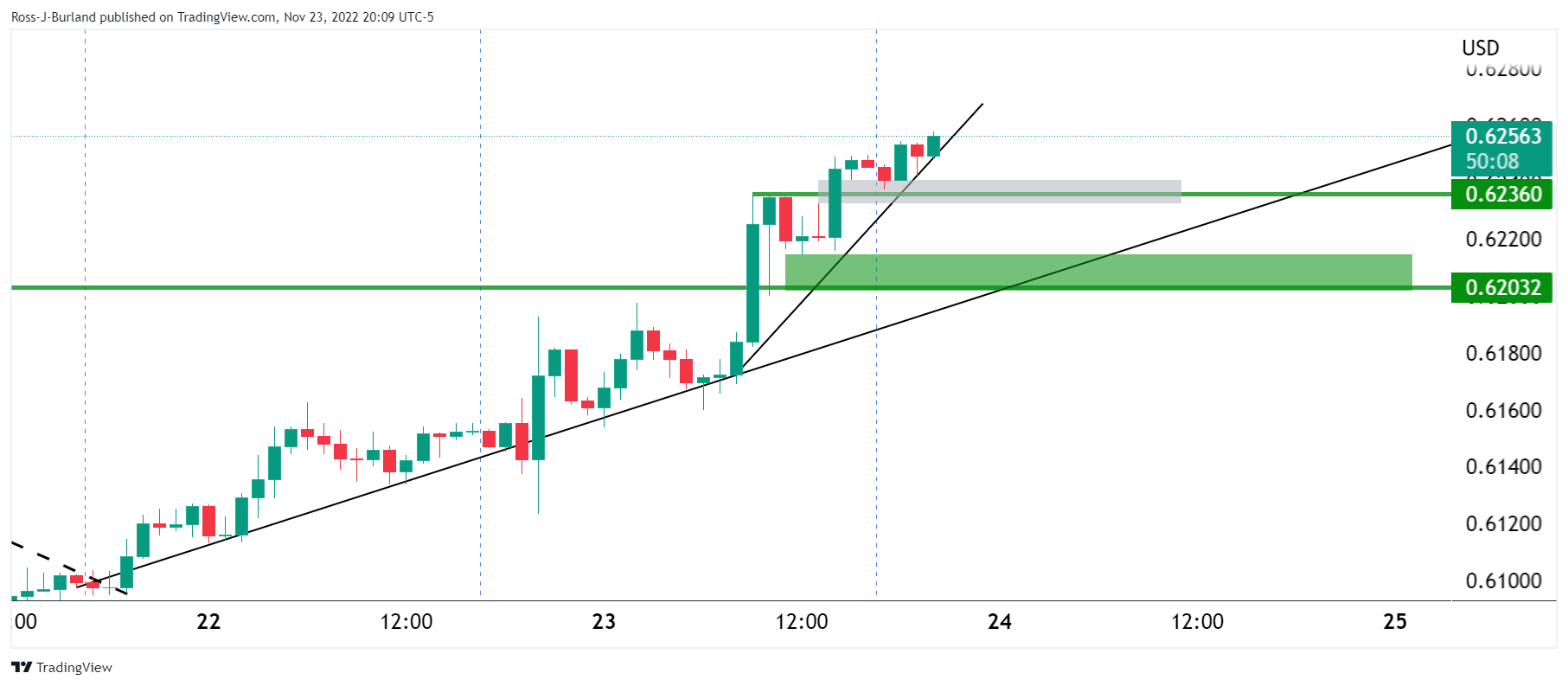
The bulls are creeping higher in Asian trade despite the ground it has already made since the RBNZ.
NZD/USD H1 chart zoomed out

This has happened with a move that has been in development for some time given the coil and breakout of the 0.6000 and 0.6100 areas. This has the potential to move towards the daily highs as illustrated below on the daily;y time frame all the while the bulls stay front side of the daily trendlines:
NZD/USD daily chart
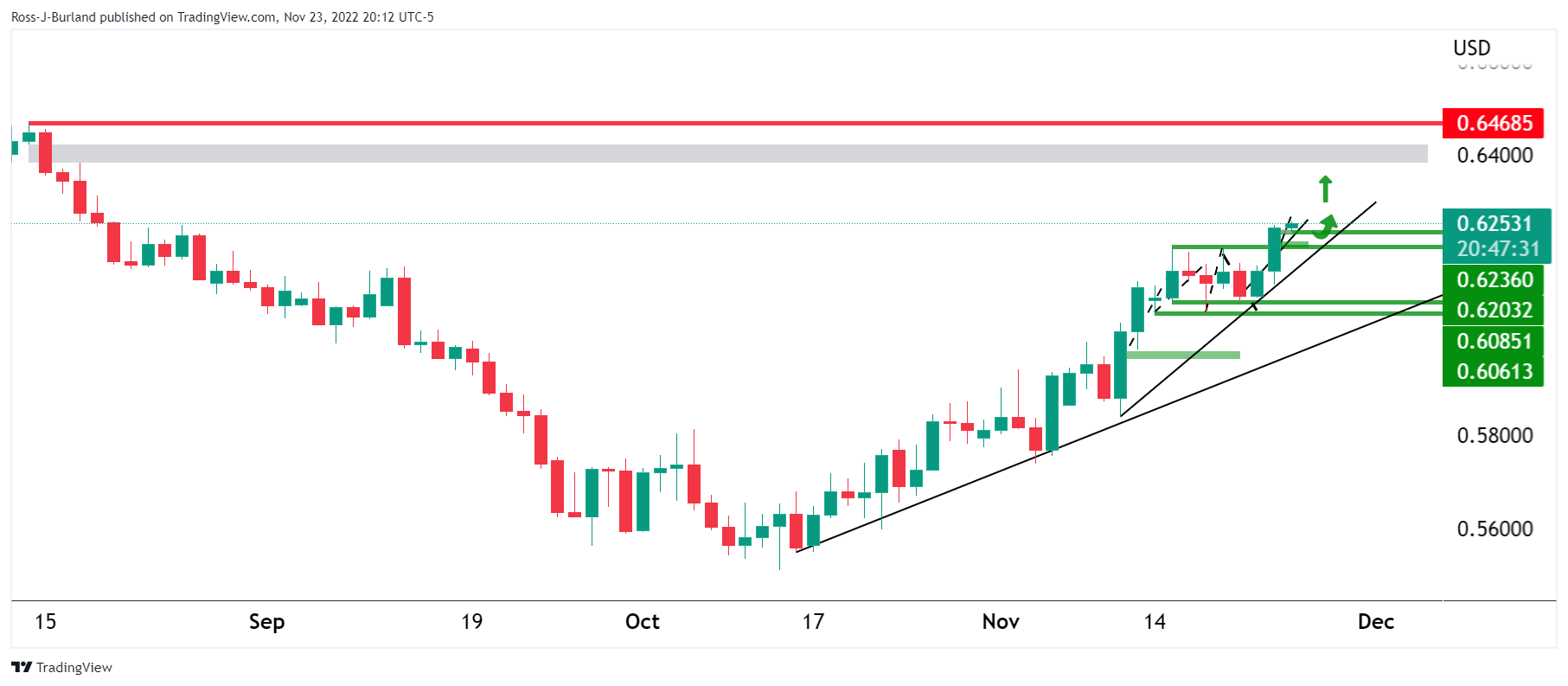
On the basis of the ongoing covid risks, Nomura lowers China's GDP growth forecasts for 2022 and 2023.
Nomura lowered China's GDP growth forecast for 2022 to 2.8% from 2.9% while that for 2023 was slashed to 4% from 4.3%.
Nomura’s Chief China Economist Ting Lu said: “In GDP terms, nearly 20% of China’s economy was negatively affected by Covid controls as of Monday, close to the high of 21.2% recorded in mid-April during Shanghai’s lockdown.”
Additional quotes
“Beijing has recently shown early signs of willingness to reopen, and it has rolled out some fine-tuning measures, but the reopening may be a prolonged process with discomfort.”
“Many lockdowns or controls are implemented without public announcement. “
“We believe [the southwestern municipality of] Chongqing is currently experiencing the most severe local lockdown in China, based on our observation of numerous mobility metrics.”
Related reads
- S&P 500 Futures print mild gains, Treasury yields struggle amid Fed, Covid chatters on Thanksgiving Day
- China coronavirus situation has been brushed aside
- Market sentiment remains cautiously optimistic despite Thanksgiving holiday, light calendar.
- Fed Minutes propelled ‘pivot’ discussions, China brush aside virus woes to ease zero-covid policy.
- Wall Street closed positive, US Treasury bond yields refreshed weekly low.
The risk profile improves during early Thursday as a holiday in the US joins a light calendar. Also keeping the buyers hopeful are the expectations from the Chinese authorities, as well as chatters surrounding the Fed’s pivot and the easy monetary policy.
While portraying the mood, S&P 500 Futures print 0.25% intraday gains around the weekly high near 4,045 whereas the US 10-year Treasury yields remain depressed at around 3.69%.
It’s worth noting that the latest Federal Open Market Committee (FOMC) Meeting Minutes signaled that the policymakers discussed the need of slowing down the interest rate hikes. Additionally weighing on the Greenback were chatters over the “sufficiently restrictive” level of the Federal Reserve’s (Fed) interest rates, as indicated in the Fed Minutes.
Elsewhere, Bloomberg said that China’s daily Covid infections climbed to a record high, exceeding the previous peak in April, as it battles an outbreak that has grown since the country adopted a more targeted approach to containing the virus. The news also added that the country reported 29,754 new cases for Wednesday, more than the 28,973 infections recorded in mid-April when the financial hub of Shanghai was in the midst of a grueling two-month lockdown that saw residents struggle to access food and medical services. Even so, Chinese policymakers are warned about altering the zero-covid policy in the latest mediate coverage.
Also read: China coronavirus situation has been brushed aside
As a result, the ignorance of the Covid conditions and hopes of easy Fed rates seemed to have favored the risk-on mood during inactive markets.
Even so, second-tier European data and talks over the bloc’s recession, as well as geopolitical tension with Russia, might challenge the sentiment. Additionally, higher coverage of China’s COVID-19 woes and an off in the US may allow traders to pare recent gains.
- Gold price has established firmly above $1,750.00 after consolidating around the 200-EMA.
- Markets could turn volatile as United States markets will remain closed on account of Thanksgiving Day.
- The Fed is expected to consider a 50 bps rate hike for December monetary policy meeting.
Gold price (XAU/USD) has shifted its business above the crucial resistance of $1,750.00 in the Tokyo session. The precious metal is expected to extend its gains further as investors are dumping the US dollar index (DXY) amid a significant increment in investors’ risk appetite. The DXY has dropped below the cushion of 106.00 as investors see no scope for the continuation of the 75 basis points (bps) rate hike regime by the Federal Reserve (Fed).
Meanwhile, S&P500 futures are showing further strength after a positive Wednesday. The volatility could decline ahead as markets in the United States will remain closed on Thursday on account of Thanksgiving Day. The 10-year US Treasury yields have extended their losses below 3.69% as the Fed is set to trim its current pace of hiking interest rates.
The Federal Open Market Committee (FOMC) minutes released in the late New York session dictated that the majority of Fed policymakers are favoring a slowdown in the rate hike pace to reduce financial risks and to assess the progress made by policy tightening measures till now. Considering the persistent nature of inflation in the United States economy, Fed chair Jerome Powell will shift to the 50 bps rate hike extent for December’s monetary policy meeting.
Gold technical analysis
On an hourly scale, Gold price has delivered a breakout of the consolidation formed around the 200-period Exponential Moving Average (EMA) at $1,744.00. The consolidation remained in a range of $1,732-1,750.
Adding to that, the Relative Strength Index (RSI) (14) has shifted into the bullish range of 60.00-80.00, which indicates that the upside momentum is active.
Gold hourly chart
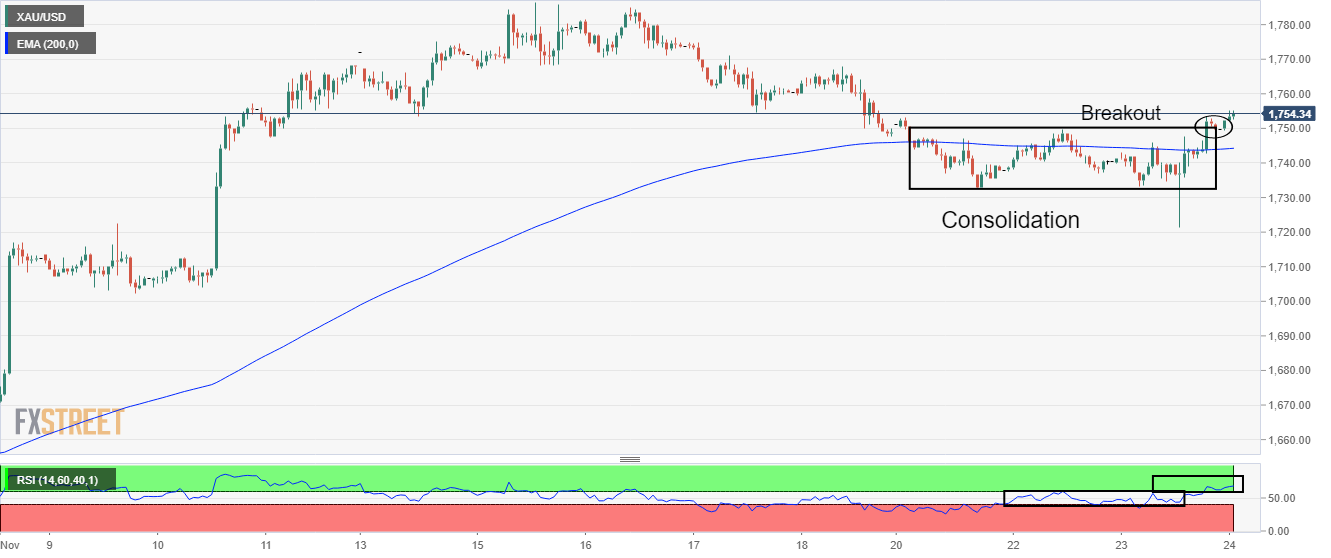
Analysts at JP Morgan (JPM) expect EUR/USD pair to average 0.9500 during the first half (H1) of the next year (2023) while also citing possibilities of a test towards 0.9000 (assuming no de-escalation in geopolitics).
The investment bank also mentioned in its latest report that its economists expect the US Federal Reserve (Fed) and the European Central Bank (ECB) to pause in the first quarter of 2023 (1Q23) at 5% and 2.5% for the rest of 2023.
The same will leave the policy rate differential just 50 basis points (bps) shy of its 15-year low.
“The outlook envisions a mild recession in the US at the end of 2023, which should hamper recovery in the Eurozone (EU is expected to grow by 0.2% vs. US of 0.4% next year,” said JPM in the report.
JP Morgan also mentioned that a Fed pause is not a sufficient condition for a rebound in the EUR/USD while adding, “Trading strategy is tactical, with risks being an ongoing improvement in regional growth momentum or a potential ceasefire.”
Also read: EUR/USD renews weekly top above 1.0400 as Fed’s pivot is in the air, ECB Accounts eyed
In recent trade today, the People’s Bank of China (PBOC) set the yuan (CNY) at 7.1201 vs. the last close of 7.1580.
About the fix
China maintains strict control of the yuan’s rate on the mainland.
The onshore yuan (CNY) differs from the offshore one (CNH) in trading restrictions, this last one is not as tightly controlled.
Each morning, the People’s Bank of China (PBOC) sets a so-called daily midpoint fix, based on the yuan’s previous day's closing level and quotations taken from the inter-bank dealer.
- Silver price remains mildly bid at weekly top, prints three-day uptrend.
- A clear break of 200-DMA, upbeat RSI (14) favor buyers to approach monthly top.
- Tops marked during October, August add to the downside filters.
Silver price (XAG/USD) picks up bids to refresh weekly top around $21.60 during Thursday’s Asian session.
In doing so, the bright metal rises for the third consecutive day while justifying the previous day’s upside break of the 200-DMA. Also keeping the XAG/USD bulls hopeful is the firmer RSI (14) line, not overbought.
With this, the quote is all set to approach the monthly high surrounding the 50% Fibonacci retracement of the March-September downside, near $22.25.
However, June’s peak surrounding $22.50 might challenge the silver buyers afterward, if not then a run-up towards the 61.8% Fibonacci retracement level near $23.40, also known as the golden ratio, could lure the bulls.
On the flip side, a daily closing below the 200-DMA, near $21.40 by the press time, appears necessary to confirm a short-term downside.
Even so, highs marked during October and August, respectively near $21.25 and $20.85, quickly followed by the 21-DMA support near $20.75, could restrict the XAG/USD’s short-term downside.
It’s worth noting that May’s low near $20.45 acts as the last defense of silver buyers.
Silver: Daily chart
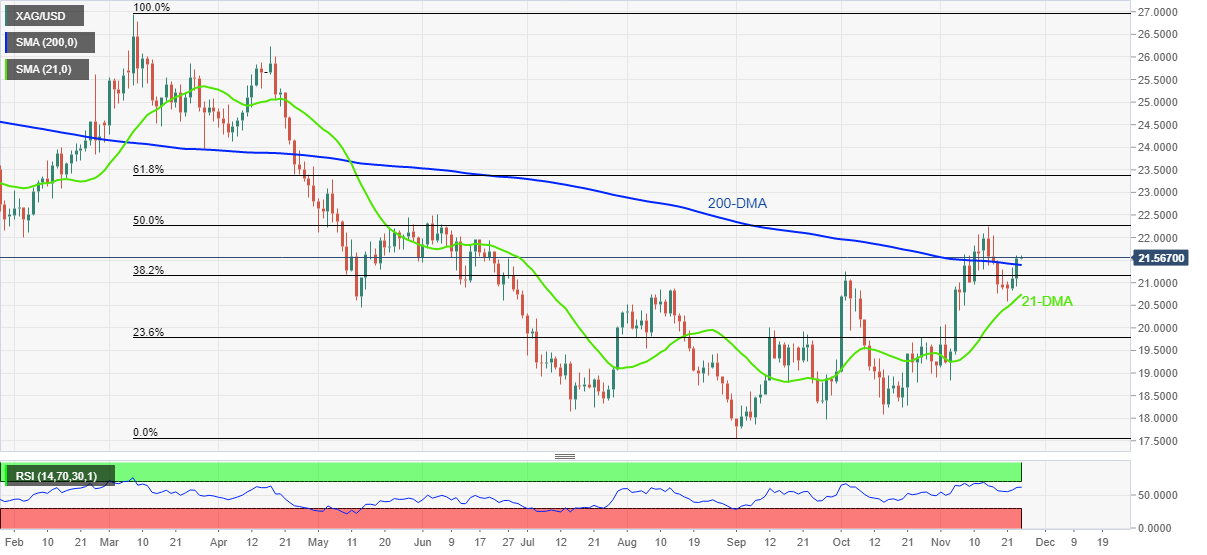
Trend: Further upside expected
South Korea's central bank has hiked the rate by 25bps as expected to 3.25% amid signs of slowing domestic growth, despite high inflation and an aggressive US Federal Reserve, a Reuters poll found.
South Korea's economy is fast losing momentum at latest measure as higher living costs erode household income and crimp demand, pressuring the BoK to strike a balance between inflation and growth.
Reuters reports that rates are now at the highest level since July 2012, after delivering a half-percentage point hike in October.
''All but one of 30 economists expected the central bank to opt for a quarter-point hike in a Reuters poll, while one forecast another half-point rise.
The Bank of Korea has raised the policy rate by a total of 275 basis points since August 2021 from a record low of 0.50%. Governor Rhee Chang-yong will hold a news conference at 0210 GMT.''
- GBP/USD is facing fragile barricades in overstepping the critical hurdle of 1.2080.
- FOMC minutes are supporting a slowdown in the rate hike pace to reduce financial risks.
- BOE’s Bailey is expected to hike its interest rates by 50 bps in December monetary policy meeting.
The GBP/USD pair is displaying signs of loss in the upside momentum while attempting to cross the immediate hurdle of 1.2080 in the Tokyo session. The upside momentum is not completely exhausted as the risk profile is full of optimism. A continuous oscillation of the Cable above the psychological resistance of 1.2000 indicates that bulls are in their comfort zone and more upside is still favored.
Meanwhile, the US dollar index (DXY) is set to test the round-level support of 106.00 due to a sheer decline in safe-haven’s appeal. The downside momentum in the US Dollar could drag it to a test of a three-month low at 105.34 as odds of continuation of 75 basis points (bps) rate hike structure by the Federal Reserve (Fed) are fading away.
The 10-year US Treasury yields have slipped below 3.69% as a majority of Fed policymakers are supporting a slowdown in the pace of hiking interest rates. The minutes of the Federal Open Market Committee (FOMC) cleared that Fed think tanks are likely to observe the progress of the efforts made yet to bring price stability. Also, a reduction in financial risks is highly required now.
On the United Kingdom front, after adding 75 bps in the interest rates by the Bank of England (BOE) in its November monetary policy. BOE Governor Andrew Bailey is expected to escalate interest rates further by 50 bps, according to a Reuters poll conducted on Nov 18-22.
BOE Chief Economist Huw Pill cited that surge in people quitting the British workforce because of ill health or early retirement could force the BOE to further increase interest rates, as reported by The Guardian. He further added that “Accelerating unemployment among the working age population is indicating an adverse supply shock, which could lead to higher payroll bills for the employers, and henceforth a rise in inflation”.
- EUR/USD grinds near one-week high, prints three-day uptrend, despite latest retreat from the daily top.
- FOMC Minutes, statistics from the United States favor US Dollar bears.
- Challenges to sentiment from China, Thanksgiving holiday allows buyers to take a breather.
- Germany IFO data, ECB Minutes may help buyers amid cautious optimism in the bloc.
EUR/USD pares intraday gains around the weekly top as it makes rounds to 1.0400 during Thursday’s Asian session. The major currency pair’s latest pullback could be linked to the market’s fears from the Coronavirus, as well as consolidation due to the Thanksgiving holiday in the United States.
Market sentiment sours as Chinese media highlights the urge for tackling the Covid woes as the virus numbers approach record highs. On the same line could be the mixed comments from the European policymakers.
European Central Bank (ECB) Vice President Luis de Guindos stated Wednesday, “It is very likely that we will see negative growth rates in the fourth quarter in the Eurozone.” The policymaker also added that the ECB will keep raising interest rates to try to bring inflation down towards mid-term goals. Additionally, Germany’s central bank the Bundesbank released its monthly report and stated, "The inflation rate could stay in double digits also beyond the turn of the year."
However, the upbeat prints of the bloc’s activity data and dovish Federal Open Market Committee (FOMC) Meeting Minutes keep the EUR/USD buyers hopeful.
Talking about the preliminary activity data for November, Germany’s S&P Global/BME Manufacturing PMI improved to 46.7 versus 45.0 market forecasts and 45.1 while the Services counterpart came out as 46.4 compared to 46.2 expected and 46.5 previous readings. On the other hand, Eurozone S&P Global Manufacturing PMI also rose to 47.3 for the said month from 46.4 prior and 46.0 consensus figure. That said, the bloc’s Services PMI reprinted 48.6 figure while crossing expectations of registering 48.0 number.
On the other hand, the latest Fed signaled that the policymakers discussed the need of slowing down the interest rate hikes. Additionally weighing on the Greenback were chatters over the “sufficiently restrictive” level of the Federal Reserve’s (Fed) interest rates, as indicated in the Fed Minutes.
While portraying the mood, the S&P 500 Futures struggle to trace Wall Street’s gains whereas the US 10-year Treasury yields await fresh directions at the weekly lo near 3.68% by the press time.
Moving on, the first readings of Germany’s IFO sentiment numbers for November will precede the ECB Monetary Policy Meeting Accounts, mostly known as ECB Accounts, to entertain EUR/USD traders. Although likely upbeat statistics and the hawkish tone of the ECB Accounts may keep the quote firmer, signals of the recession may probe the upside momentum.
Technical analysis
A successful break of the 50-SMA and a one-week-old descending trend line, respectively near 1.0340 and 1.0280, join the bullish MACD signals to keep the EUR/USD buyers hopeful of approaching the monthly high near 1.0480, as well as the 1.0500 threshold.
The China coronavirus situation has been brushed aside this week despite the fresh tightening. After the 20th National Congress of the Chinese Communist Party last month, investors were backing the enthusiasm surrounding the prospects that Beijing would adjust its zero-COVID policy.
There had been announcements of the strategy mentioned back in November of a strategy to loosen restrictions that bolstered markets. However, new outbreaks temporarily shook markets up, starting with a warning from doctors to the government
that the nation is not to relax lockdown measures, in an article by the Financial Times: China’s doctors warn ‘we’re not ready’ as threat of covid ‘exit wave’ stymies reopening ambitions.
The article started as follows:
China’s doctors have a blunt message for Xi Jinping: the country’s healthcare system is not prepared to deal with a huge nationwide coronavirus outbreak that will inevitably follow any easing of strict measures to contain Covid-19. The warning for China’s leader was delivered by a dozen health professionals — including frontline doctors and nurses and local government health officials — interviewed by the Financial Times this month, and echoed by international experts. “The medical system will probably be paralysed when faced with mass cases,” said one doctor in a public hospital in Wuhan, central China, where the pandemic started nearly three years ago.
Meanwhile, at the start of this week, it was seen that China had recorded more than 28,000 new cases a day, nearly passing the country’s record. subsequently, authorities have since closed public spaces again—especially in Beijing, Shanghai, and other mega-cities.
In a recent analysis, Nomura reported that the COVID-19 restrictions have affected 20 per cent of China’s GDP. People’s Daily put out an article on Thursday that states that China must be quick in curbing covid spread.
Nevertheless, global shares edged higher this week recovering some of the previous losses made at the start of the week. Improved investor risk appetite drove flows into equities. Wall Street's major indexes closed higher on Wednesday, for instance, after investors cheered the Fed's meeting minutes.
The minutes showed that a "substantial majority" of policymakers at the Federal Reserve's meeting early this month agreed it would "likely soon be appropriate" to slow the pace of interest rate hikes. Consequently, the Dow recorded its highest closing level since April 2021.
| Index | Change, points | Closed | Change, % |
|---|---|---|---|
| Hang Seng | 99.4 | 17523.81 | 0.57 |
| KOSPI | 12.74 | 2418.01 | 0.53 |
| ASX 200 | 50.5 | 7231.8 | 0.7 |
| FTSE 100 | 12.44 | 7465.24 | 0.17 |
| DAX | 5.24 | 14427.59 | 0.04 |
| CAC 40 | 21.56 | 6679.09 | 0.32 |
| Dow Jones | 95.96 | 34194.06 | 0.28 |
| S&P 500 | 23.68 | 4027.26 | 0.59 |
| NASDAQ Composite | 110.91 | 11285.32 | 0.99 |
| Pare | Closed | Change, % |
|---|---|---|
| AUDUSD | 0.6732 | 1.3 |
| EURJPY | 145.112 | -0.23 |
| EURUSD | 1.03939 | 0.89 |
| GBPJPY | 168.247 | 0.29 |
| GBPUSD | 1.20519 | 1.42 |
| NZDUSD | 0.6246 | 1.55 |
| USDCAD | 1.33545 | -0.11 |
| USDCHF | 0.94237 | -0.92 |
| USDJPY | 139.604 | -1.13 |
- The US Dollar is expected to test its three-month low at 105.35 amid sheer optimism in global markets.
- Fed’s Powell would shift to a 50 bps rate hike option as inflation is still in a persistent stage.
- Investors should brace for a higher Fed’s terminal rate as achievement of price stability is still far.
The US dollar index (DXY) is oscillating inches far from the round-level support of 106.00 in the Tokyo session. The US dollar witnessed a vertical fall on Wednesday after surrendering the critical support of 107.00. The mighty US Dollar went through intense selling pressure as investors ditched the risk aversion theme. The reasoning behind a sell-off in the US Dollar is soaring expectations for a lower shift in the interest rate hike in the upcoming December monetary policy.
Investors should be aware of the fact that the US markets will be closed on Thursday on account of Thanksgiving Day.
FOMC minutes clear that 75 bps rate hike regime has reached the endgame
The minutes of the Federal Open Market Committee released in the late New York session dictated that the majority of the Federal Reserve (Fed) policymakers have vouched for a slowdown in the rate hike pace to allow room to judge the progress of the efforts and to reduce financial risks. This indicates that there would be no fifth consecutive 75 basis points (bps) rate hike by the Fed.
Most probably, Fed chair Jerome Powell will shift to a 50 bps rate hike as inflation is still in a persistent stage. For the targeted rate, the Fed believes that the catalyst will go higher.
Upbeat US Durable Goods Orders failed to support the US Dollar
The US Durable Goods orders delivered a stellar performance on Wednesday after landing at 1.0%, higher than the expectations and the prior release of 0.4%. This claims that demand for durable goods is robust and the core Consumer Price Index (CPI) could show some reluctance in displaying any further ease. There is no denying the fact that households in the United States are running at lower real income due to higher inflationary pressure. Therefore, the households would be required to rely upon borrowings for funding the purchase of durable goods.
- USD/JPY continues to bleed out following dovish FOMC minutes.
- 138.50 is targetted to the downside for the immediate future.
At the time of writing, USD/JPY is down 0.2% having fallen from a high of 139.60 and has reached a low of 139.25 into the Tokyo open with the greenback still reeling from a dovish set of Federal Open Market Committee meeting minutes.
Minutes from the Federal Reserve's November meeting showed that most policymakers at the central bank agreed it would soon be appropriate to slow the pace of interest rate hikes. In other key statements, the minutes showed that a slower pace of rate hikes would better allow the FOMC to assess progress toward its goals given the uncertain lags around monetary policy. A few participants said slowing the pace of rate hikes could reduce the financial system risks; others that slowing should await more progress on inflation.
The US Dollar index, as a consequence, has fallen more than 1% toward 106, the lowest since mid-August, as traders raise bets of only a 50 bps rate hike by the Fed in December. The move was fortified by poor data prior to the event.
A slew of US economic data (including durable goods orders, PMIs, claims, new home sales, and final Michigan sentiment), for the most part, was solid but the emphasis was put on the shocking result in the US Manufacturing PMI that missed expectations by a mile:
- US: S&P Global Manufacturing PMI drops to 47.6 in November vs. 50 expected
''The minutes support our forecast that the top of the target range will peak at 5.00% next year,'' analysts at Rabobank said. ''However, while inflation may have peaked, we think its persistence poses an upside risk to our forecast. It is also why we do not expect the Fed to pivot before 2024.''
USD/JPY technical analysis
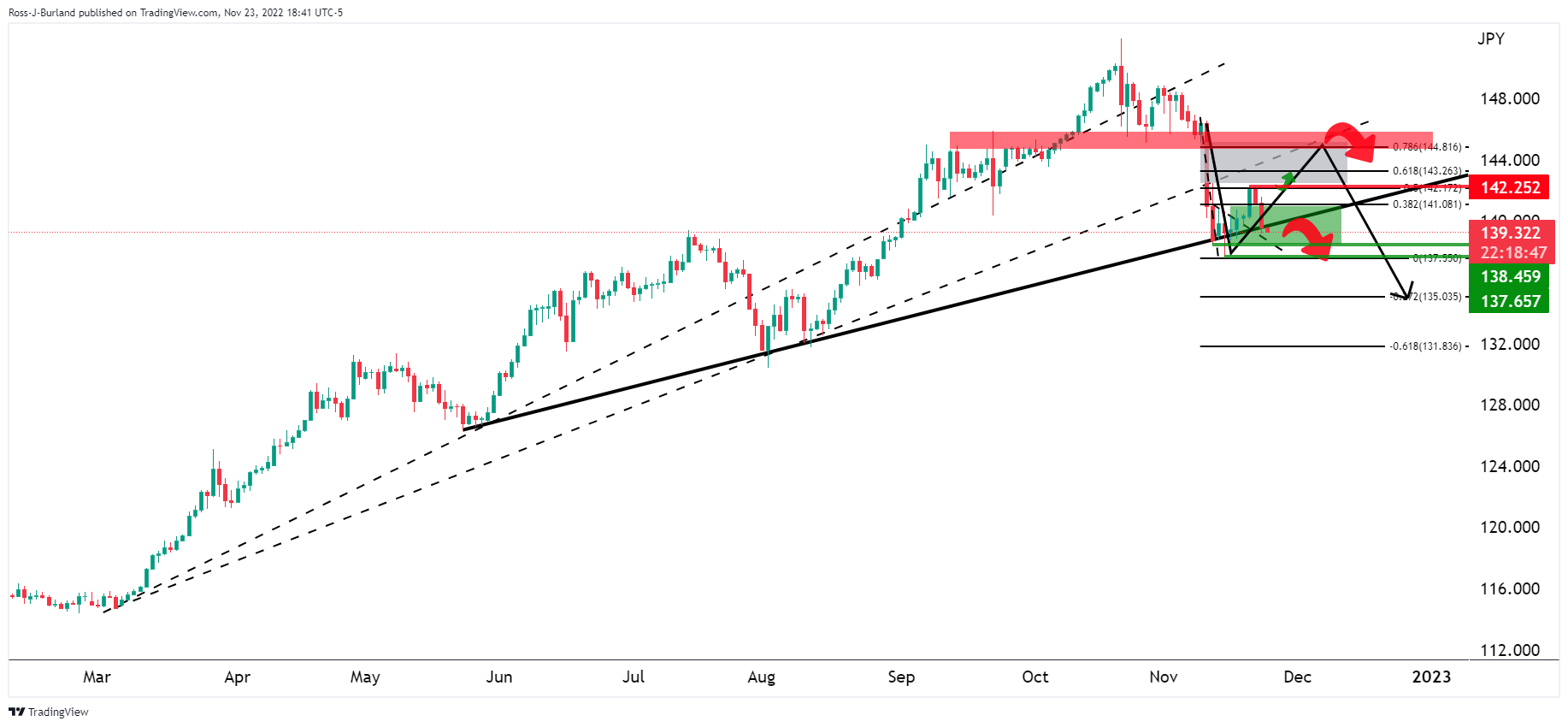
The daily trendline support holding up so far.
Zoomed...
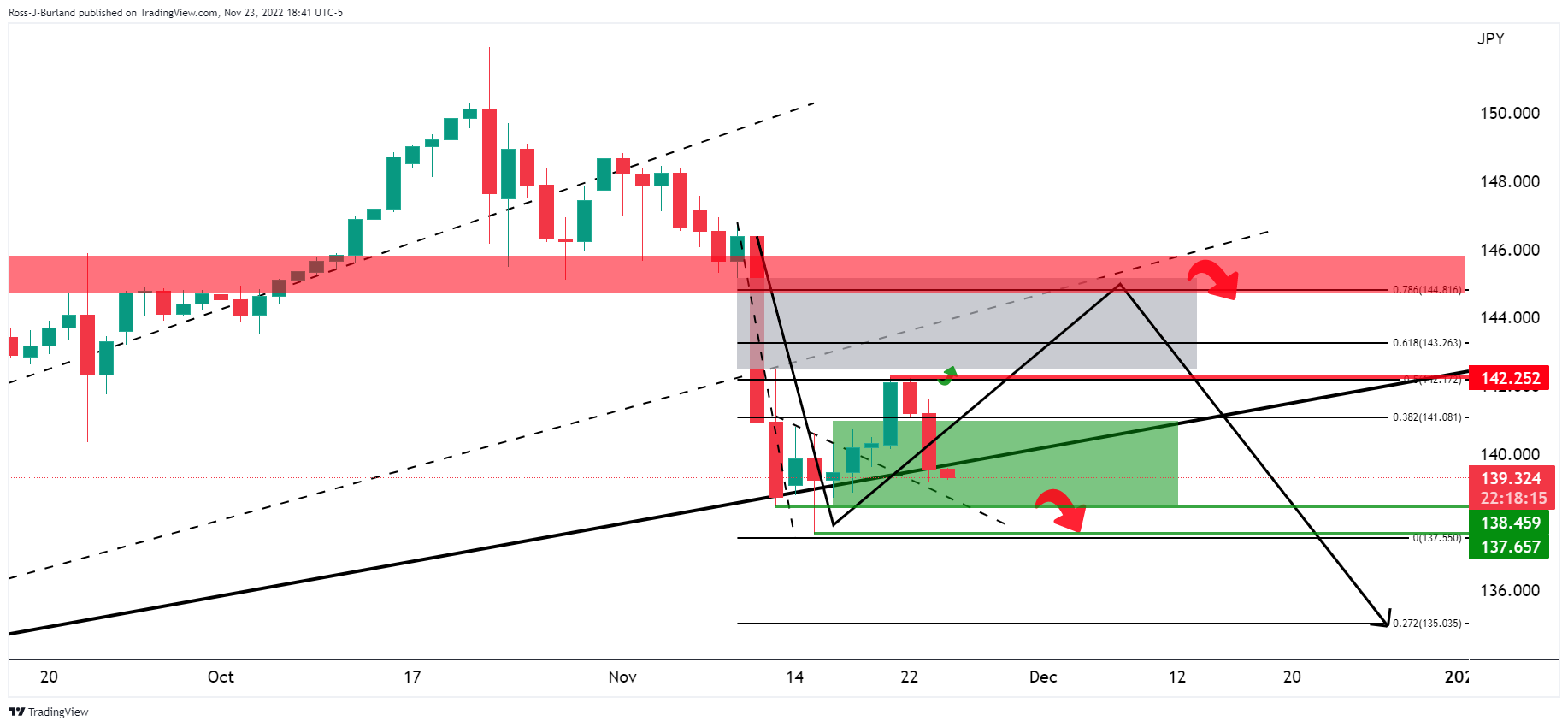
The price is trading between 138.50 and the wick to 137.65 on the downside and 142.25 on the upside.
While downbeat prints of the US PMIs for November and the Federal Open Market Committee (FOMC) Meeting Minutes were mostly highlighted for the US dollar’s latest weakness, softer prints of the US inflation expectations could also be cited as a USD-negative catalyst.
That said, the 10-year and 5-year breakeven inflation rates per the St. Louis Federal Reserve (FRED) data, known as the key precursors for the US inflation, eased from the weekly top to 2.32% and 2.33% in their latest readings. In doing so, the inflation expectations fade the early week’s bounce off the lower levels since the initial September.
It’s worth noting that the Fed policymakers’ discussions on the ‘pivot’ level for rates, per the latest FOMC Minutes, gain additional support from the inflation expectations and can keep the US Dollar bears hopeful despite the recent inaction.
Hence, the Greenback’s weakness is likely to persist even if the Thanksgiving holiday and light calendar join the Covid woes to allow the USD bears to take a breather.
Also read: Forex Today: US Federal Reserve ready to pivot, US Dollar sunk
© 2000-2025. All rights reserved.
This site is managed by Teletrade D.J. LLC 2351 LLC 2022 (Euro House, Richmond Hill Road, Kingstown, VC0100, St. Vincent and the Grenadines).
The information on this website is for informational purposes only and does not constitute any investment advice.
The company does not serve or provide services to customers who are residents of the US, Canada, Iran, The Democratic People's Republic of Korea, Yemen and FATF blacklisted countries.
Making transactions on financial markets with marginal financial instruments opens up wide possibilities and allows investors who are willing to take risks to earn high profits, carrying a potentially high risk of losses at the same time. Therefore you should responsibly approach the issue of choosing the appropriate investment strategy, taking the available resources into account, before starting trading.
Use of the information: full or partial use of materials from this website must always be referenced to TeleTrade as the source of information. Use of the materials on the Internet must be accompanied by a hyperlink to teletrade.org. Automatic import of materials and information from this website is prohibited.
Please contact our PR department if you have any questions or need assistance at pr@teletrade.global.
